Norway coastal cruise: Havila Voyages review
Some links in this post are affiliate links, which means I earn a small commission if you book through them, at no extra cost to you. This support helps keep this site running, the suitcase wheels spinning, and lets me keep writing ultra-detailed travel guides that are free for you to use to plan your next adventure.
Considering a cruise on the iconic Norwegian coastal express route? Here’s a full Havila Voyages review of my Norway coastal cruise on one of the most eco-friendly ships in the world.
As quite a vocal critic of traditional cruise ships (that’s a rant for another day…), my friends and family were all surprised when I told them I was setting sail on an 11 day voyage up and down the famous Norwegian Coastal Route.
But the journey I was going on was far from a typical cruise experience.
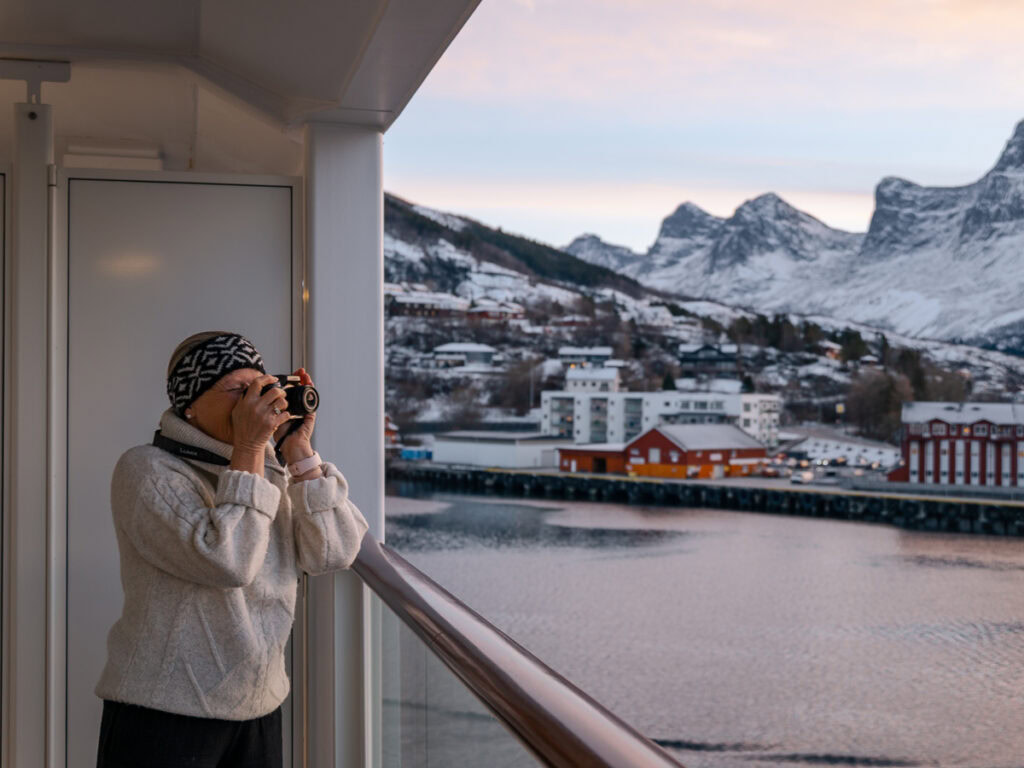
Havila Voyages is a Norwegian-owned and operated cruise company with four of the most eco-friendly ships in the world, with giant battery packs allowing for hours of silent, zero-emission sailing through pristine UNESCO-listed fjords. And better yet, they’ve been future-proofed to be able to run on hydrogen for total emissions-free sailing by 2030.
Instead of cramming thousands of passengers onto a floating shopping mall and spewing them into Europe’s busiest tourist cities, Havila’s intimate ships carry just 640 passengers along an iconic route that’s been a lifeline for remote coastal communities since 1893, and an essential part of any Norway itinerary.
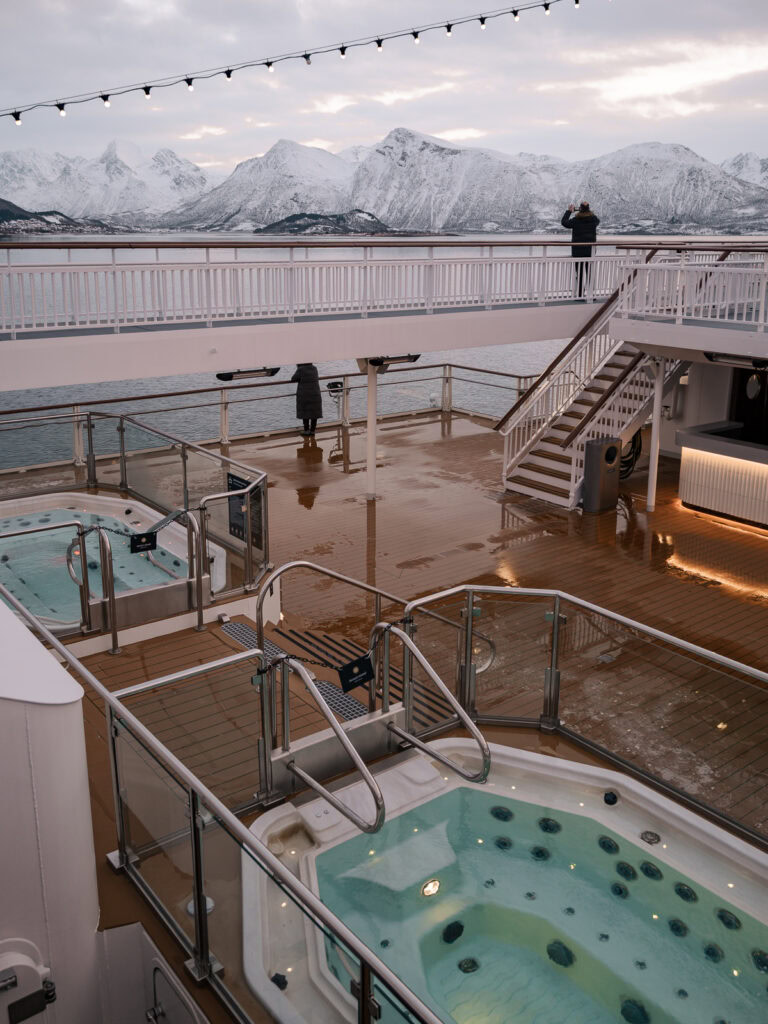
Their ethos is all about balancing environmental protection, supporting locals, and showing visitors the best Norway has to offer. Sounds like my kind of cruise!
I booked a cabin on the Norway coastal cruise with Havila Voyages, sailing across the Arctic Circle and around the northernmost point of mainland Europe, past tiny fishing villages and mighty mountains. I even managed to convince my parents to ditch New Zealand summer to join me in sub-zero temperatures and minimal daylight, hoping to help them tick the Northern Lights off their bucket lists 🤞🏼 so the big question is, was it worth it?
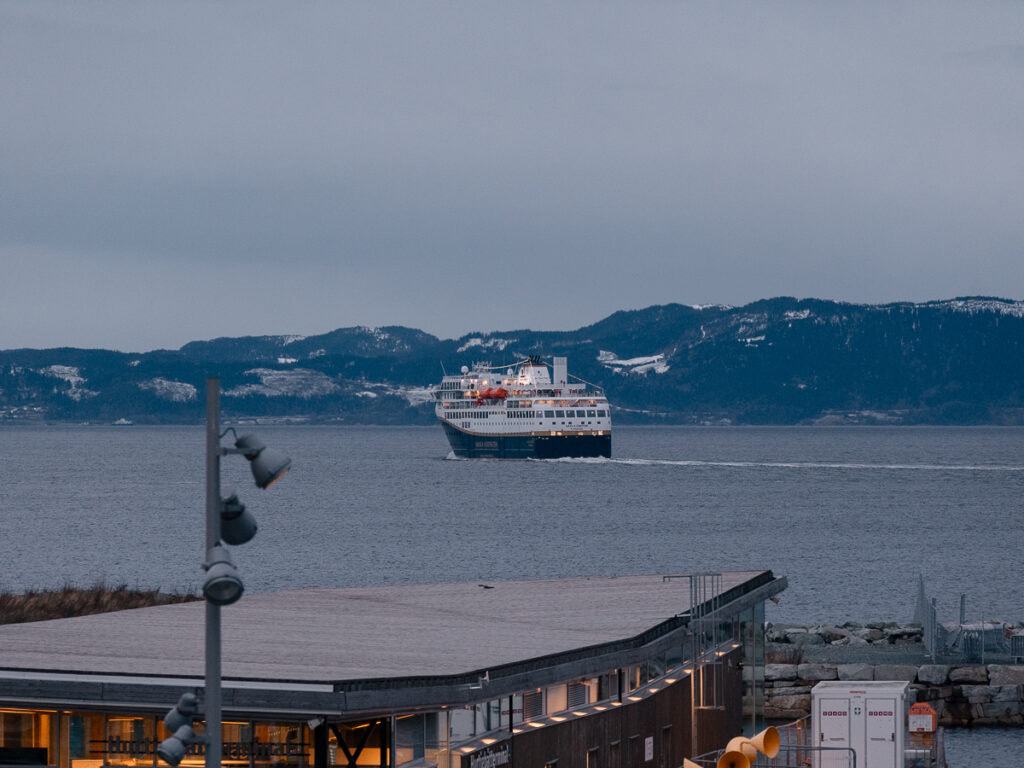
If you’re considering splashing out on this epic adventure, if you’re trying to decide between Havila or a traditional cruise line, or if you’re just curious about what it’s like to sail through Arctic waters in late November, I’ve got you covered.
This detailed and honest Havila review includes all the info you need to know before you book, from cabin types to worthwhile excursions to trip highlights (baby huskies!!!), plus a day-by-day breakdown so you know exactly what to expect.
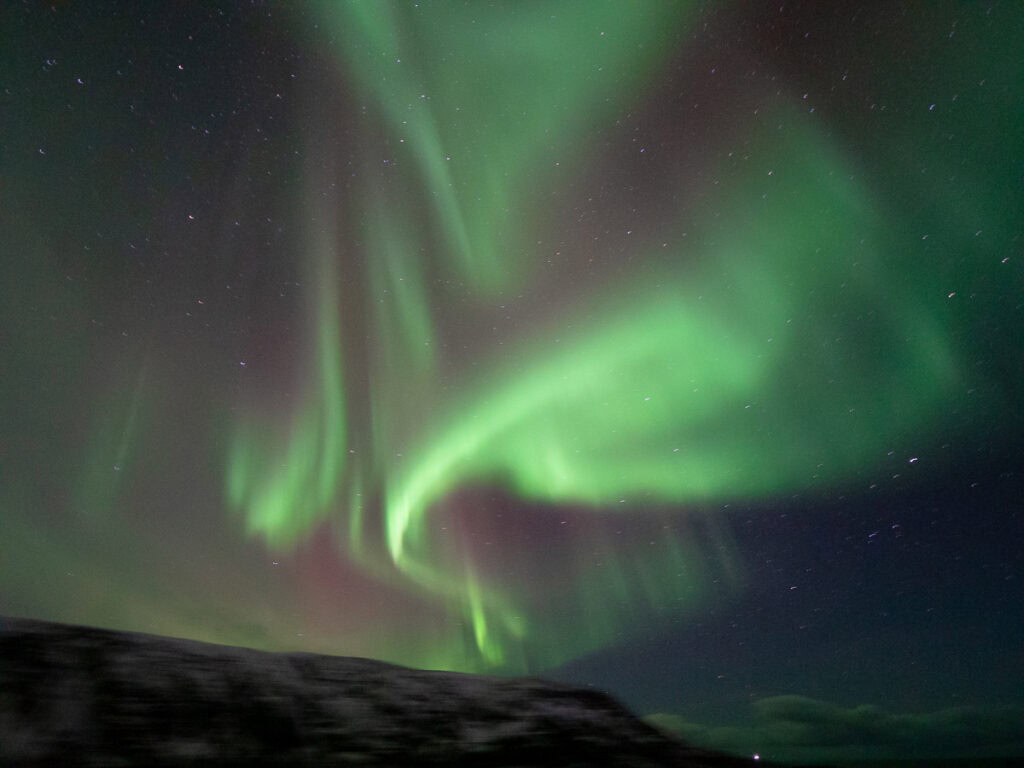
Disclosure: Havila Voyages kindly hosted me for this trip, but they have no editorial control over my content and none of my content needs their sign off before posting. As always, all opinions are my own and are based on my honest experience.

About Havila Voyages
Havila Voyages is a part of the Havila Group, a Norwegian shipping company that’s been family-owned and operated since the founder bought his first fishing boat at age 16 in 1957.
Over nearly seven decades, Havila has grown from that single vessel to a major player in Norway’s coastal transport and tourism.
They now operate up and down the Coastal Express route to transport cargo and local passengers between isolated communities in remote regions and, since 2021, offer tourists the chance to come along for the ride, all on some of the most eco-friendly ships in the world.
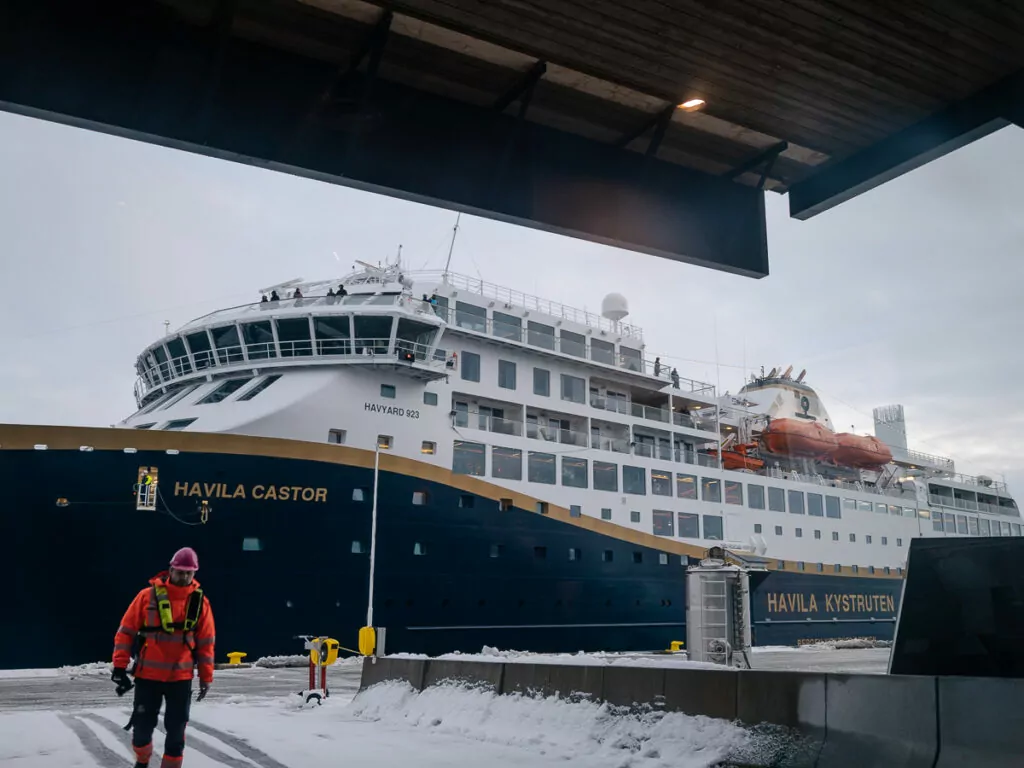
Havila Voyages & sustainable cruising
Supporting local businesses like Havila is a huge part of responsible tourism, not just because it reduces economic leakage, but also because they actually have skin in the game.
Is a multinational cruise empire like Carnival or Royal Caribbean going to care about polluting fjords or overwhelming remote towns with thousands of tourists? Not when they’re making a tonne of money doing it.
But with Havila, protecting the places they visit is baked into their ethos. As founder Per Sævik puts it, “We are sailing in the world heritage, so should the generations to come.” Their commitment to sustainability isn’t just greenwashing (*checks notes* like pretty much every other cruise company in the world 🙃), and they’re not only walking the talk, they’re building the path for others to follow.
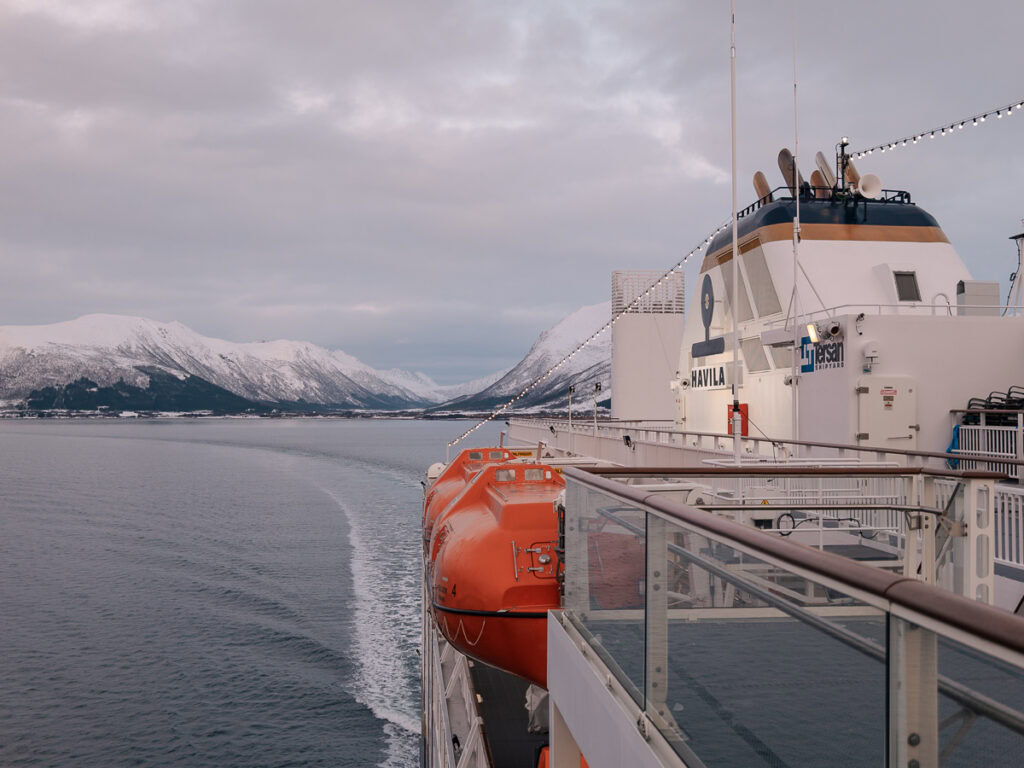
Havila is leading the global shipping and tourism industries when it comes to environmentally-friendly ships.
They use the largest battery packs ever installed on a passenger vessel, letting them sail silently and completely emission-free for up to four hours at a time.
They use this mode in the most sensitive areas, like UNESCO-listed fjords and near small, isolated communities who depend on clean air and water. No engine noise, no smoky exhaust, and no impact on the pristine environment. Just stillness and silence, except for the occasional “ooh” and “ahh” from fellow passengers soaking up the magical moment alongside me.
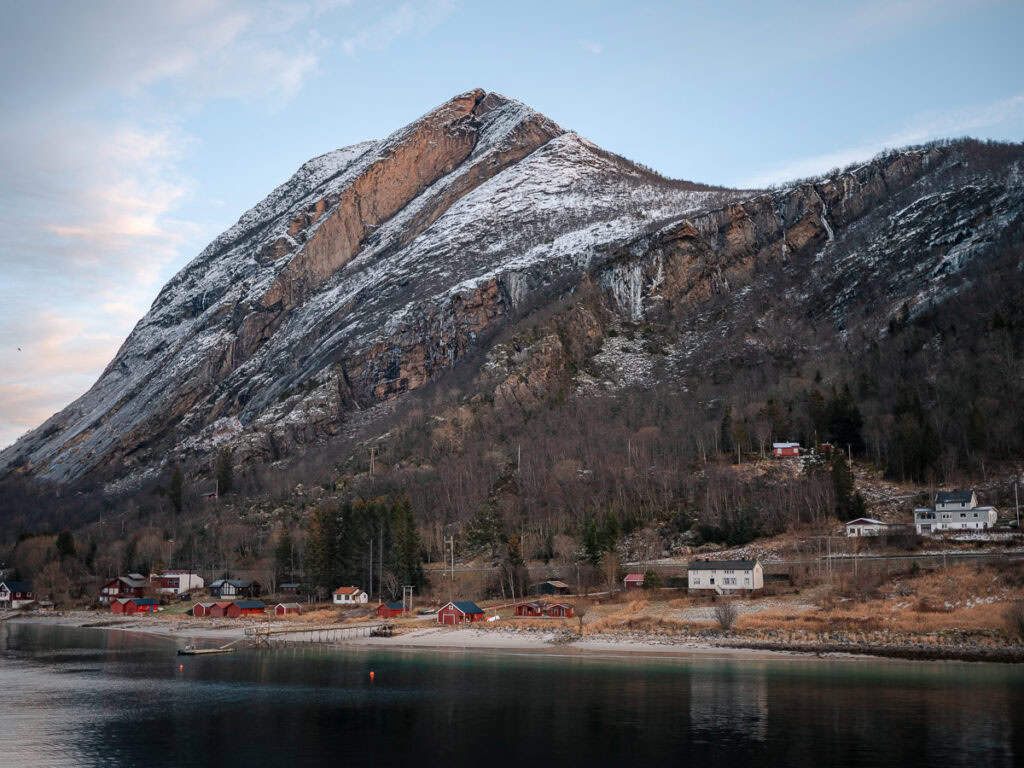
They made history in 2022 with their first zero-emissions voyage into the World Heritage-listed Geirangerfjord, one of Norway’s most significant natural sites, and they’re on track for their vessel operations to be climate-neutral by 2028 and completely emission-free by 2030. EMISSION-FREE by 2030! That’s FIVE years away!
What do those terms mean exactly?
- Net zero = balancing the amount of greenhouse gases emitted with emissions removed, so companies might still have emissions but they can offset them through various projects (like planting trees or using carbon capture technology)
- Climate-neutral = often used interchangeably with net zero, but climate-neutral might also include indirect emissions like supply chain emissions or might go beyond greenhouse gases and look at other climate impacts
- Emissions-free = no emissions whatsoever. This requires battery power or no-emissions fuels like hydrogen, and has never been done before on passenger ships of this size.
If this stuff is new to you, it’s hard to overstate how big of a deal this is.

Cruise giants like Royal Caribbean, Carnival and Norwegian (which hasn’t been Norwegian-owned for decades by the way) are amongst the worst environmental offenders in the tourism industry. They’ve finally all “committed” to net zero… But not until 2050 🙃 25 more years for them to be ferrying thousands of passengers on floating theme parks that pollute the air, the sea, and the cities they visit. Ick.
Net zero means they offset the emissions they omit, so it doesn’t even mean they’ll necessarily do anything to reduce the emissions in the first place, they’ll probably just put their prices up so customers plant more trees per booking and then call that a success.
The steps that Havila Voyages has already taken and the goals they’ve already reached are *decades* ahead of the bigger, richer cruise companies that own the market, and it genuinely gives me hope for the future of cruising.

About the Norwegian Coastal Express
Norwegian Coastal Express vs. Kystruten vs. Hurtigruten
Let me clear something up first because this really confused me, there are multiple names for the route that Havila ships sail on. You might see it being referred to as the:
- Norwegian Coastal Express
- Norwegian Coastal Route
- Norwegian Coastal Line
- Kystruten (‘The Coastal Route’ in Norwegian)
- Kystruten Bergen – Kirkenes
- Havila Round Voyage
- Hurtigruten
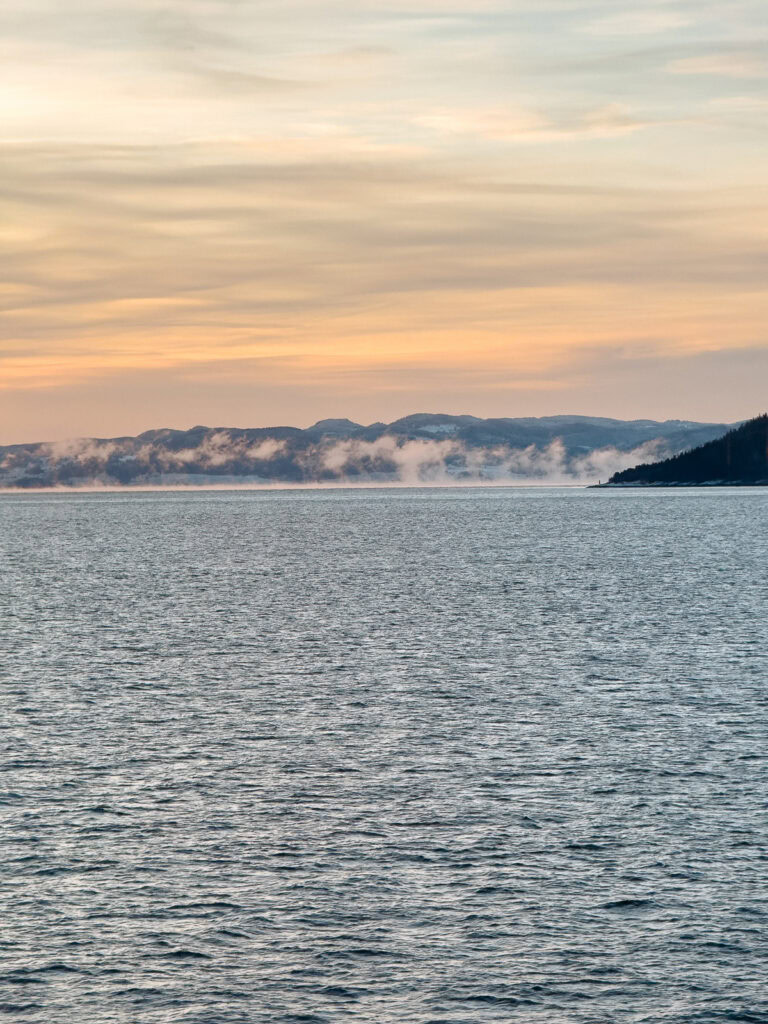
These all refer to pretty much the same thing, except for Hurtigruten.
Hurtigruten is the name of the original company that started sailing the Coastal Route back in 1893, and they still operate on the route, following the exact same path as the Havila ships but on alternate days.
The name ‘Hurtigruten’ is well-recognised all around Norway and its tourism industry, but it’s now synonymous with the route itself rather than just the company. If people say ‘we’re taking the Hurtigruten’ then they might mean they’re taking an actual Hurtigruten ship, but they also might mean they’re taking a Havila ship along the Coastal Route!
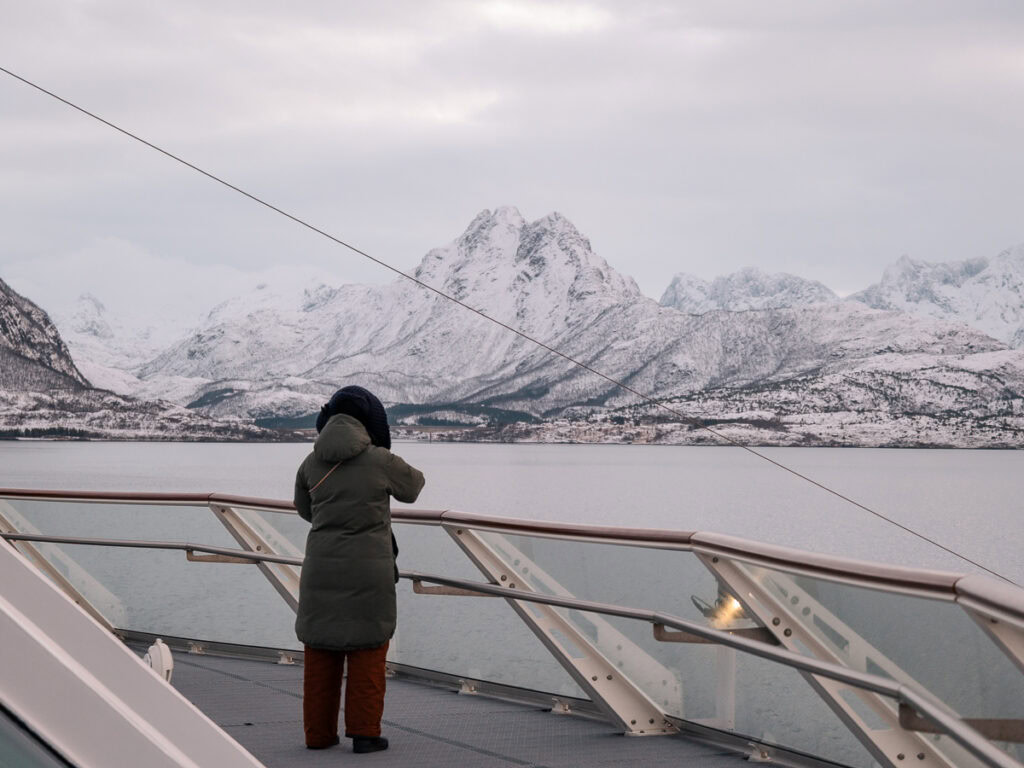
History of the Coastal Express
Covering more than 2500 nautical miles from Bergen all the way up to Kirkenes with 32 stops in between, and with more than 130 years of history, the Norwegian Coastal Express is one of the most iconic sailing voyages on the planet. Services run every day, all year round, with Havila and Hurtigruten sharing the route.
It was originally established (and still operates) as a vital part of Norwegian infrastructure, a lifeline for remote villages and coastal communities, especially when long and harsh winters threaten already limited road connections.

It might seem like the Coastal Express was perfectly planned with tourists in mind, giving visitors to Norway easy access to spectacularly diverse scenery from the untouched fjords in the west to the harsh Arctic North and everything in between, but tourists are actually a more recent addition to the experience.
These days, keen travellers share the Havila and Hurtigruten ships with domestic passengers, cargo and mail, and the itinerary is the way it is because of the ships’ logistical responsibilities. That’s why there might be a 20 minute stop at a small port town at 3am, it’s not to give you a taste of Arctic nightlife, it’s to make sure the locals get their Amazon packages!
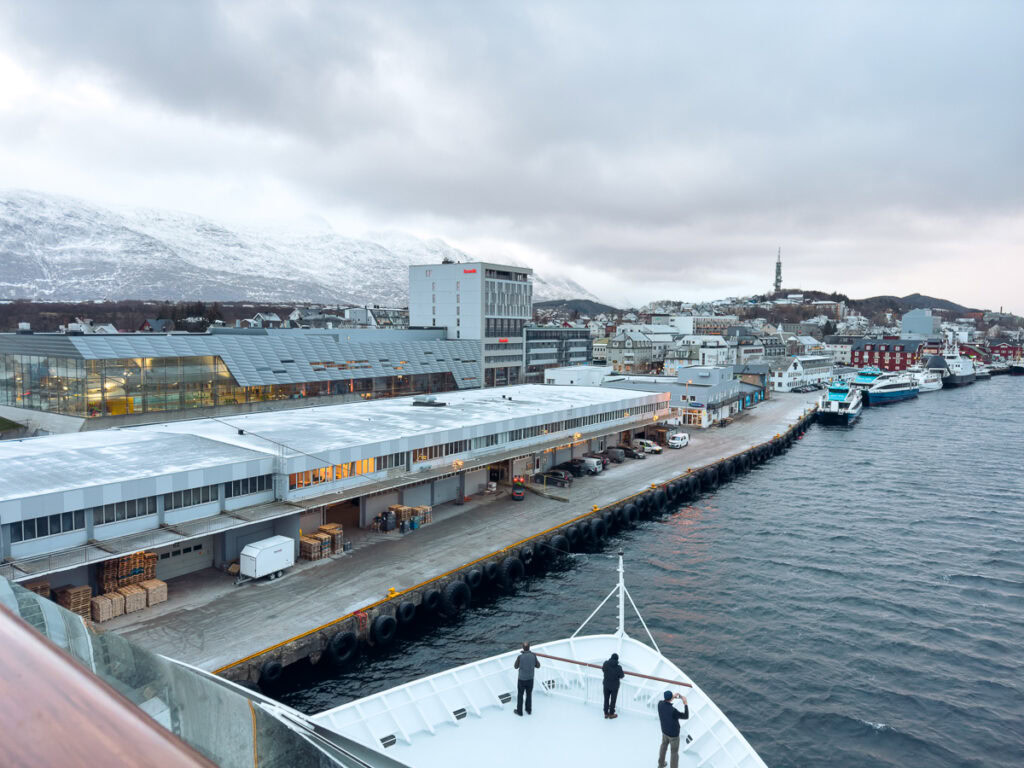
A detailed review of my Norway coastal cruise with Havila Voyages
Getting to the ship
You can jump on the Havila ships at any of the 34 ports along the route but most people will start at the southernmost point of the journey, Bergen, or the very top of the journey, Kirkenes. We began our trip in Bergen.
You can find cheap flights to Bergen from many places around Europe, I’d recommend flying in the day before if you can (just in case of any flight delays) but if that’s not an option then just make sure you leave enough time to reach the ship well before the final check in time of 8.15pm (departure time from Bergen is 8.30pm).

If you’re flying long-haul from outside of Europe then you’ll probably arrive into Oslo, from there you could catch a short domestic flight to Bergen but I’d highly, highly suggest taking the overland option and catching the train along the spectacular Bergen Railway route.
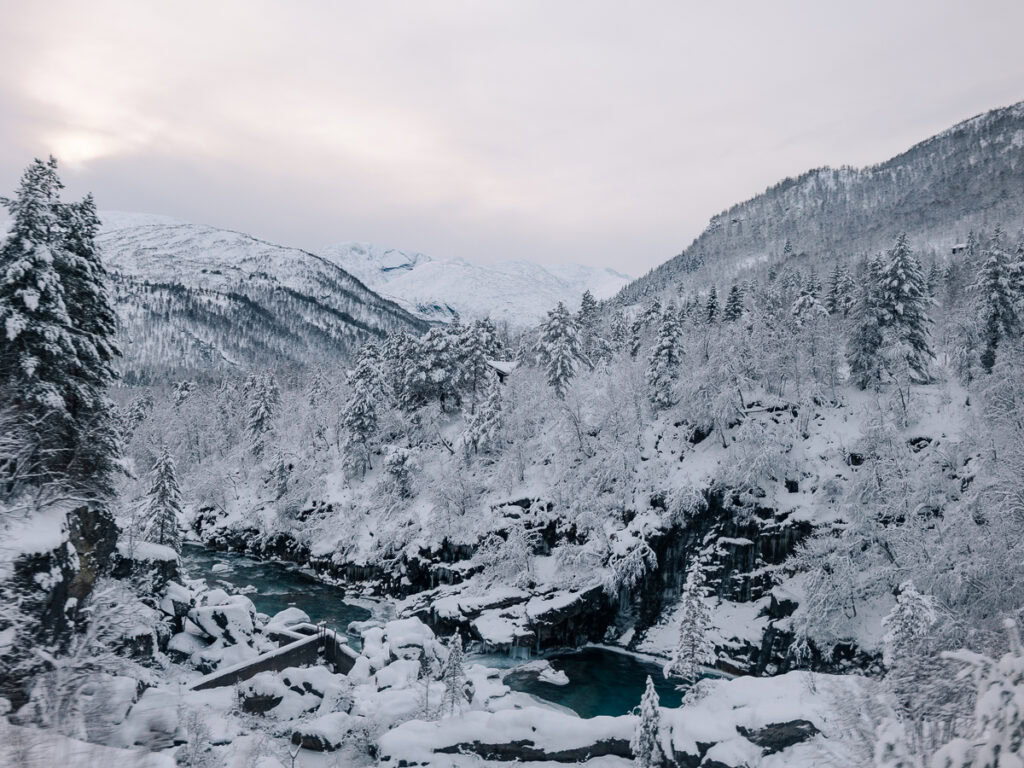

Oslo to Bergen has direct trains a few times a day, I met my parents the night before so we had leeway with any travel delays, then we caught the 8.25am departure the next morning to arrive in Bergen at 2.59pm with plenty of time to get to the ferry terminal, drop our bags and go exploring.
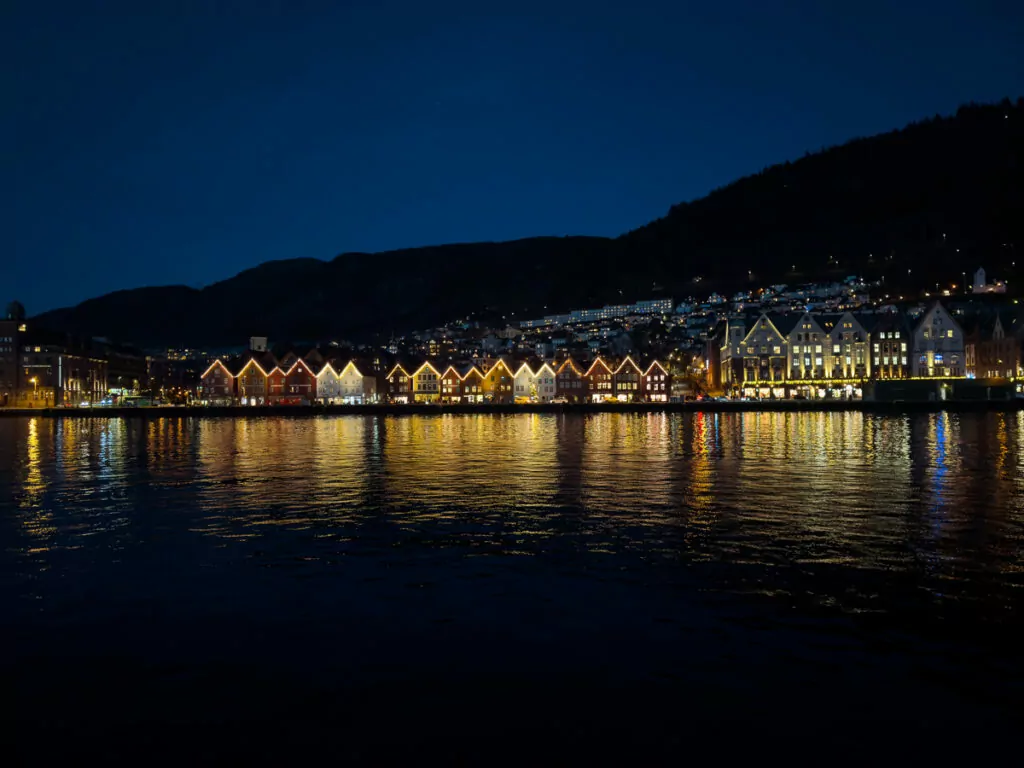
If you’ve got a few days pre-tour then another bucket list experience in Norway is the super scenic Flam Railway, technically you can do this in one day from Oslo to Bergen but for a more relaxing journey you should consider spending a night in Flam to break up the trip. You can find all the info about that option in my four day Norway itinerary.
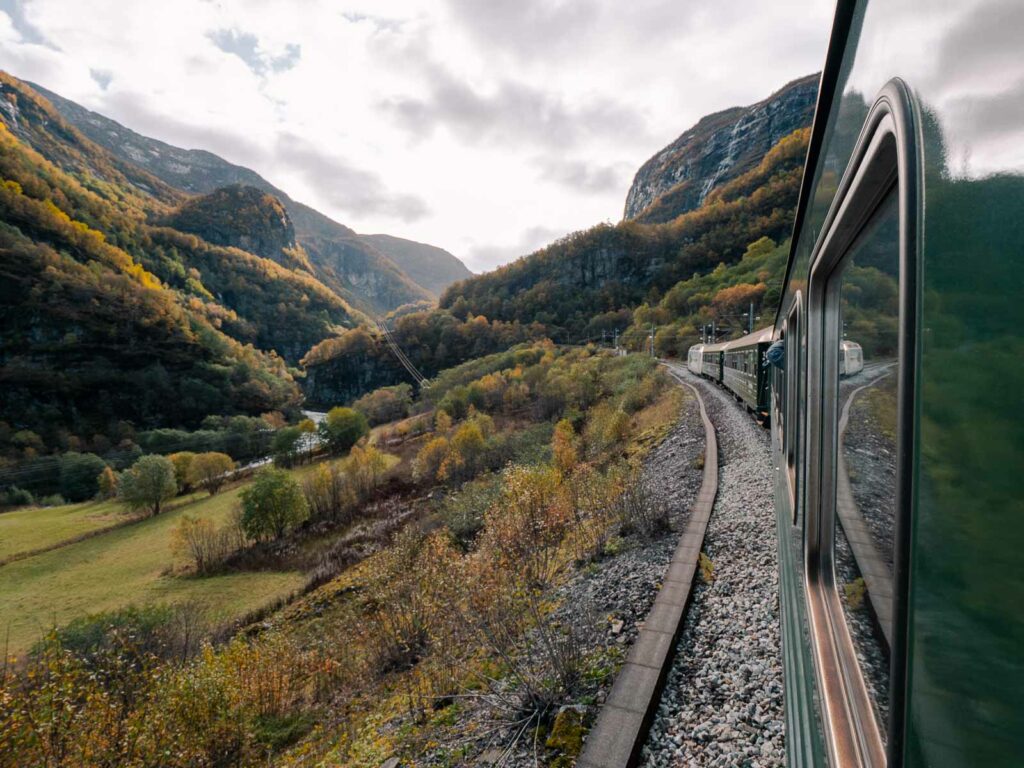
From Bergen train station it’s about 25 minutes to walk to the ferry terminal, but with mid-November weather and heavy suitcases we opted for an expensive but worthwhile 10 minute taxi.
Checking in to the Norway coastal cruise
Unfortunately the start of our Havila Voyage was actually a negative first impression, the check in area and process was a nightmare 🫠 I promise the cruise gets much better after this, but I want to share my honest personal experience.
(Keep in mind that I haven’t been on a cruise before so I don’t have anything to compare it to, maybe all cruises are like this!)
Check in begins at 3.30pm, boarding starts at 4pm. We arrived at 3.45pm to a huge line snaking around the inside of the terminal, badly laid out as the main line went right across the entrance way, so people had to push through the middle of the line to get to the back and then push through again to reach the escalators to get to the ship.
Everyone was in bulky winter gear with big suitcases, there were minimal seats available for elderly or tired passengers, I have no idea why they didn’t rearrange the line to go down the far side of the terminal so the entranceway and escalators weren’t dangerously crowded.
There were no staff members managing the growing line, just the people at the front desks. If they’d had a floating staff member trying to sort out the chaos it might have been a much smoother experience.
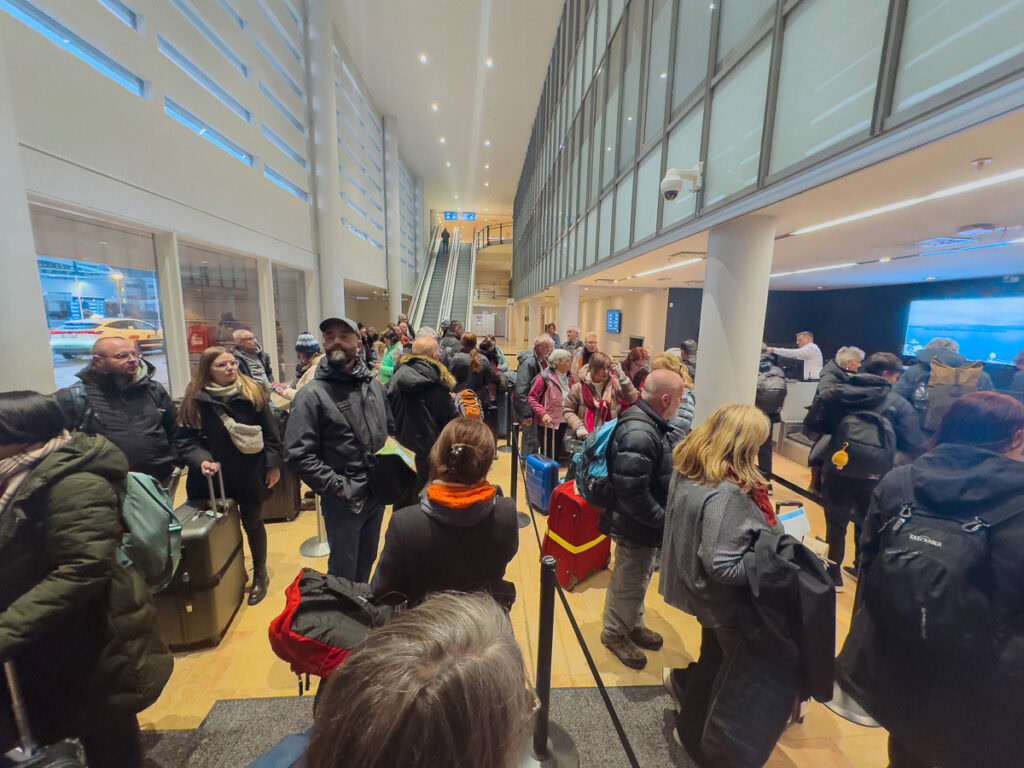
The issues with the entranceway being blocked came to a head when one passenger was clearly annoyed at the difficulty of reaching the doors, she got a bit bolshy and pushed past another passenger, who lost her balance and tripped over her bag, smashing into the floor with quite a bang. The passenger who pushed her just put her hands up as if to say “wasn’t me” and walked out the door, everyone gasped and looked at the lady who fell, but no passengers helped her and no staff members came to ask if she was okay (and there’s no way they wouldn’t have noticed the commotion).
We were about 10 people behind in the line so I couldn’t get to her but I noticed she was travelling alone, and as a fellow solo traveller I felt so, so sorry for her. I managed to catch up with her once the line progressed a little and I checked in to see if she was okay, she said she was fine but just got a fright and didn’t realise she was in the way, I reassured her that it was absolutely not her fault (it was the asshole who pushed her) and she seemed to be a little less embarrassed. Not a good start for her and not a good first impression for me to be honest.
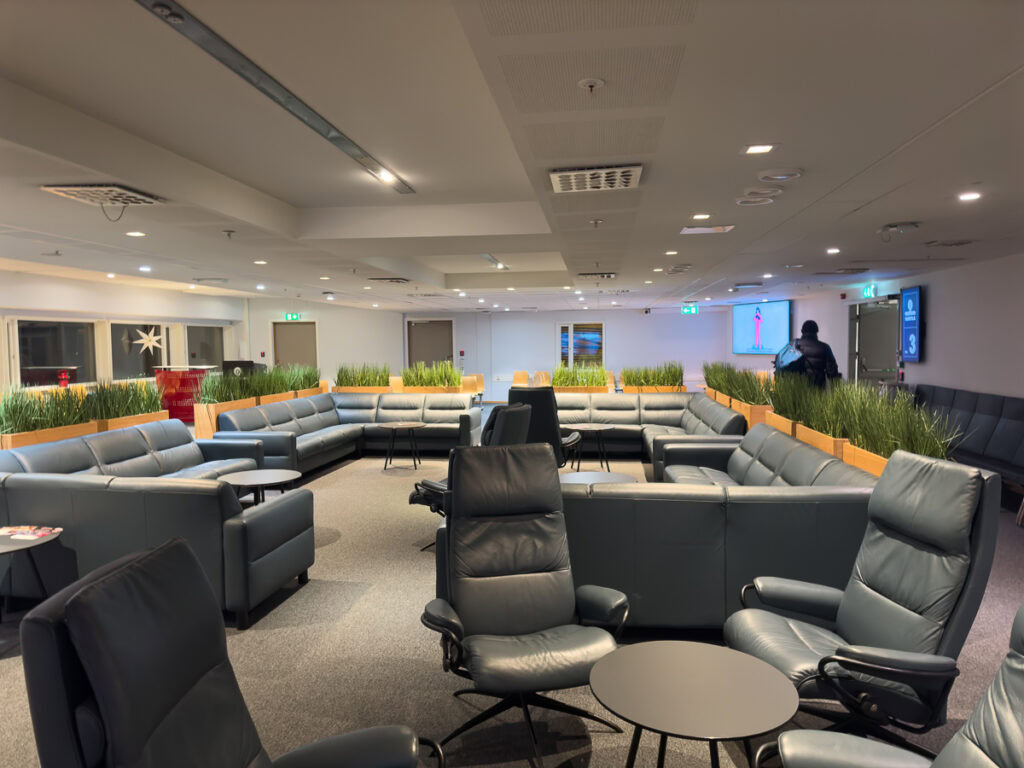
All up it took about 45 minutes for us to get to the check in desks after arriving at the terminal. You need to give them your passport (or ID card for Schengen passengers), a credit card for any onboard charges, they’ll take your big suitcases and get them delivered to your room but you’ll keep any carry on bags.
By this stage it was 4.30pm and the boat was ready to board, but rooms wouldn’t be ready until 6pm. I wasn’t aware that this was the case until that moment, I’m not sure if this info was provided in a welcome email of some sort or in the Havila customer portal because I was never able to access this even after emailing customer service multiple times 🙃
My parents were keen to explore Bergen for a bit so instead we stored our bags in the luggage lockers at the terminal, we paid around €7 for a medium locker that could fit my camera backpack and my mum’s handbag.
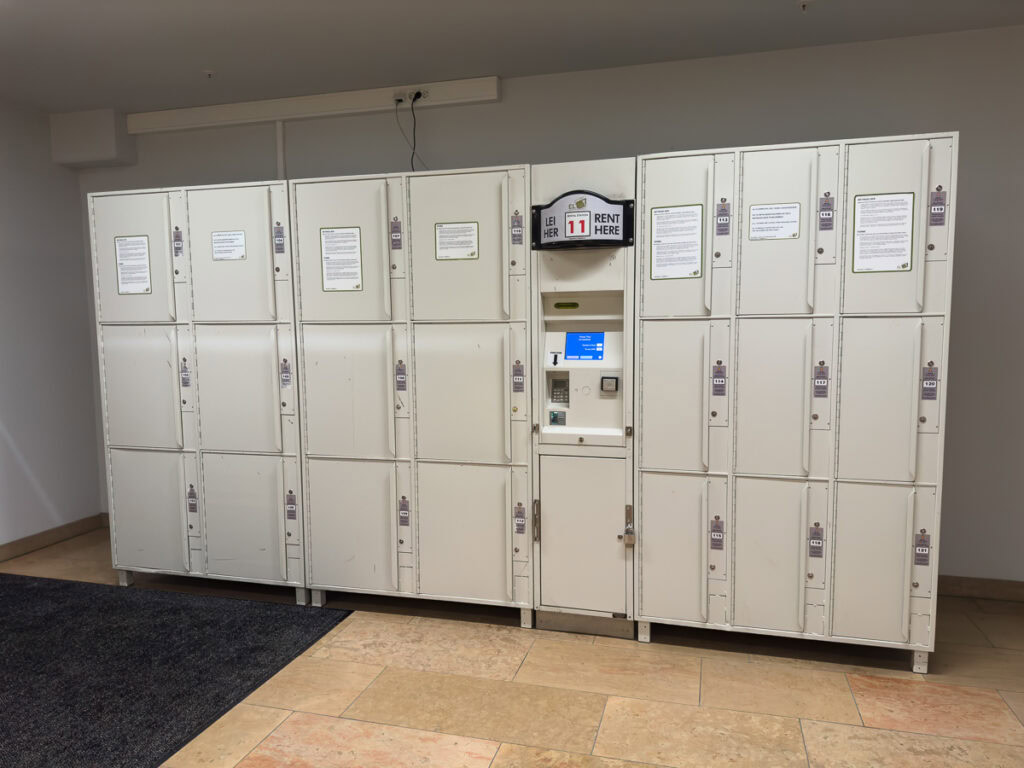
Arriving onto the boat
After about an hour and a half of wandering around Bergen, including time for a supermarket shop to get snacks, we headed back to the boat at 6.10pm to settle in to our rooms.
From the check in desks we took the elevators up to the boarding lounge which was actually really nice, lots of comfortable seating, but there was no need for us to stop as the boat was ready and waiting. Except that my room wasn’t ready yet! I was in a Seaview Superior room on the bottom floor which obviously gets cleaned last so housekeeping had them all roped off for a little longer.
My parents’ suite was ready though so I headed up with them to take the photos and videos I needed, and at 6.30pm I was told that the final cabins were now ready for check in.
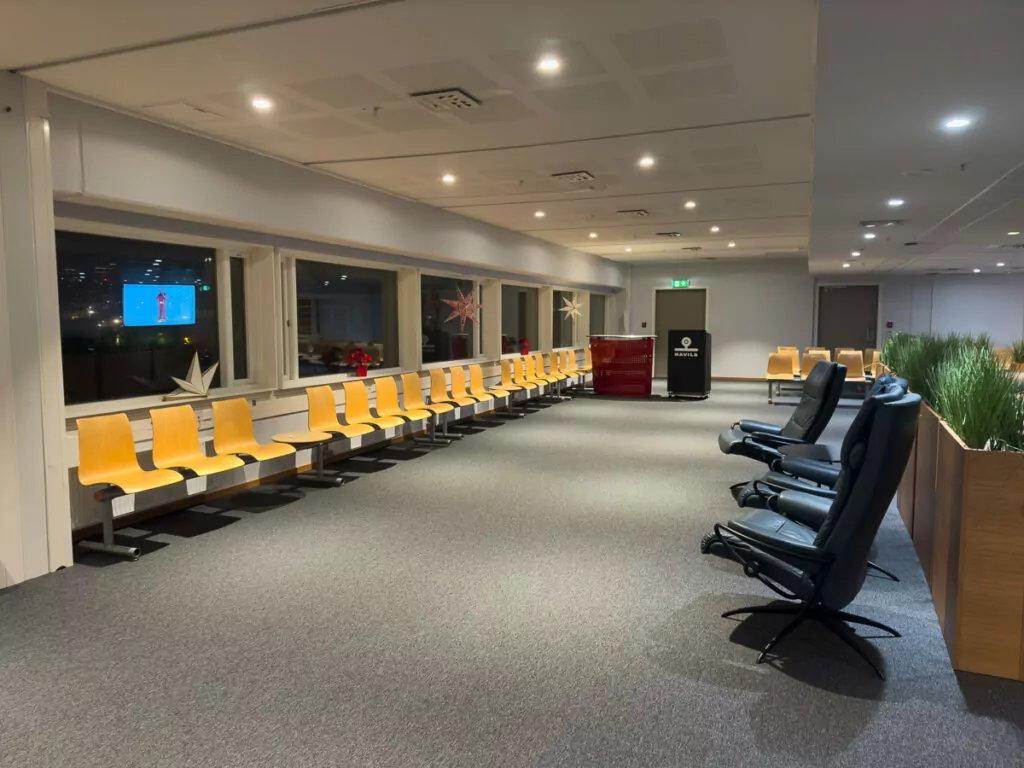
Our ship: The Havila Castor
Havila has four pretty much identical ships: Capella, Castor, Polaris and Pollux. All ships are 124m long with 179 cabins and a total capacity of 640 passengers, built from 2021 to 2023. Our ship, Havila Castor, was built in 2022.
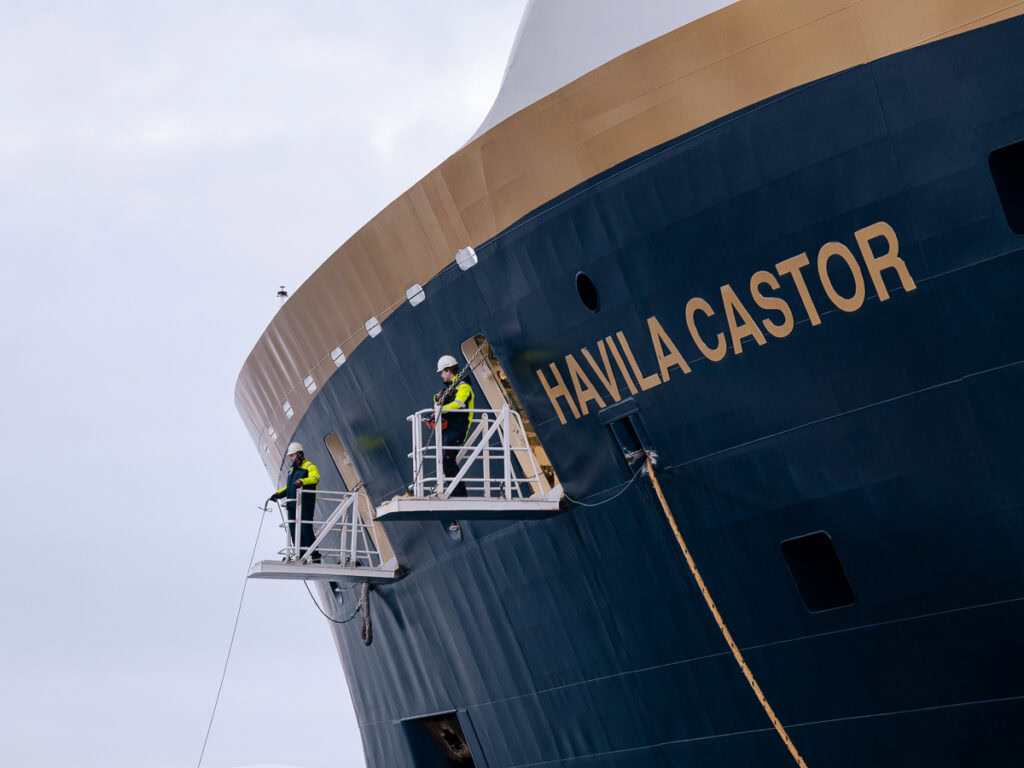
Sustainability features
The Havila ships have been built with environmental-friendliness in mind, and they’re very, very different to the mega cruise ships you see parked up in Dubrovnik and Barcelona carrying 5000 passengers and spewing out smoke into the air. Gross.
Havila’s vessels all feature:
- Energy-efficient hulls built to withstand harsh weather conditions
- The largest battery packs on any passenger ship in the world (86 tons 😱), allowing for four hours of silent, zero emissions sailing
- The ability to charge batteries with clean hydropower when docked
- An innovative energy management system that captures excess heat produced by its energy systems and repurposes it for other onboard needs, like heating water for showers
When the ships aren’t running on battery, they use LNG (liquid natural gas) which cuts CO2 by 35% and NOx by 90%. And beyond that, Havila has future-proofed all the energy systems onboard so that the ships can be converted to use hydrogen power when it’s approved for commercial sailing 👏🏼
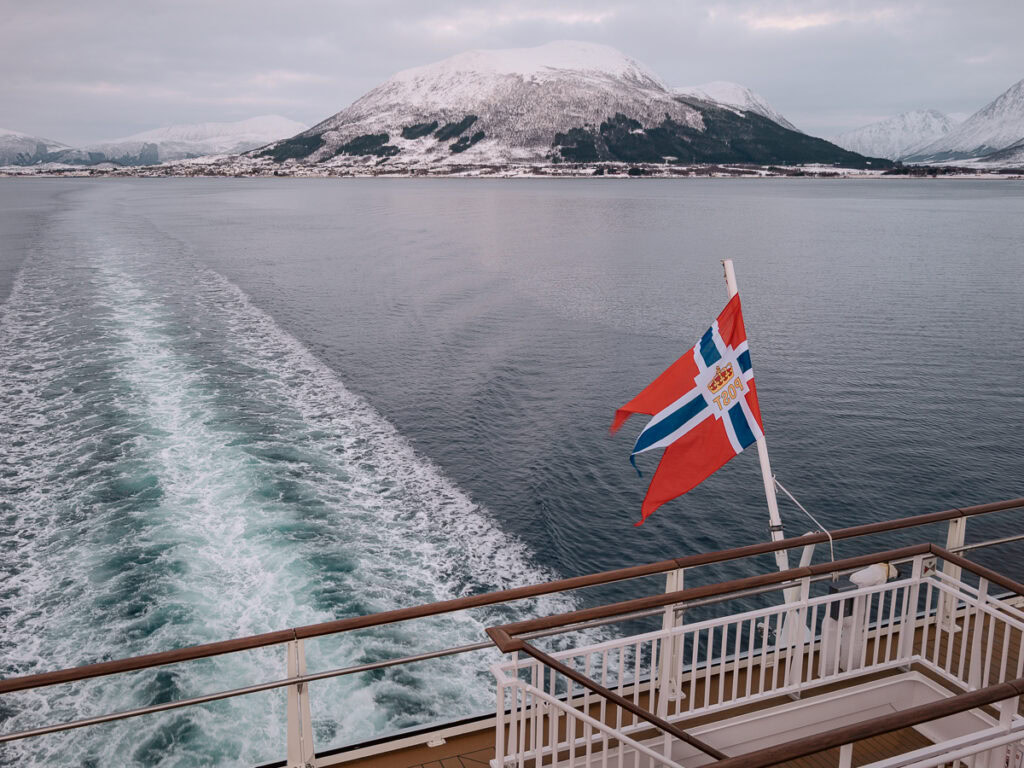
Havila cabins
There are five categories of cabins and two categories of suites on Havila ships:
- Interior cabins are 8-10m² and fit two people in two single bunk-ish beds, with the top berth folding up for more space, plus a small sofa and an en suite bathroom. They’re the smallest but cheapest option!
- Seaview Superior cabins are 15-16m² and can fit 2-4 people, with twin or double beds, a sofa or sofa bed, minifridge, wardrobe, desk, tea/coffee facilities, an en suite bathroom, and a window with sea views.
- Seaview Deluxe cabins are 18-27m² for 2-4 people with a bigger sofa than the Superior, plus a better location on the ship at the front of deck 7 or the stern of deck 5.
- Panoramic Superior and Panoramic Deluxe cabins are 20-22m² for two people with floor-to-ceiling windows on deck 7 facing the direction the ship is sailing in, a literal front row seat to Norway’s coastal highlights! They have a little seating area with a table for maximum relaxation while soaking up the views.
- Balcony Deluxe cabins are 21-25m² for 2-4 people with a double bed, a sofa/sofa bed, and a 6m² balcony.
- Junior Suites with Balcony are 25–28m² for two people, with a 6-9m² balcony, queen bed, swivel TV, recliner, comfy sofa bed, desk, two wardrobes, coffee machine, and additional suite benefits like a welcome package, bathrobe and slippers, priority check in and access to the fine dining restaurant for breakfast and lunch.
- And finally, the Lighthouse Suites are a spacious 48m² with a 15m² private balcony with jacuzzi, an extra-wide bed, a semi-separate lounge area, top quality furnishings and the suite benefits I mentioned above. There are only two of these on each ship and they get booked up well in advance, so book early!
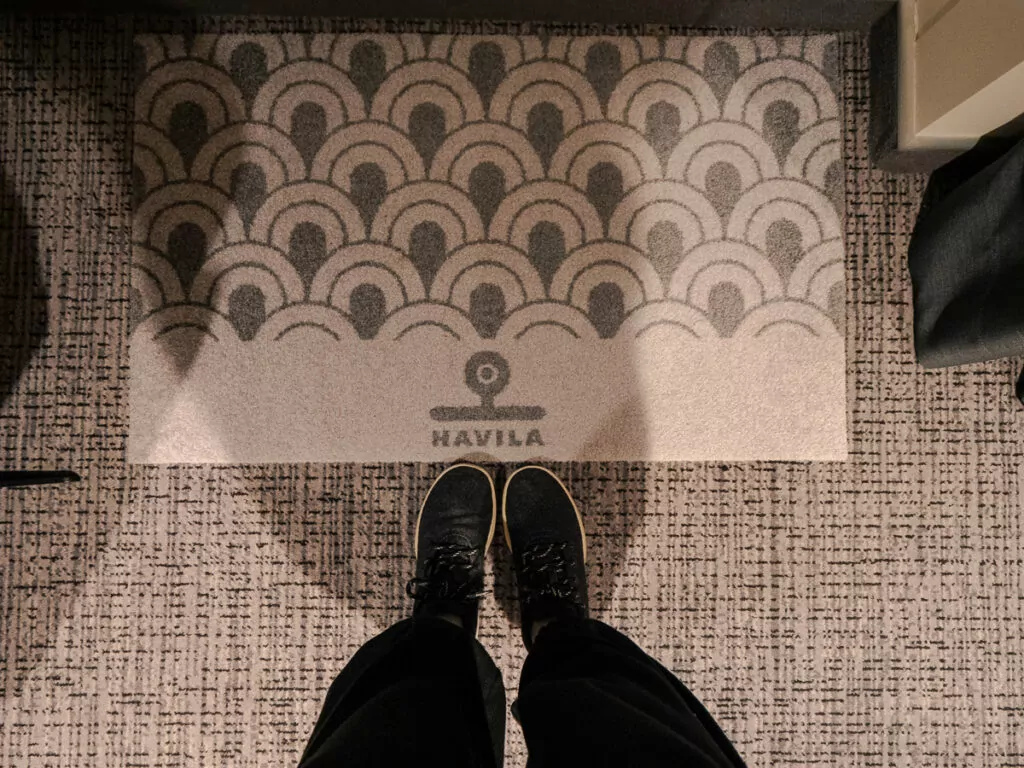
Havila also has accessible rooms available for various categories with more space and accessible bathrooms, these are mainly reserved for guests with mobility needs:
- Interior Accessible cabins are 16-18m² and fit up to four people with two sets of the same bunk-ish single beds
- Seaview Superior Accessible cabins are 21-24m² with a double bed, sofa, wardrobe and a desk in a more accessible layout
- Balcony Accessible cabins are the same as Balcony Deluxe but with larger bathrooms
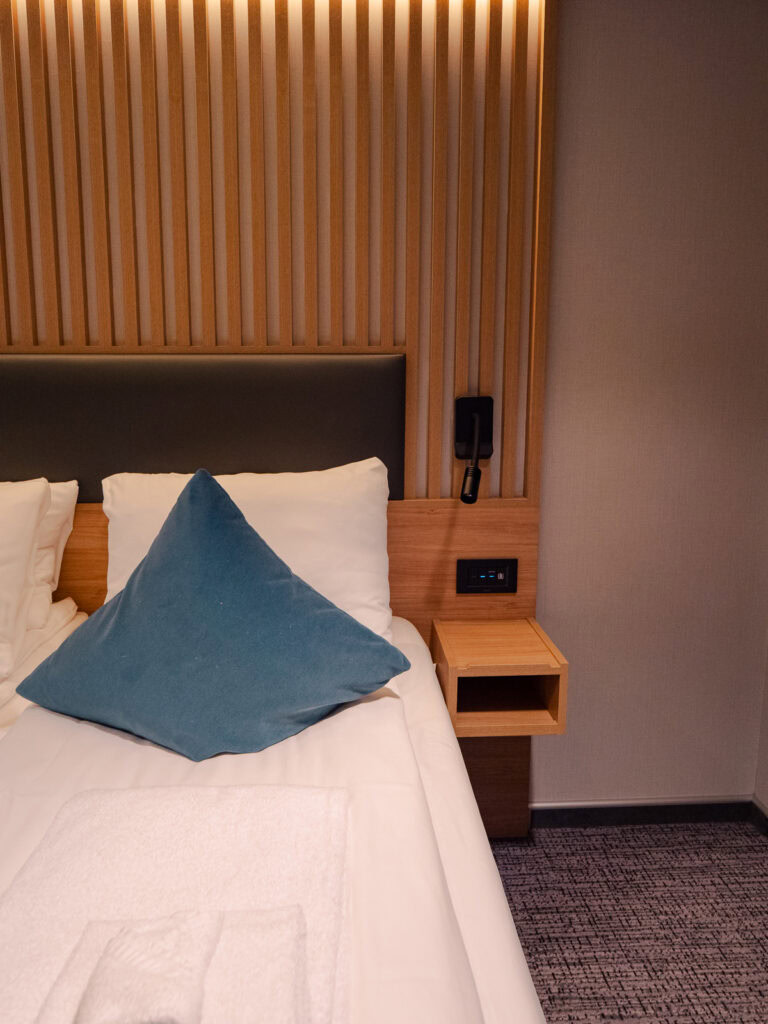
My cabin: Seaview Superior
I stayed in a Seaview Superior cabin, which is the cheapest cabin with a window. I was on deck 4 (the bottom deck) about 2/3 of the way to the back of the ship.
The room was very comfortable with more than enough space for me as a solo traveller. The bed was really comfy, the desk was big enough for me to get work done during the sailing hours, there was a sofa and small table, my suitcase fit perfectly under the sofa when it was open which saved space, and the wardrobe was great for storage. 10/10, exactly what I needed!
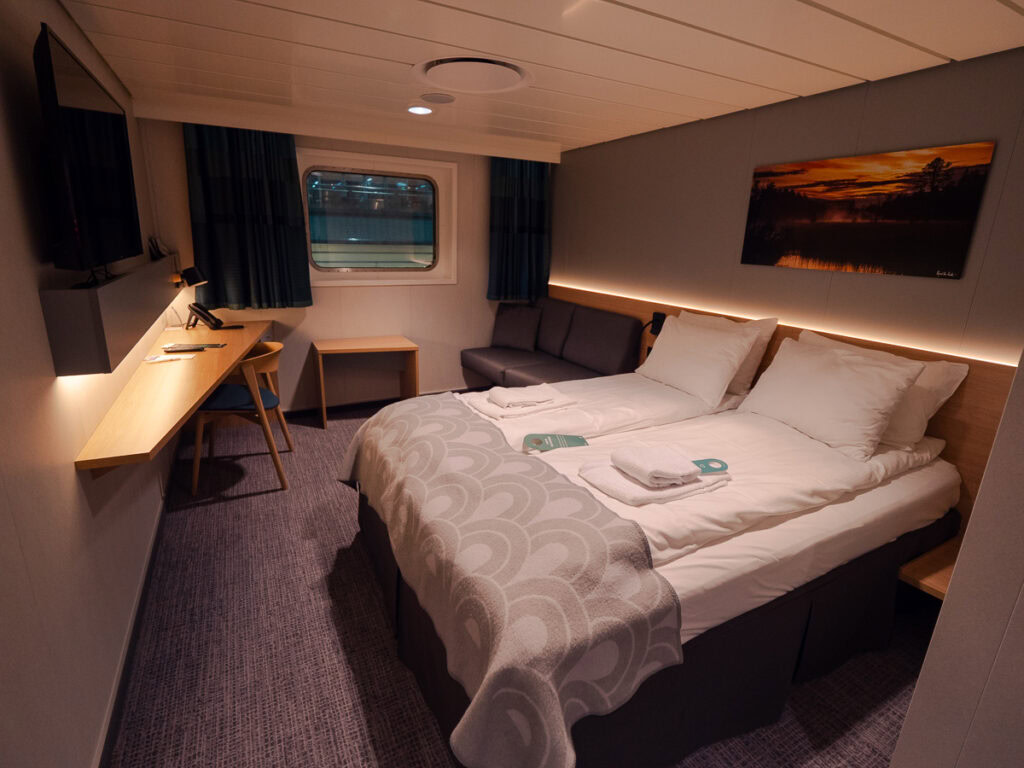
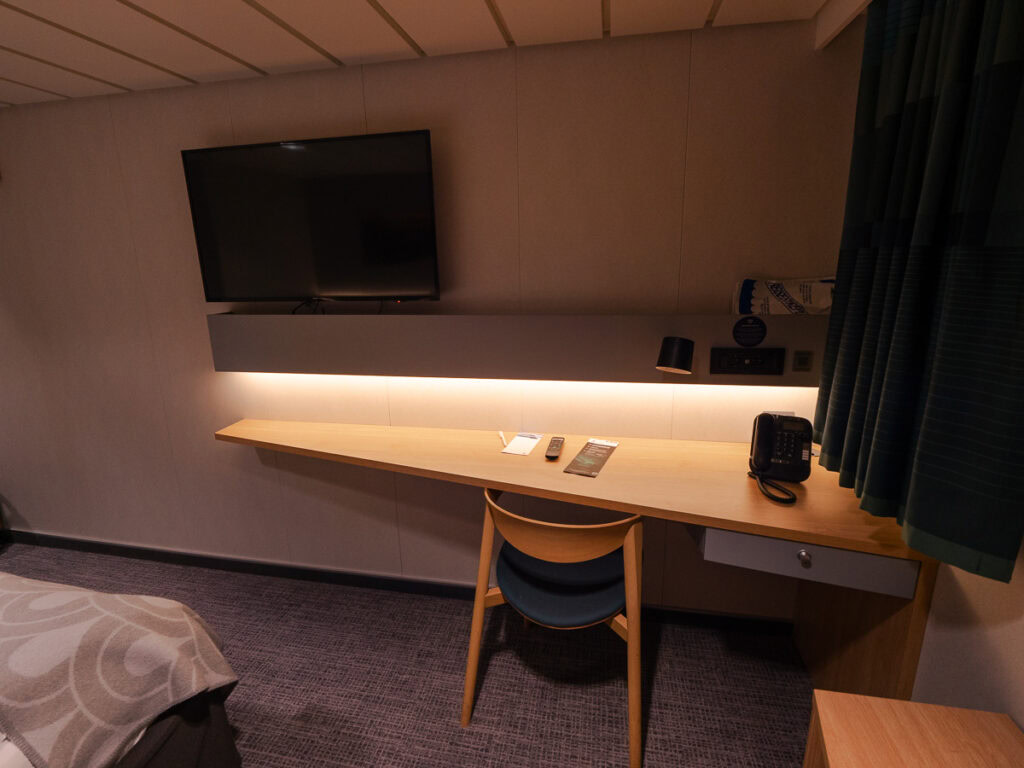
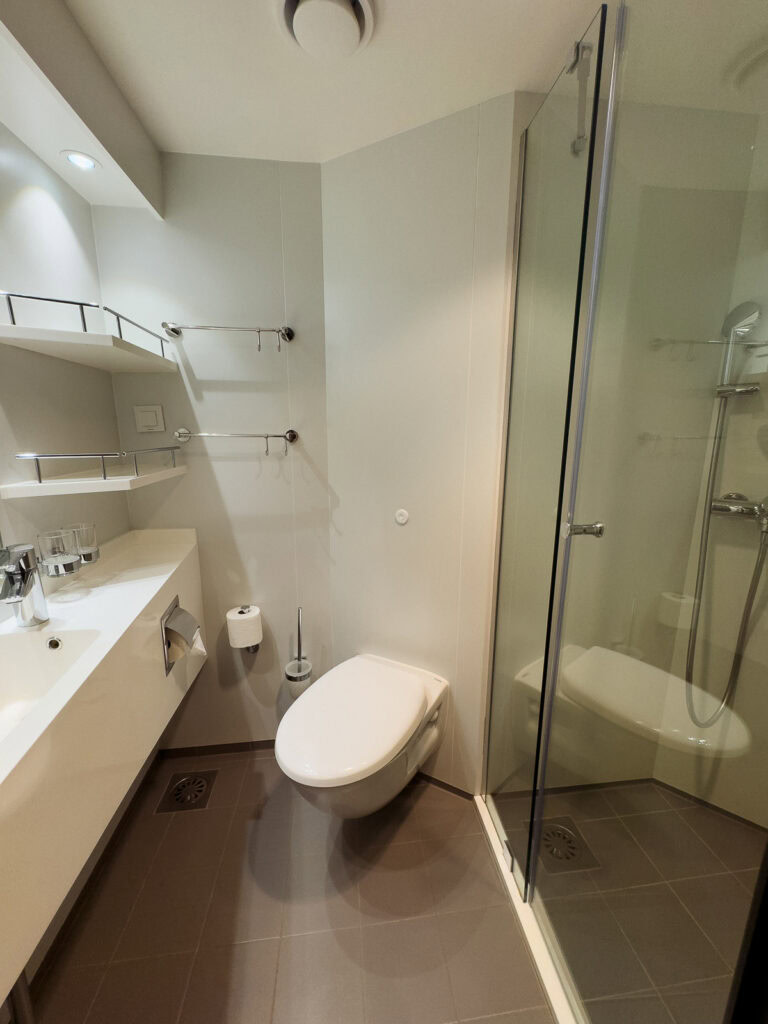
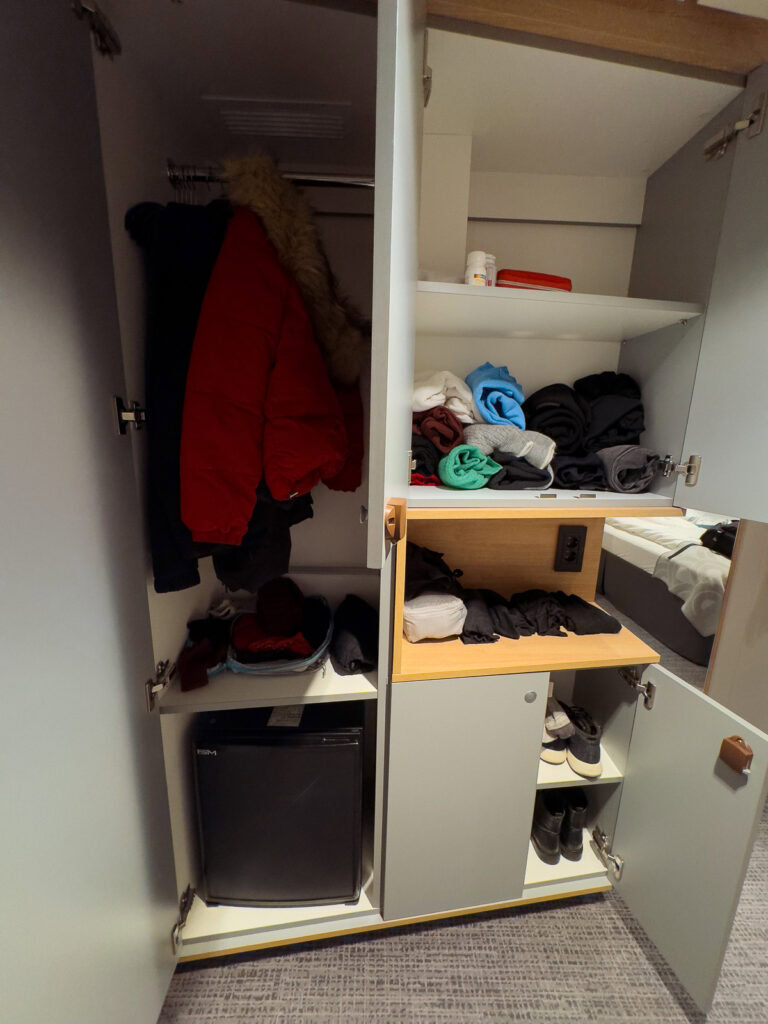
If I was sharing a room it would definitely have been a tight squeeze with big suitcases and bulky winter clothing, so for a couple or two friends I’d say a bigger room would be worth the extra cost if you can afford it.
Unfortunately my cabin had issues with the door jamming so for the last few nights of my trip they moved me to another Seaview Superior room, however this one was a different layout and had no built-in desk, just the small table. This wouldn’t be a problem for most passengers but I was working on the ship so it was less than ideal for me, if I’d been in that room at the beginning I would’ve asked to change as all the online imagery shows a proper desk area.
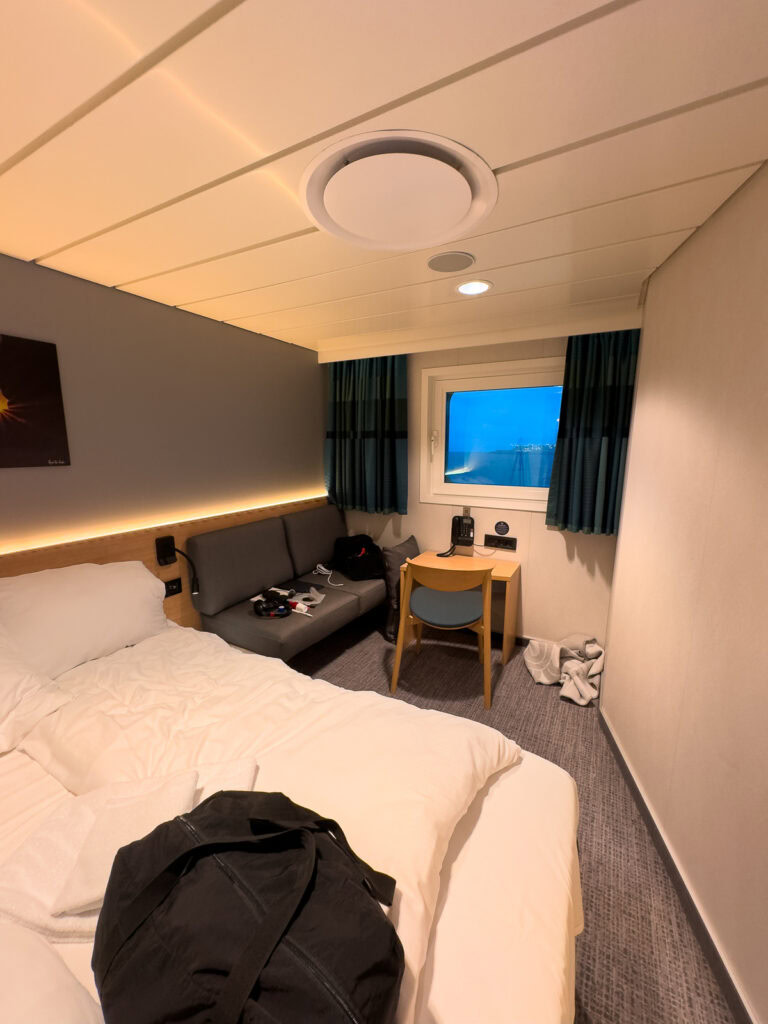
Also a bit of a negative customer experience to be moved to a room that’s not as good as the one you had before, this was a collaboration so I’m not complaining (I’ll go wherever I’m told haha) but it was a missed opportunity to have me showcase a better room category in my content, and if I was a paying customer I certainly wouldn’t have been happy with the perceived downgrade when the ship definitely wasn’t full.
My parents’ cabin: Junior Suite with Balcony
My parents stayed in a dreamy Junior Suite on deck 7’s starboard side, with a balcony giving them epic views all along the coast. It makes a huuuuge difference having a balcony, giving you the opportunity to take photos without window reflections or salt build-up ruining the shot, or to see the aurora just steps away from bed instead of having to get all the way up to the top deck once they make the announcement.
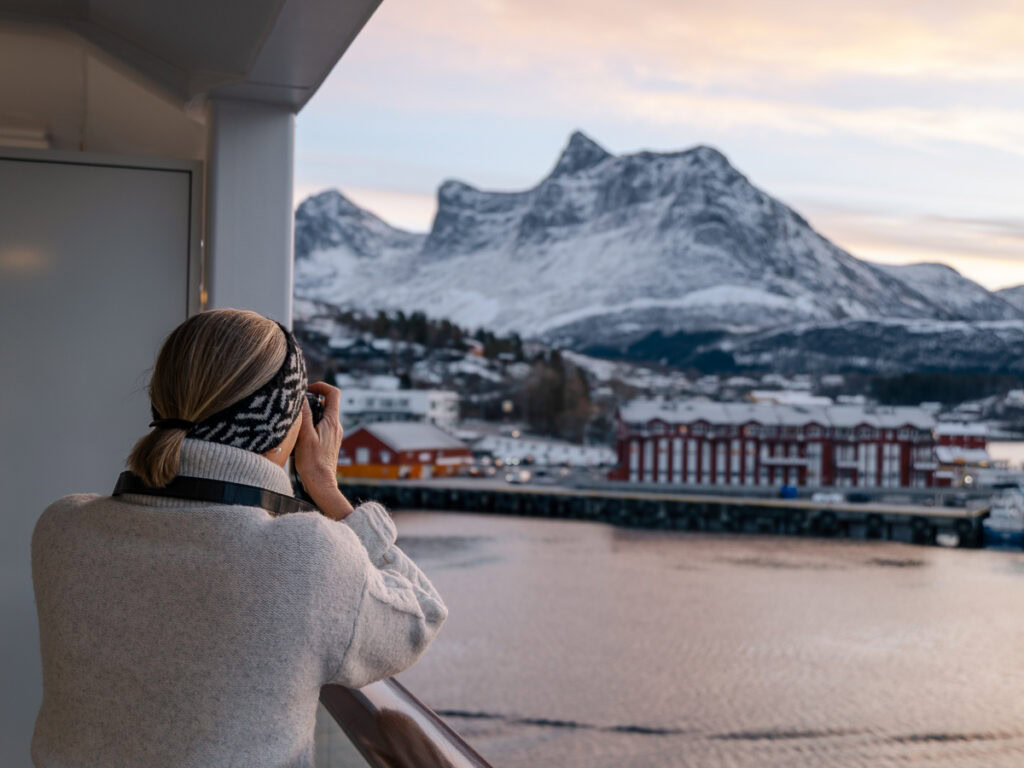
They arrived to the welcome package that comes with the suites, comprised of a bottle of champagne and some local snacks like nuts, chips, berries and chocolate.
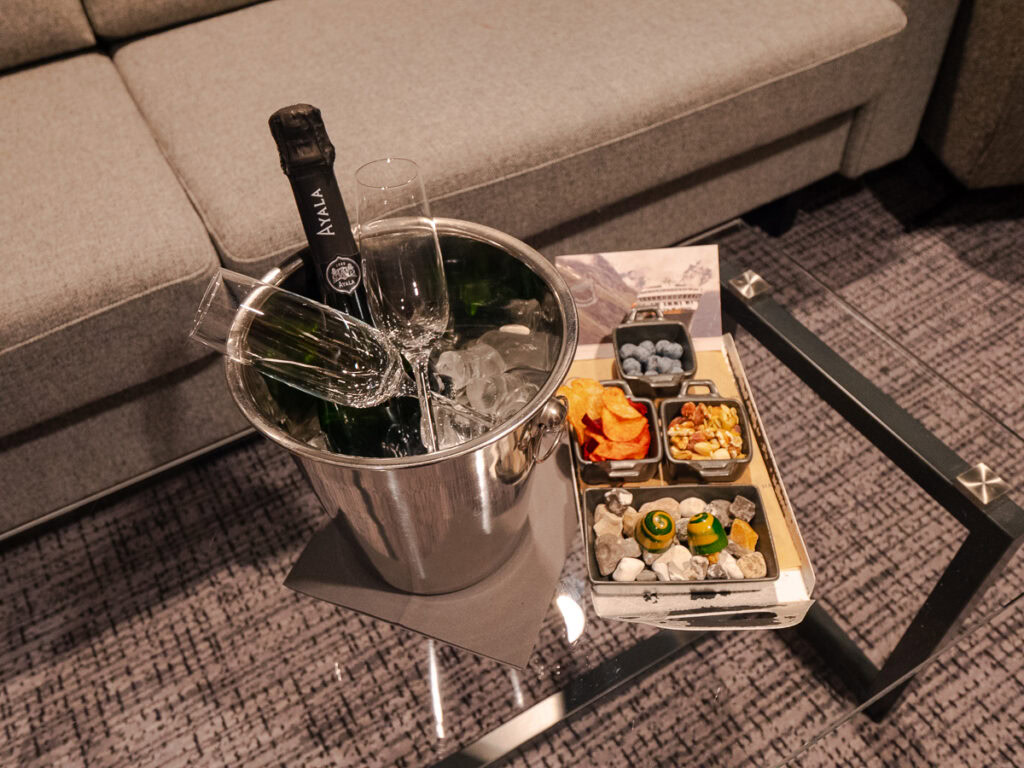
The Junior Suite has a lounge area with a comfy sofa and another chair, a decent amount of storage with two wardrobes plus drawers, a kettle and coffee machine, a desk with a wall that acts as a separator between the lounge and the bedroom, and a TV that swivels for viewing from the sofa or the bed. The en suite bathroom was the same as in my room, perhaps a little bigger.

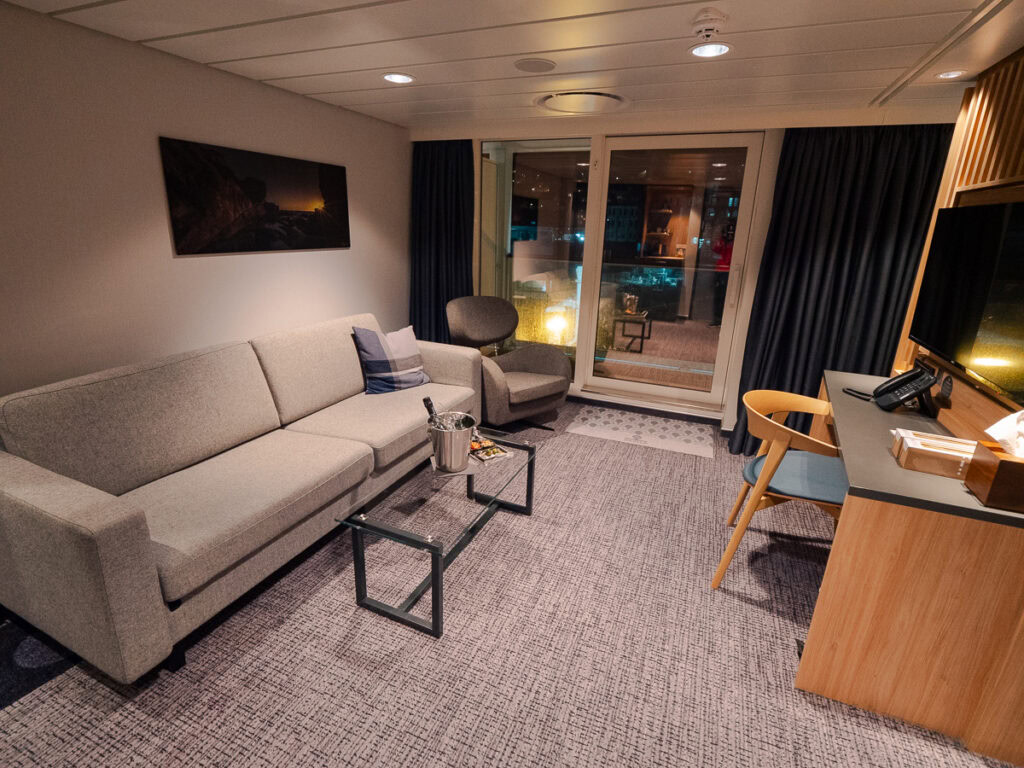
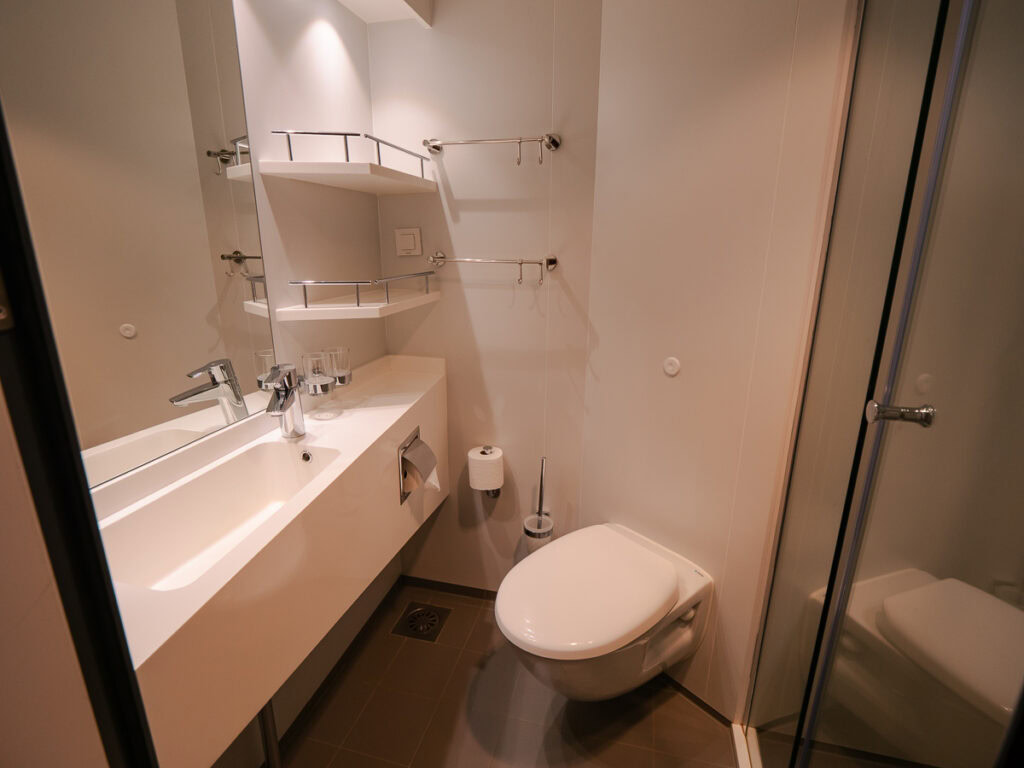
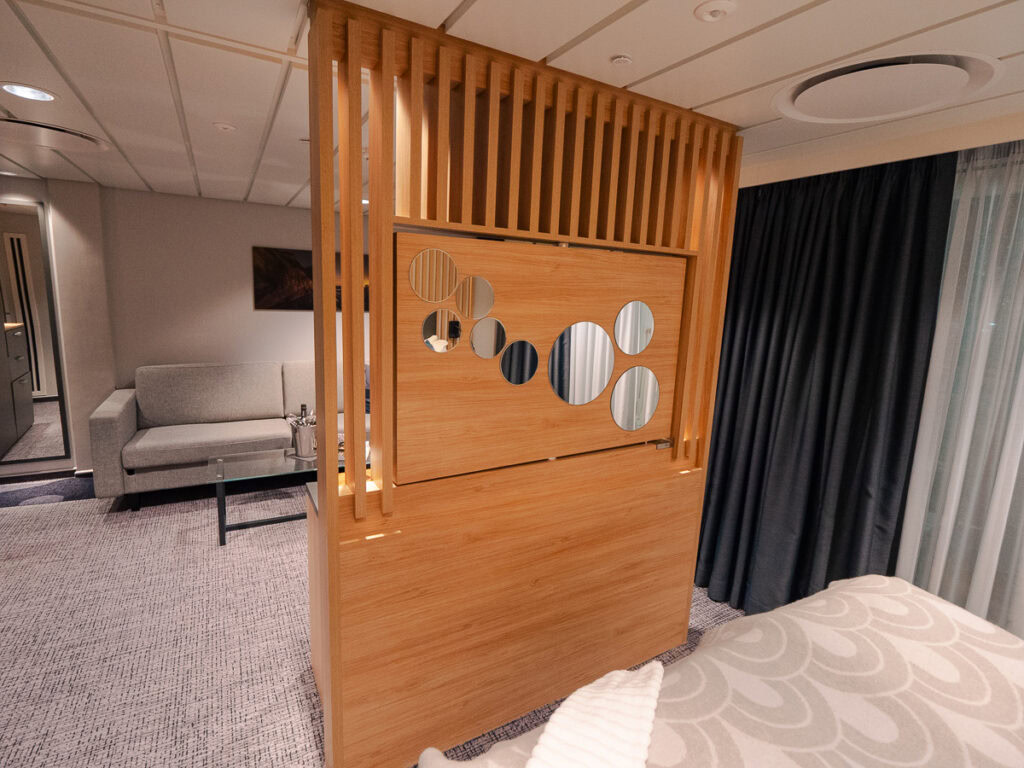
Suite benefits
I briefly mentioned the benefits that come with a suite booking but let me list them out for you:
- Priority check-in: According to the Havila website there’s meant to be a dedicated check-in lane at the terminal in Bergen, but this was not the case (or at least wasn’t clear) when we checked in, there was one long line for check in so my parents had to wait with me and all the other non-suite guests.
- Champagne welcome: Chilled Champagne on ice in the room when you arrive
- Snacks: A small display of local snacks like chips, nuts and chocolates with the Champagne
- Door-to-door escort: You’ll be shown to your room by a Havila crew member
- Access to Hildring Fine Dining: You can choose to eat at Hildring Fine Dining for breakfast and lunch (same menu as Havrand but a quieter/more intimate dining experience + better service)
Common areas on the boat
These ships are only a few years old so the interiors are modern and comfortable, with floor-to-ceiling windows, Nordic minimalist décor and neutral colours. Very different from the garish interiors I’ve seen in photos of typical cruise ships!
Chill out zones
There are various lounge areas inside and outside around the boat.
On deck 6 there’s the Bow Lounge with lots of chairs and sofas available for sightseeing, plus more seating on the same deck around the Atrium if you’re waiting for the Excursions desk to open or for your restaurant time. There’s also a viewing deck outside at the front, ideal for aurora photos.
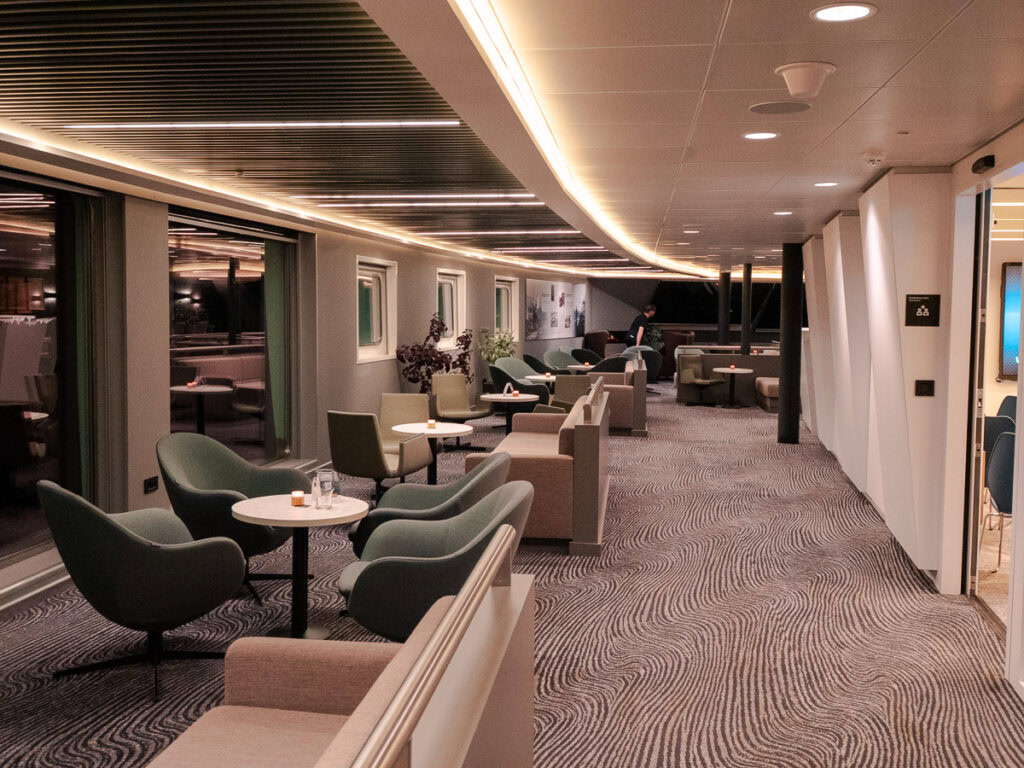
On deck 8 there’s the Havbris Bar on the outdoor deck, in the warmer months this would be a fantastic place to spend the afternoon hours with a drink while enjoying the changing scenery, but in late November it was more than a bit chilly! They held daily afternoon meet ups here with warm drinks and little snacks when the weather allowed.
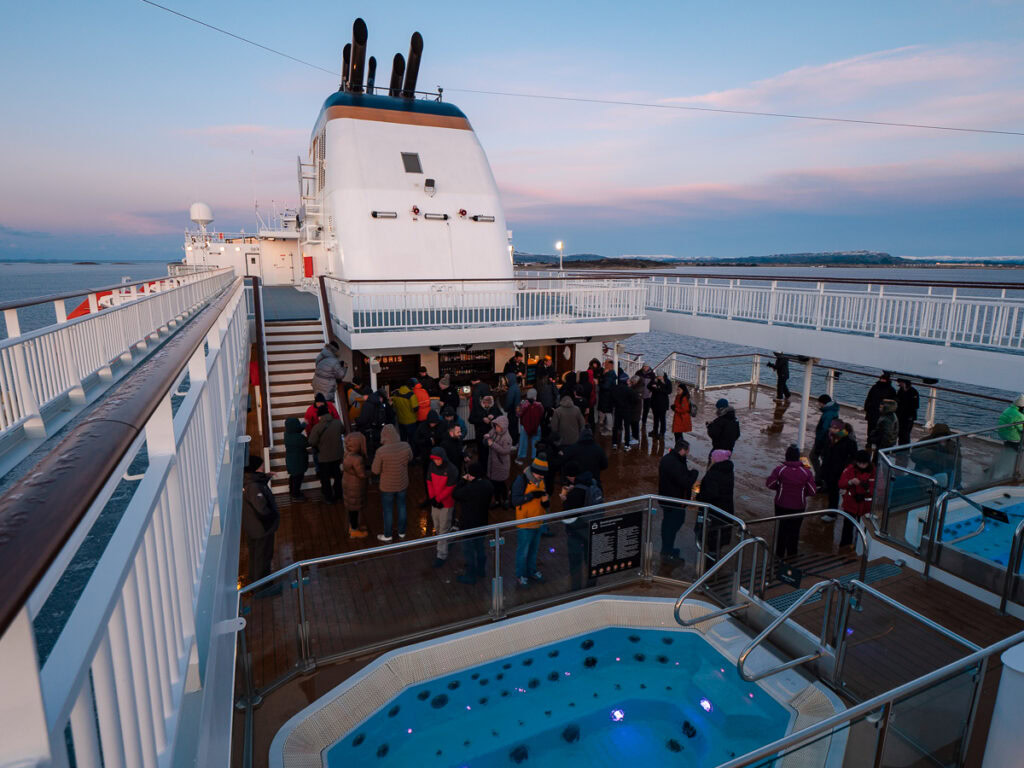
And on deck 9 you’ll find the Havblikk Bar & lounge, with more comfy chairs, desk areas if you’re working, huge windows and drinks top ups within easy reach. Outside of Havblikk you have access to the top deck from bow to stern, though the bow wraparound balcony is closed when it’s too windy for safety reasons.
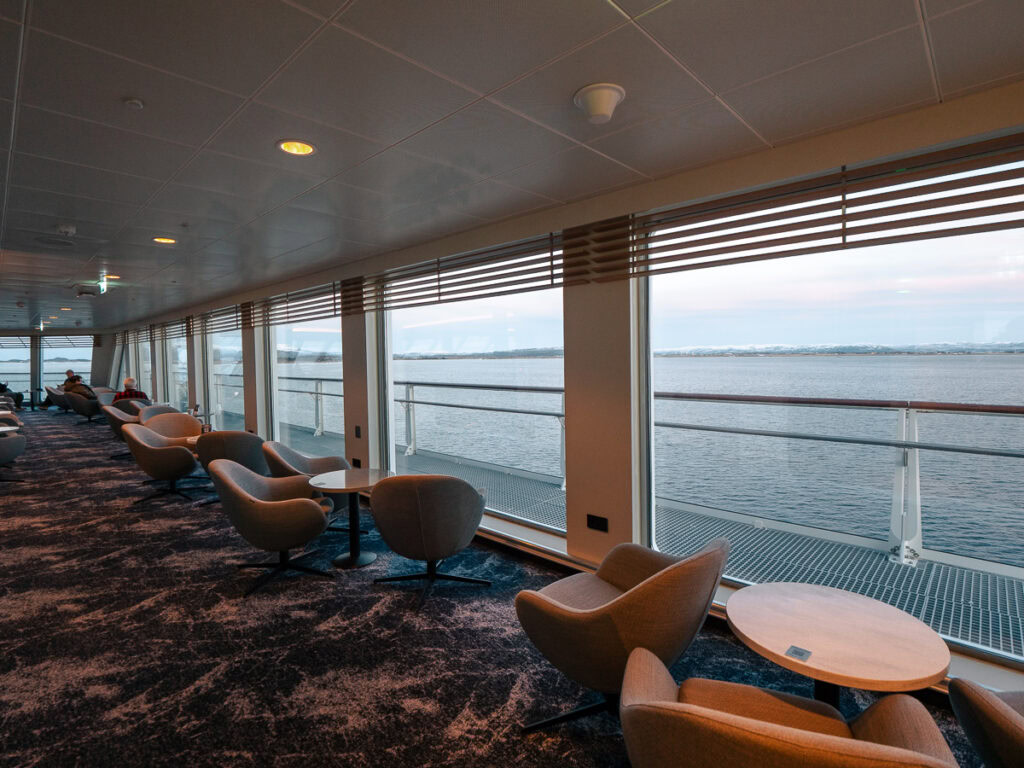
Gym
Deck 7 has two fitness rooms, one cardio room with two each of treadmills, bikes and rowing machines, and one weights room with dumbbells, benches, a cable crossover machine and some other equipment.
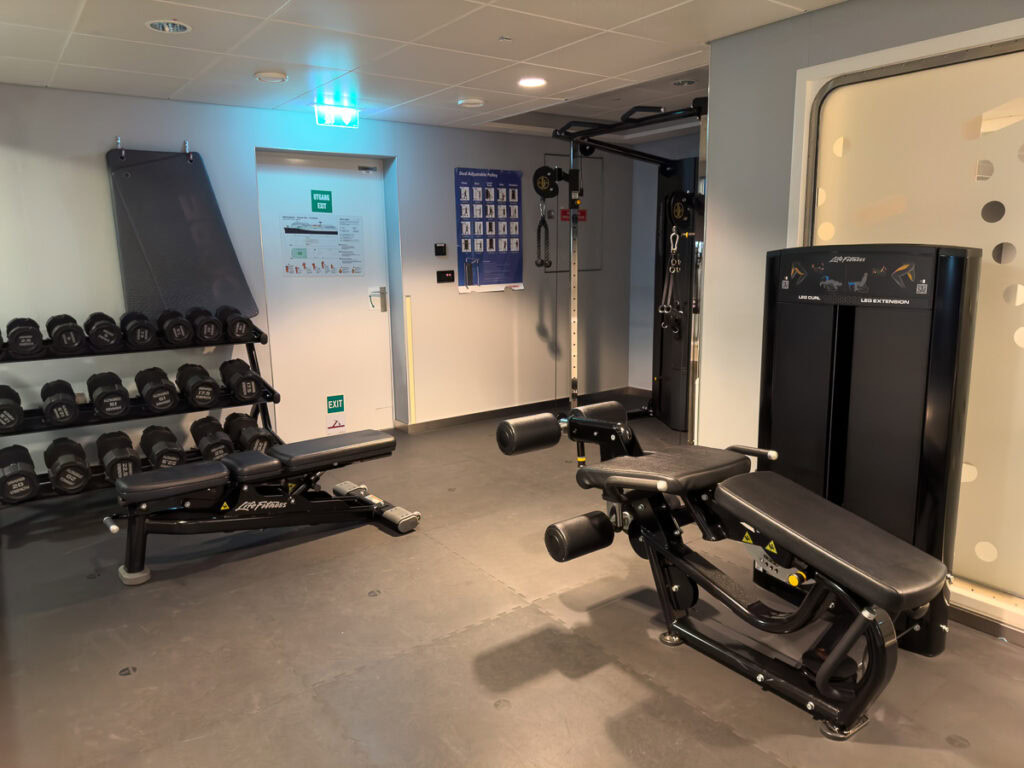
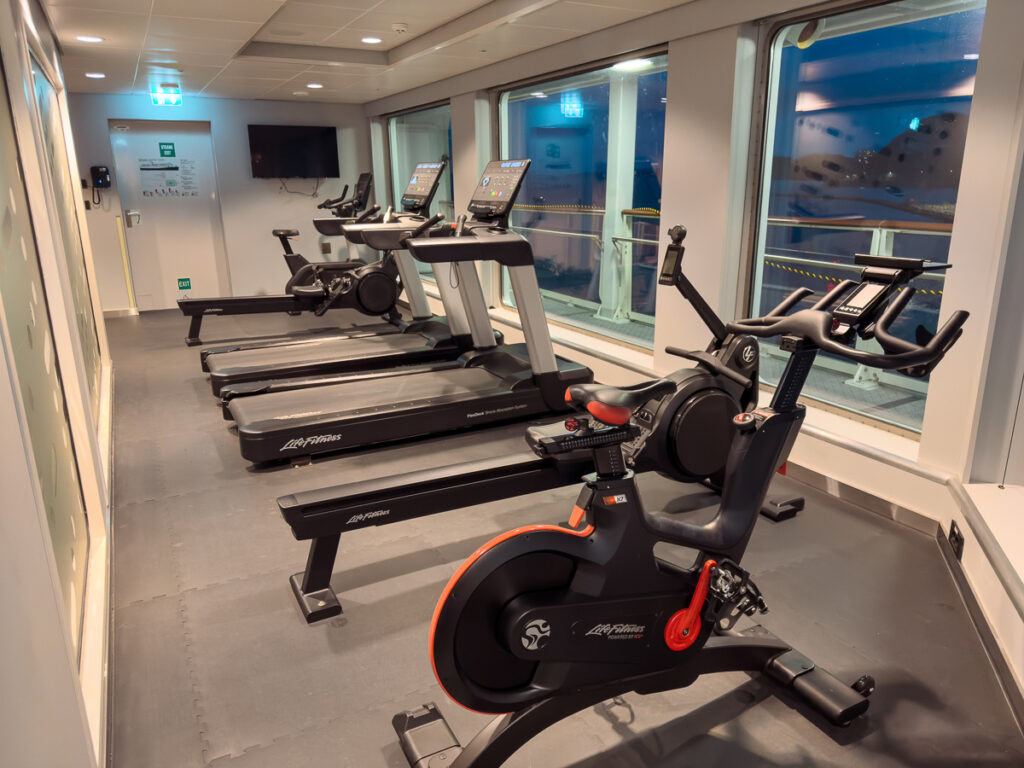
Sauna & jacuzzi
Deck 8 is home to a men’s sauna and a women’s sauna with easy access to changing facilities, as well as two spa pools on the outdoor deck.
I wish I could tell you I used the jacuzzi under the Northern Lights (bucket list!), but the air was sooo freezing that I felt like the 15 second walk from the tub to the indoor changing room might have killed me 🙃
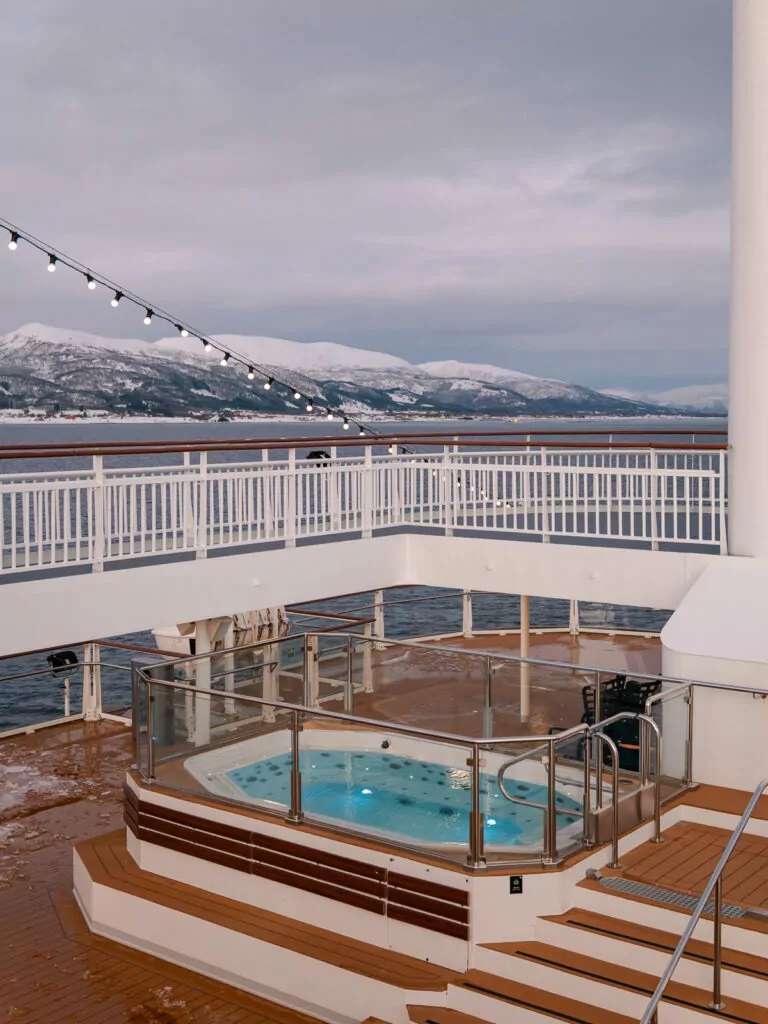
Conference room
There’s a dedicated conference room on deck 6 where the excursions team holds presentations for each new destination and some specific topics like the aurora or local culture.
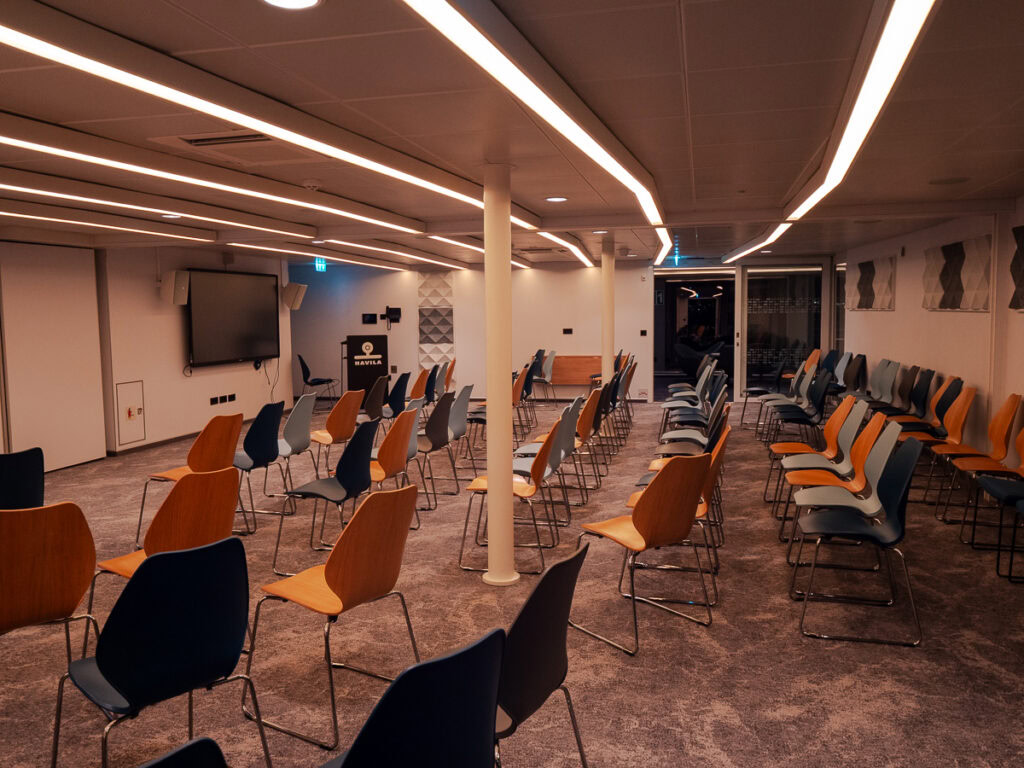
Food on the boat
If you’ve been on cruises before then you’ll need to forget everything you know about cruise dining, because Havila does it completely differently.
One of the biggest problems with typical cruise tourism is the horrendous amount of food waste, it’s hard to get official numbers but a recent study in 2022 found that the average food waste per passenger was 1.36kg per day 🤯 This is caused by buffet dining and all-inclusive pricing which makes people load up their plates to get better (perceived) value for money, and with 30+ million cruise passengers each year, it hurts my soul to think about what the total cruise industry food waste adds up to annually.
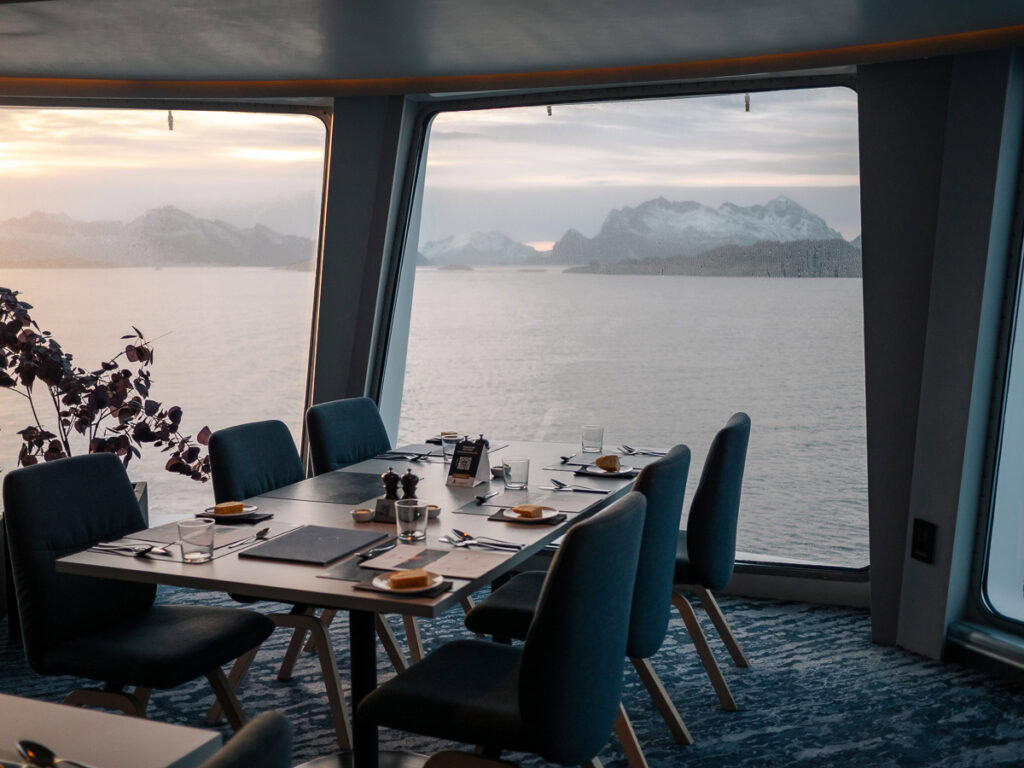
Havila has taken a different approach between their three dining options to minimise wastage and keep average food waste per passenger below 75 grams per day. Very impressive! They won 2024’s ‘Best Cuisine’ Wave award for their dining concept.
There are three dining options on the ships:
- HAVRAND Restaurant (main restaurant)
- HAVLY Cafe
- HILDRING Fine Dining
And here’s what to expect from each of them.
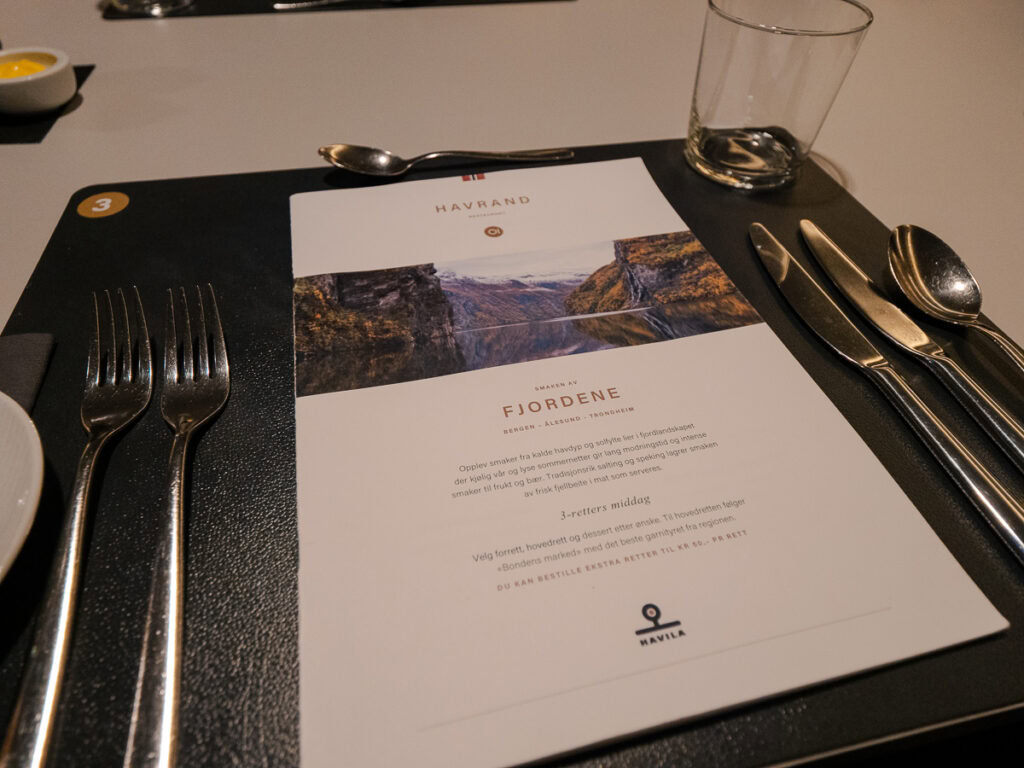
HAVRAND Restaurant
This is the main restaurant with meals included in all voyages (but not port-to-port bookings), the opening hours are:
- Breakfast 7-10am
- Lunch 11.30am-2.30pm
- Dinner 6-9pm
You need to arrange set meal times when you check in in Bergen or on board with the head waiter, whose desk is right outside the restaurant, and these will be your meal times throughout the cruise. If you’ve got an excursion that messes up your meal time one day just chat to the head waiter beforehand to have it moved, if you miss your meal time without advance notice there’s no guarantee you’ll get a spot afterwards (but the café will be open for you).
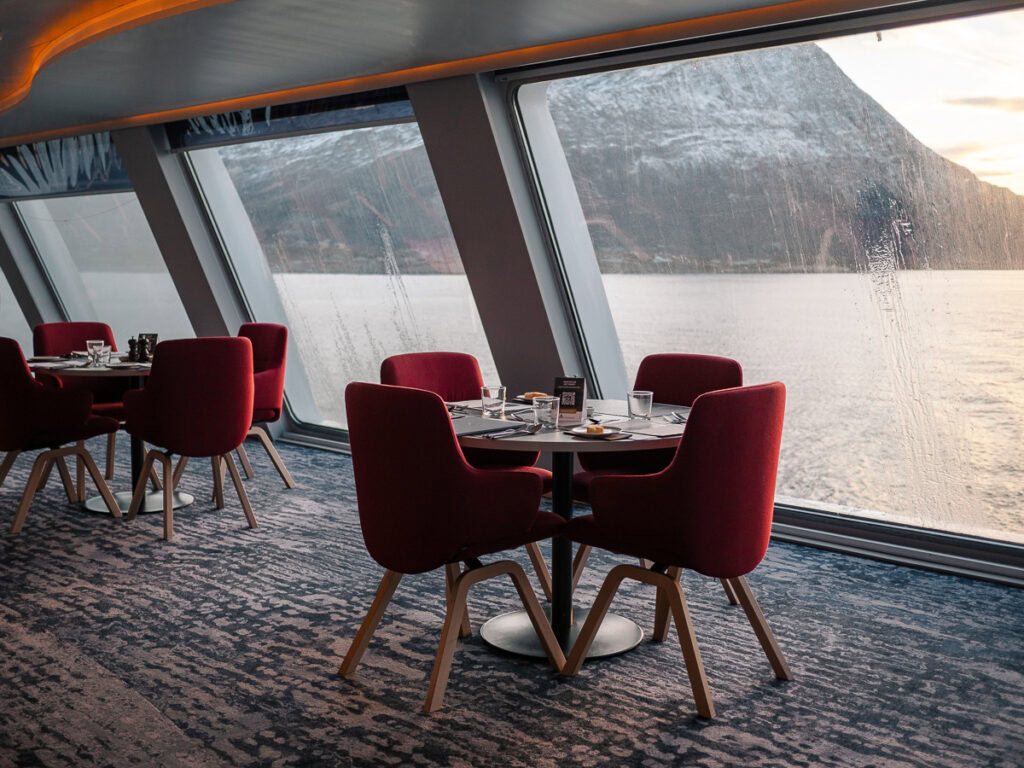
Havrand is still all-you-can-eat but in a much more managed way than a typical buffet.
Breakfast has a buffet of cold foods like fruit, yoghurt, cereals, breads and cold cuts, as well as an a la carte menu of small cooked dishes like eggs, oatmeal, vegetable hash, breakfast sausages and pancakes.
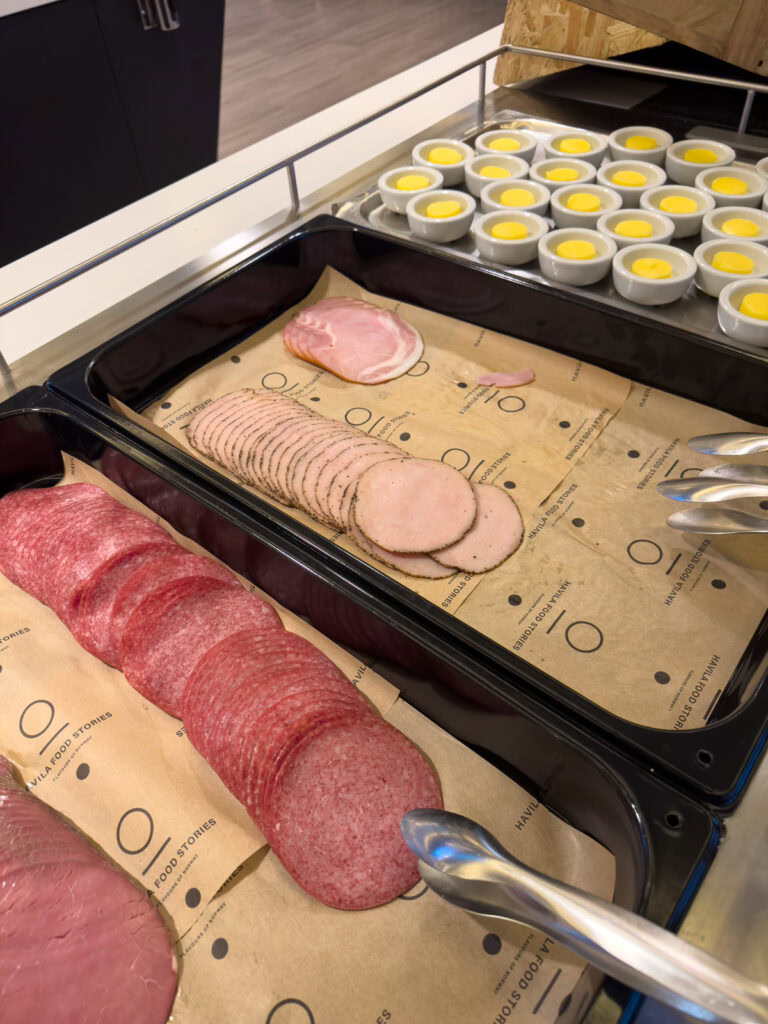
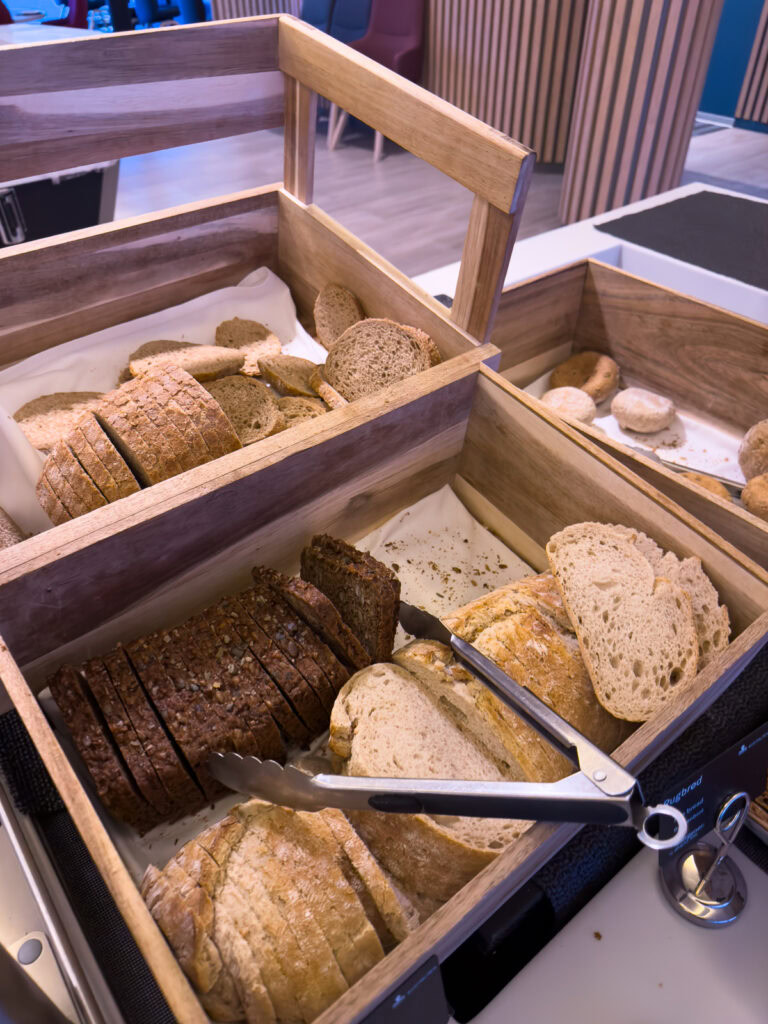
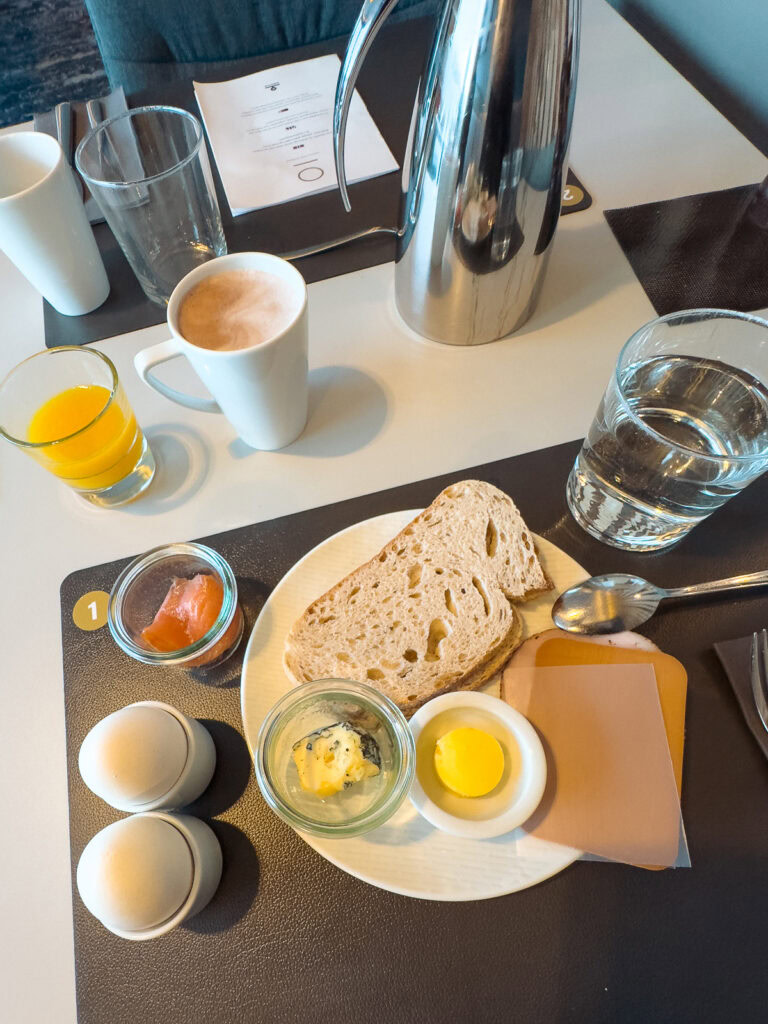
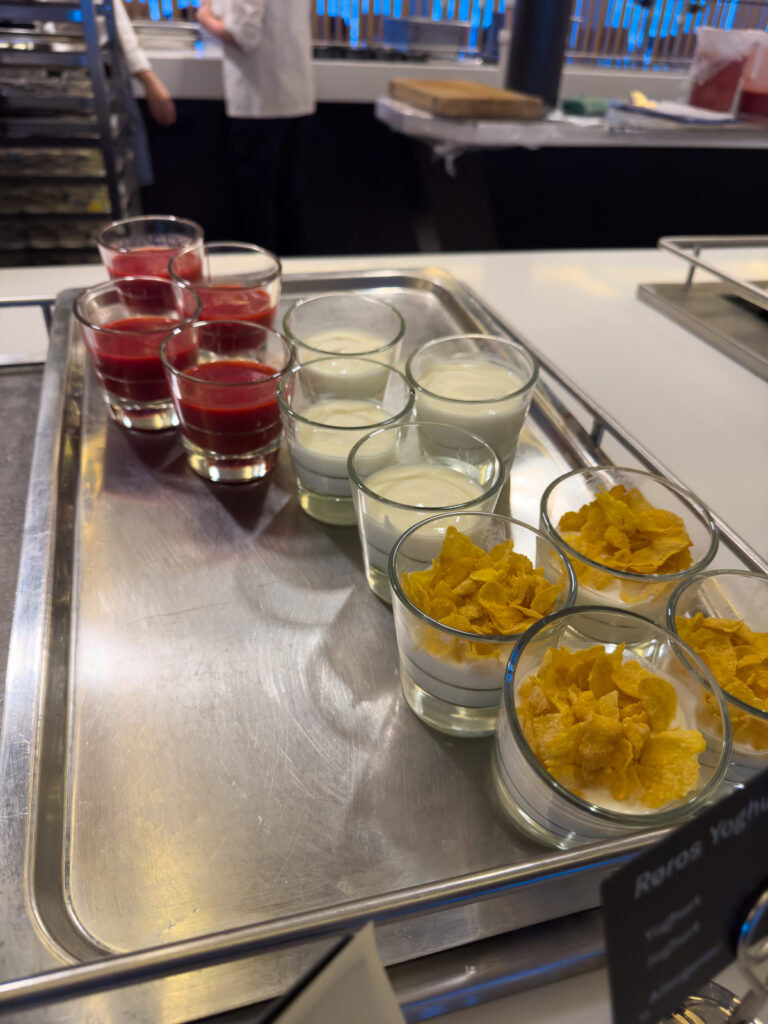
Lunch and dinner have a changing menu every few days based on the region you’re in, with a focus on using local ingredients and sharing culinary traditions from along the coast.
There are a few items that are always on the menu, then there are featured dishes from the Fjords (Bergen to Trondheim), the Polar region (Bodø to Honningsvåg), the Arctic (Kirkenes to Harstad) and the Archipelago (Rorvik to Bergen).
Lunch is a menu of small plates, you can order as many as you want but they recommend three for a satisfying meal. Some of the always-on options are Caesar salad, cured ham, smoked salmon mousse, potato soup, steamed mussels and pea schnitzel. Some of the feature dishes I loved were braised beef with mashed potato and fried Arctic char.
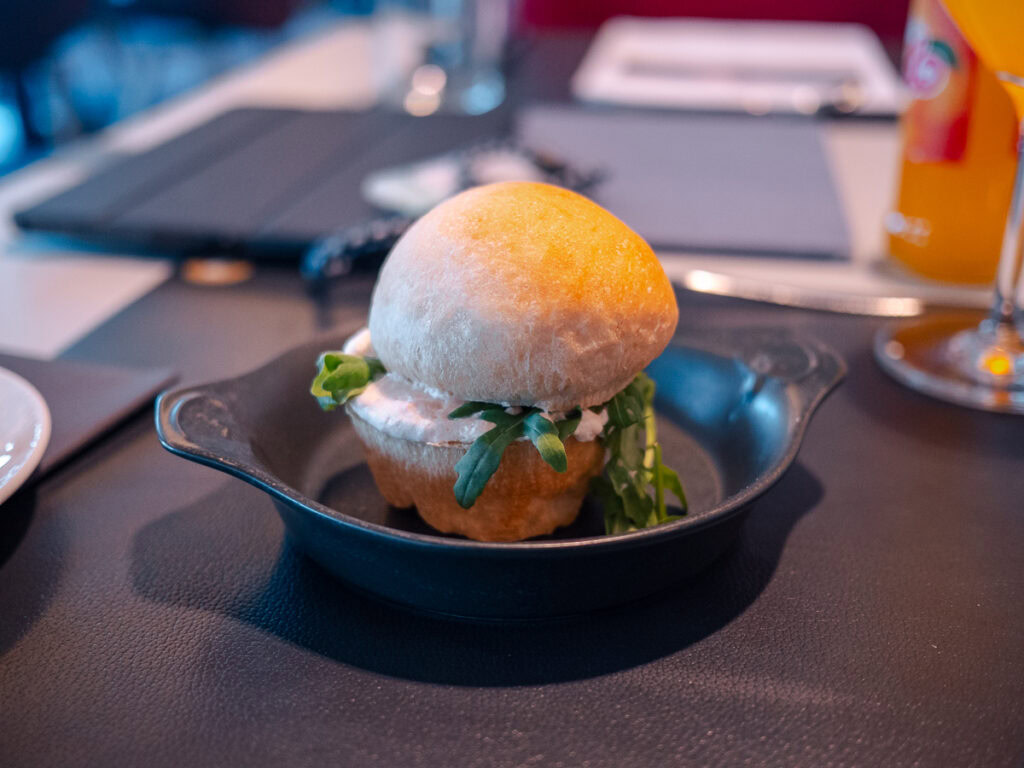
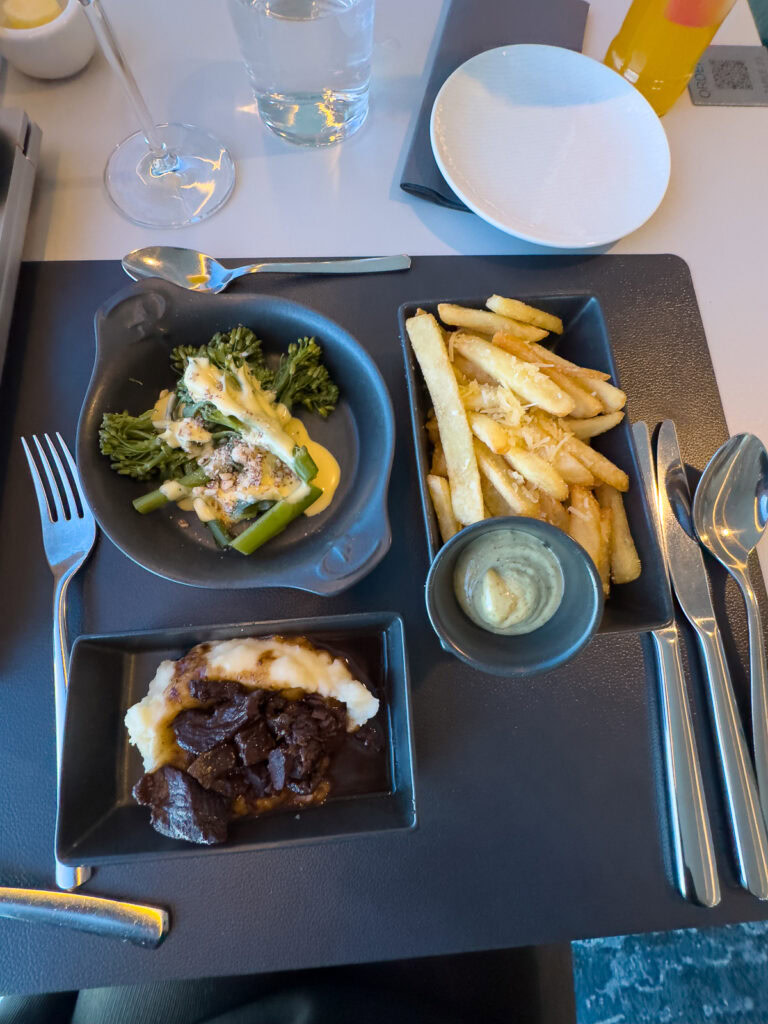
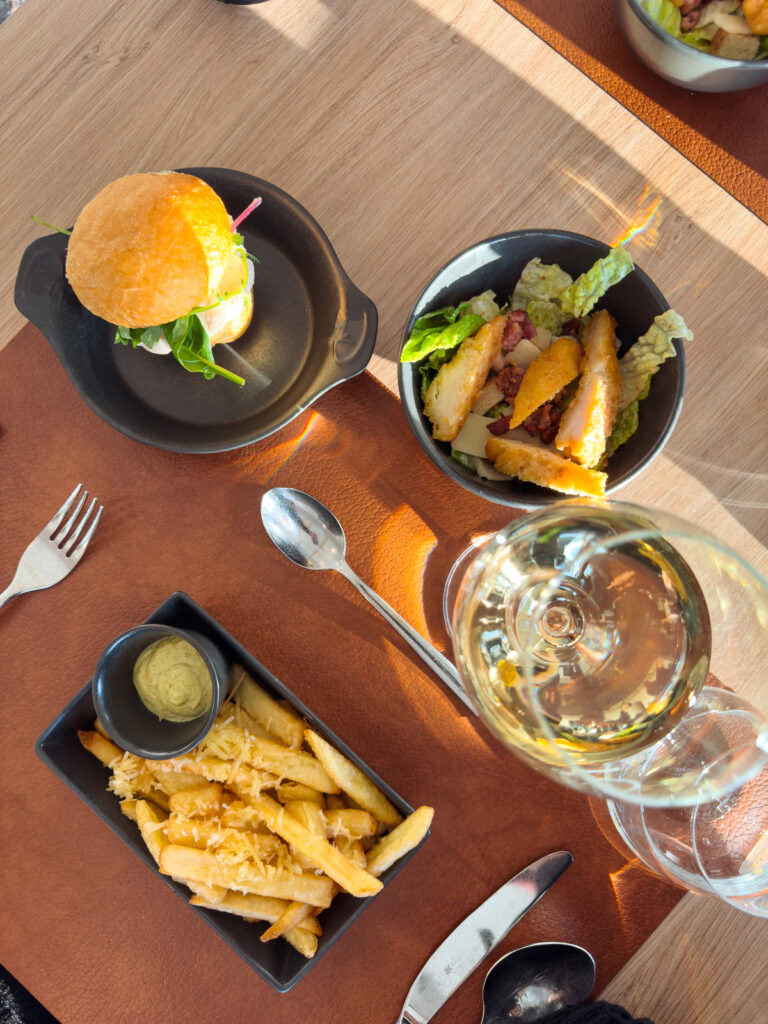
Dinner is a similar format but with starters (six options), mains (six options) and desserts (four options), modest portion sizes but you can order more if you want to (for no extra charge).
Starters included porcini soup, trout sashimi and beef carpaccio, mains included fish stew, poached salmon and slow-cooked lamb shank, and desserts included strawberry & rose sorbet, and apple cake with lemon cream.

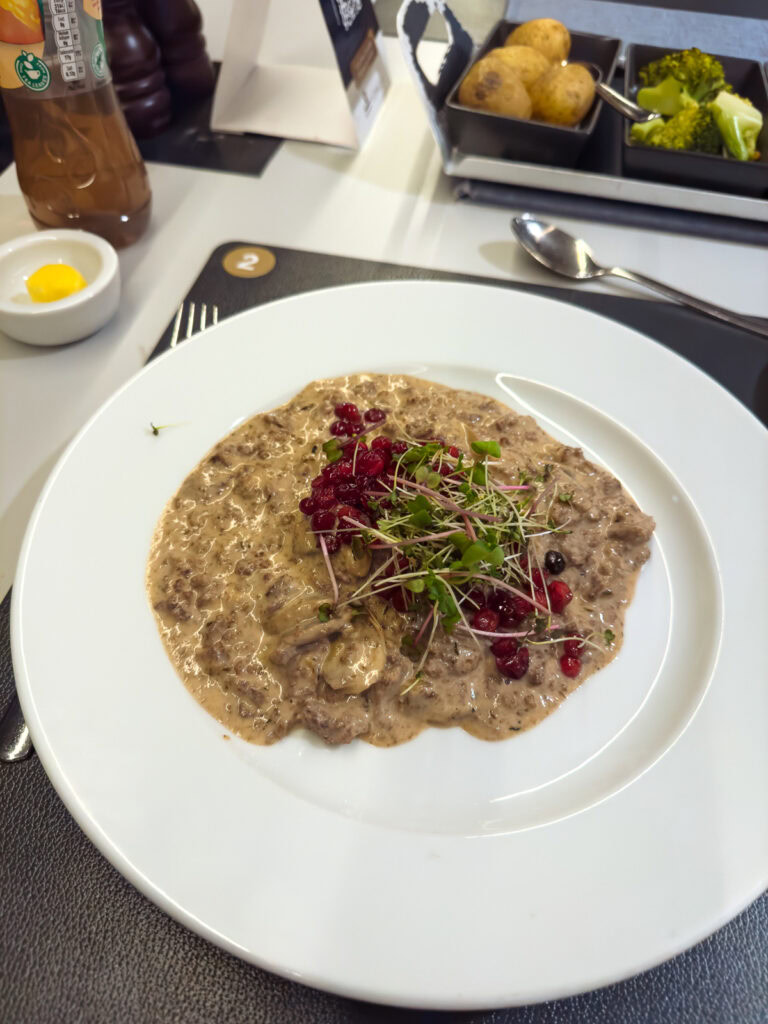
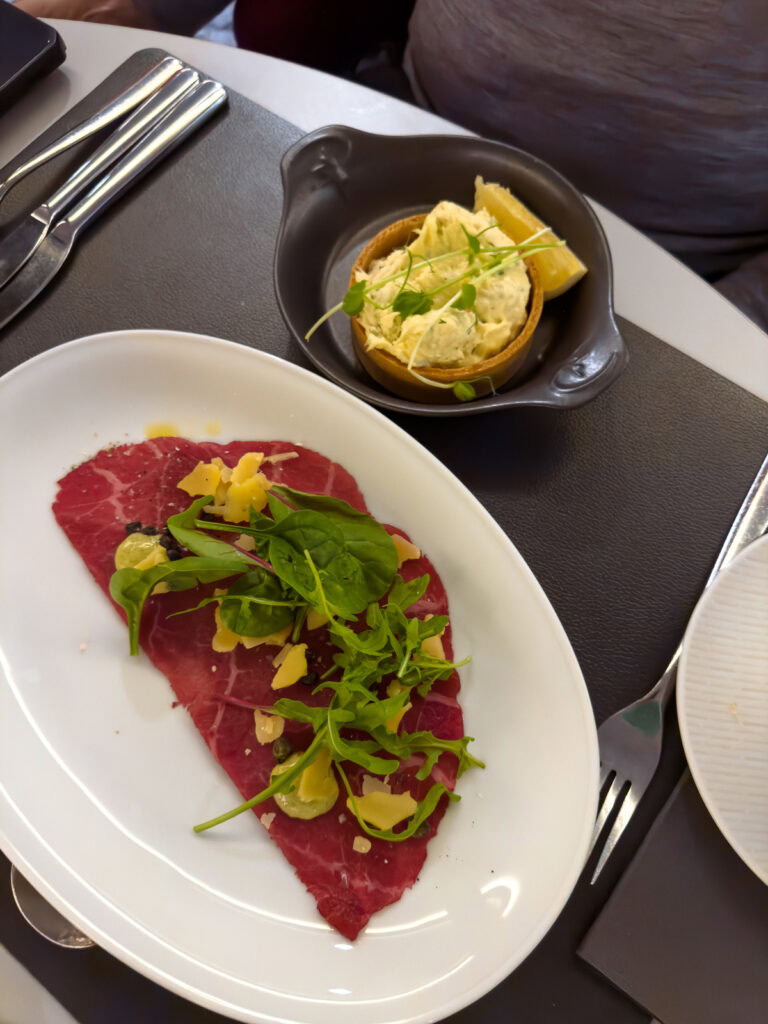
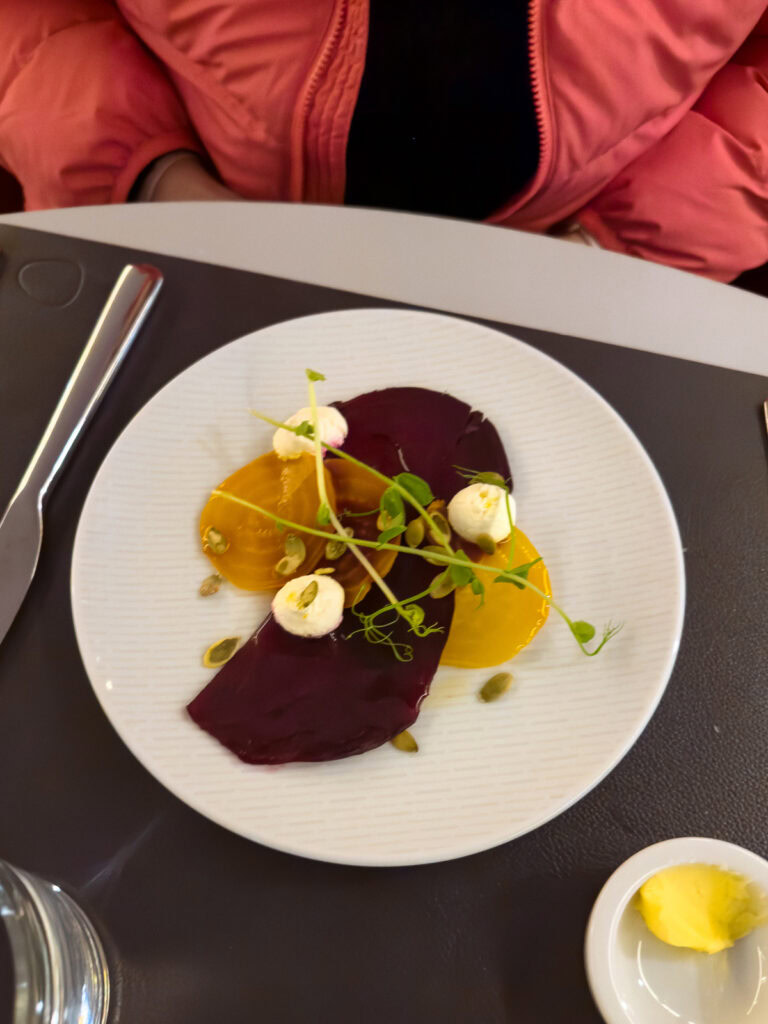

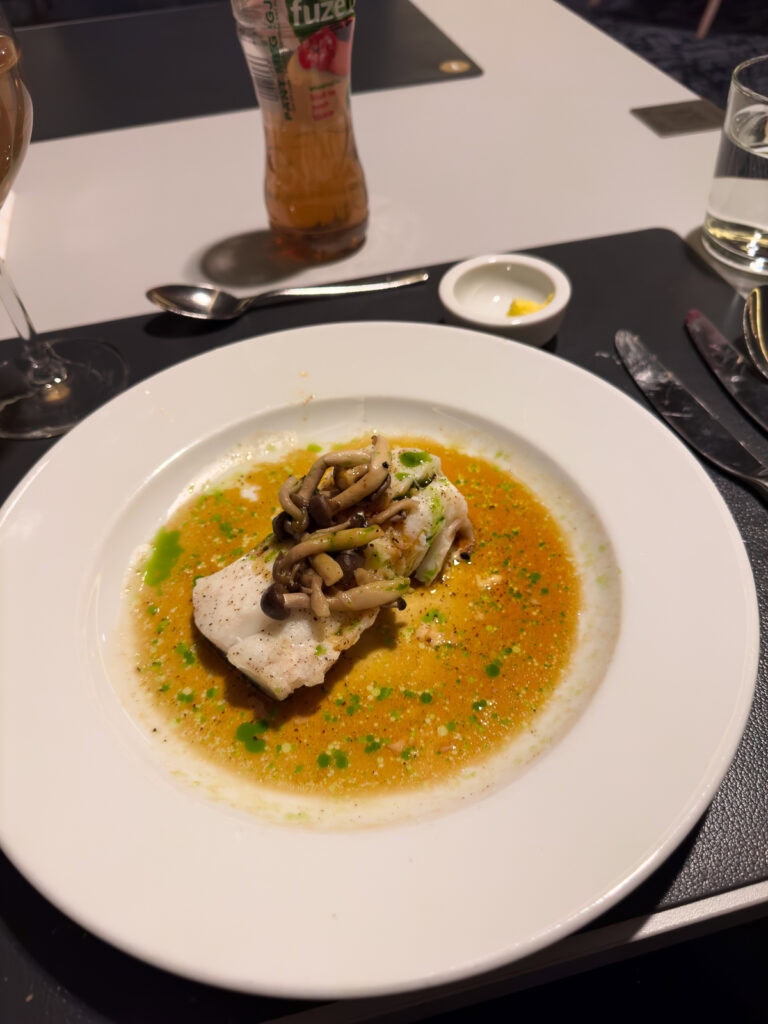
I really, really loved the concept of smaller plates and a la carte dining instead of overloaded portions or a huge buffet, it meant I could try lots of things without wasting food or eating way too much! Norwegian food isn’t my favourite cuisine in the world, but I did appreciate the changing menu for the opportunity to try a range of traditional dishes throughout my 11 days on board.
It’s undeniable that sustainable, local food sourcing does come at the cost of variety, but this is only a negative because cruises often serve Americanised cuisine no matter where they are in the world, with horrendous consequences of food waste. Responsible tourism is all about compromise, and if I have to give up loaded fries or pesto pasta for two weeks to do my part in minimising waste, I’m on board. Pun intended 🙃
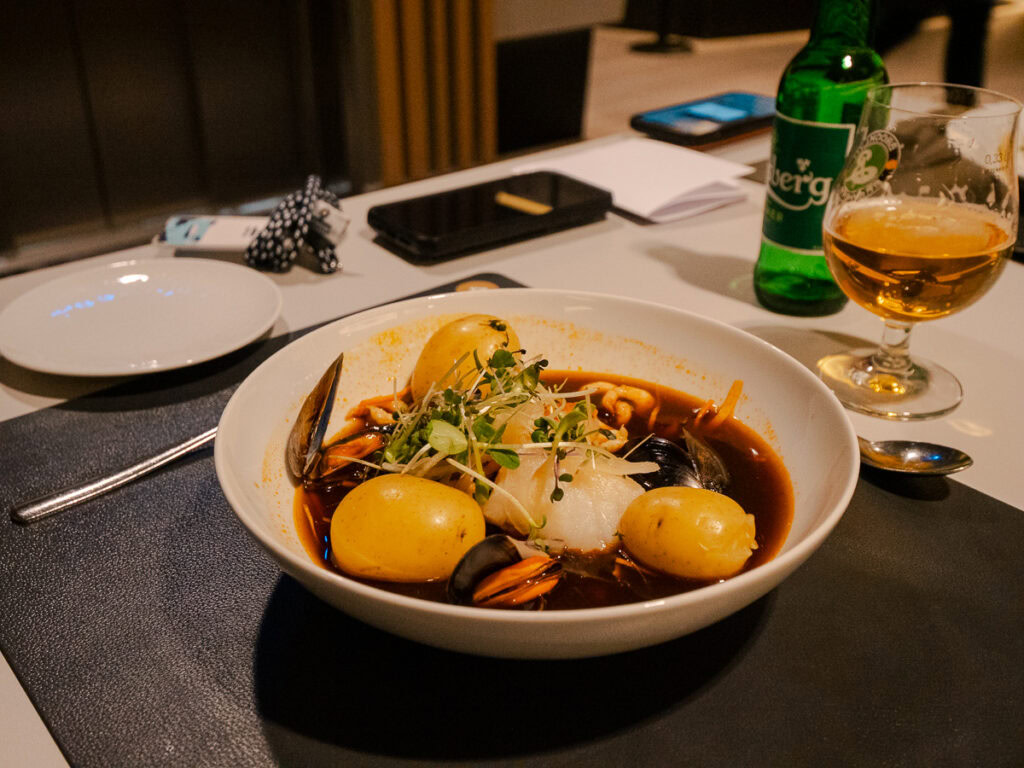
In saying that though, there were a couple of things I didn’t love at Havrand.
I found the food quality to be a little hit and miss, probably due to me choosing the latest lunch and dinner times so on multiple occasions I received dishes that were lukewarm or had clearly been sitting under the lamp for a while. This was a shame because Norwegian cuisine is quite simple with subtle, mild flavours that really rely on cooking technique to impress, they don’t have much to hide behind, so timing can make or break them.
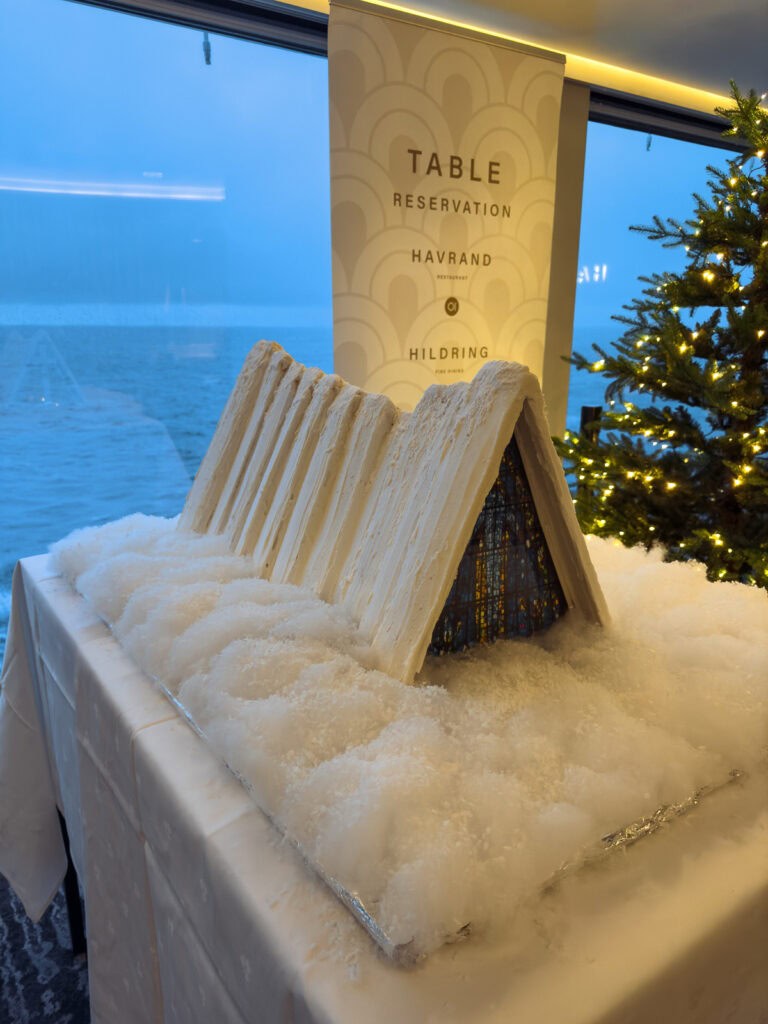
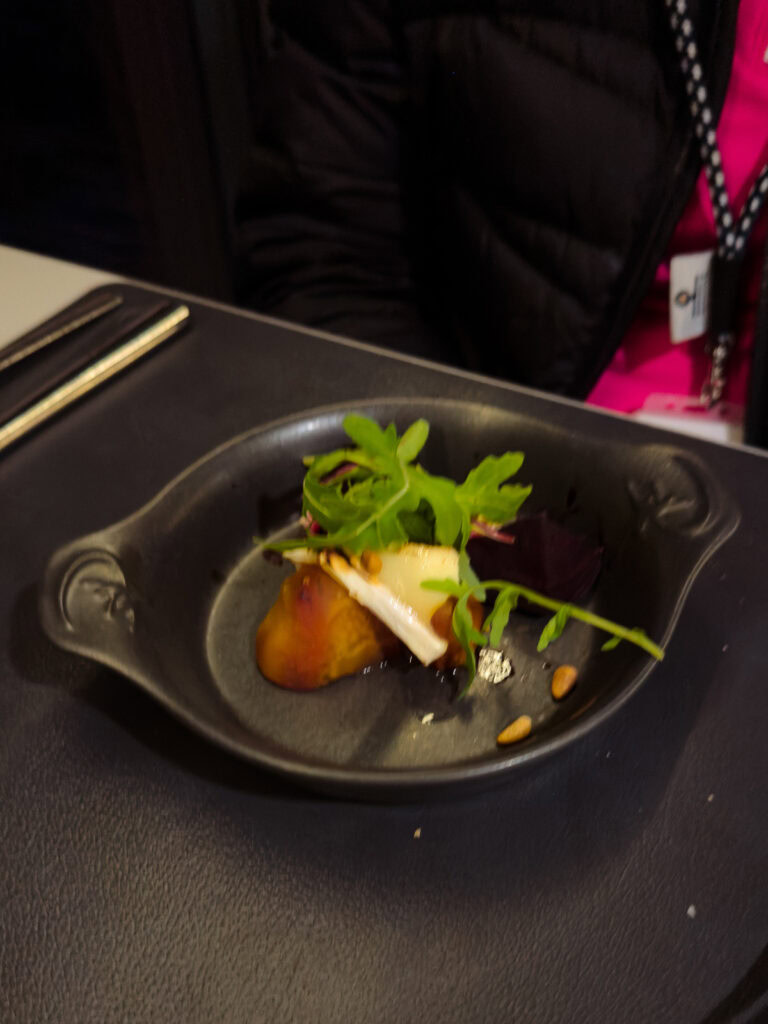
I also found the service from the waitstaff to be very varied. The head waitress (I think her name was Sandra) was fantastic and there was a super friendly waiter named Helder who was always very efficient, but some other staff members were certainly not at their level which was disappointing on such an upmarket ship.
Overall I’d say Havrand was good but it didn’t exceed my expectations.
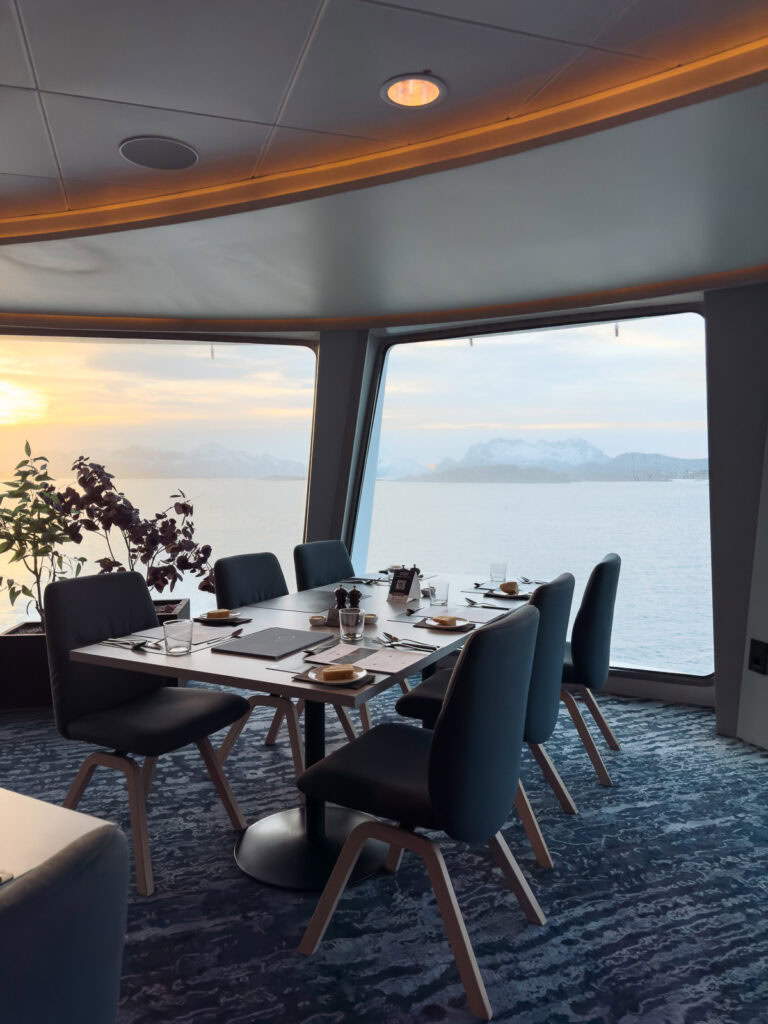
HAVLY Cafe
If you miss your meal time for whatever reason, or if you just want a quick and casual meal, Havly Cafe is open from 8am to 10pm with a variety of simple dishes like freshly baked cinnamon rolls, sandwiches, wraps, burgers, soups and more.
When I did the cruise in November 2024, about half of the Havly menu was included in the voyage dining package. As of 2025 this is no longer the case, and all cafe meals are at additional cost.
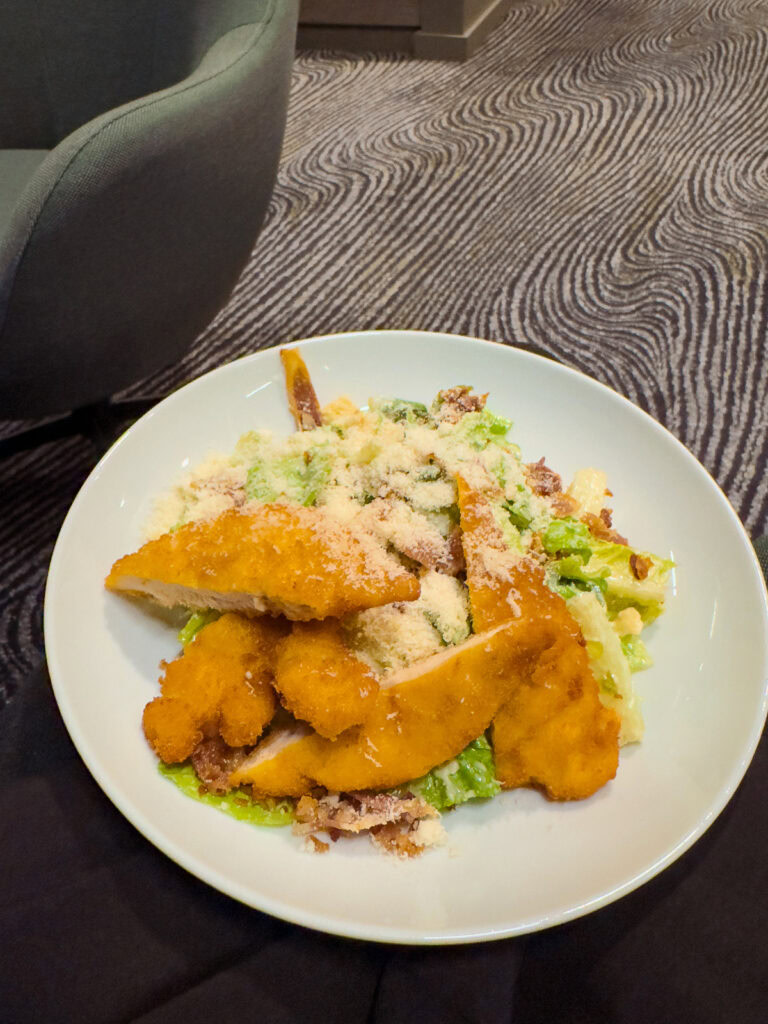
HILDRING Fine Dining
Hildring Fine Dining restaurant is where Havila’s culinary team really shines, with four different dinner menus on offer throughout the journey (menu depends on the day) at additional cost:
- Six course seafood-focused menu of King crab, scallops, pan-fried turbot, rack of lamb, sea buckthorn cream and dark chocolate
- Six course meat-focused menu of beef tenderloin, cod with crayfish stock, duck with orange sauce, reindeer, chocolate terrin and dark chocolate
- King crab evening
- Nine course farewell dinner with the head chef
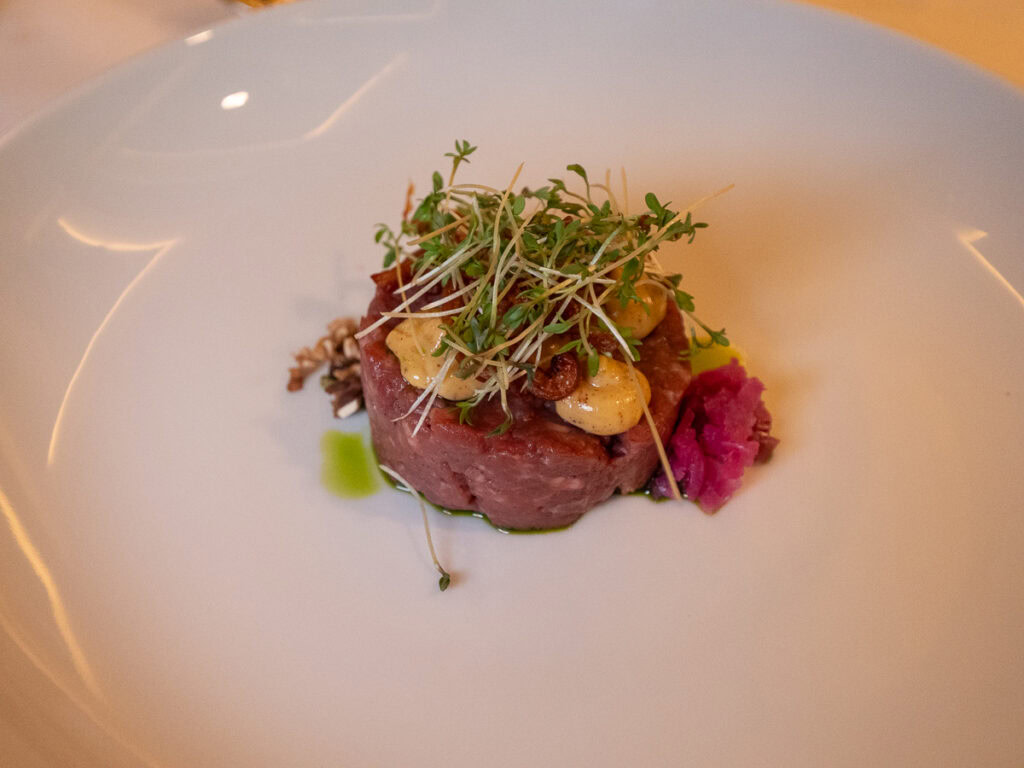


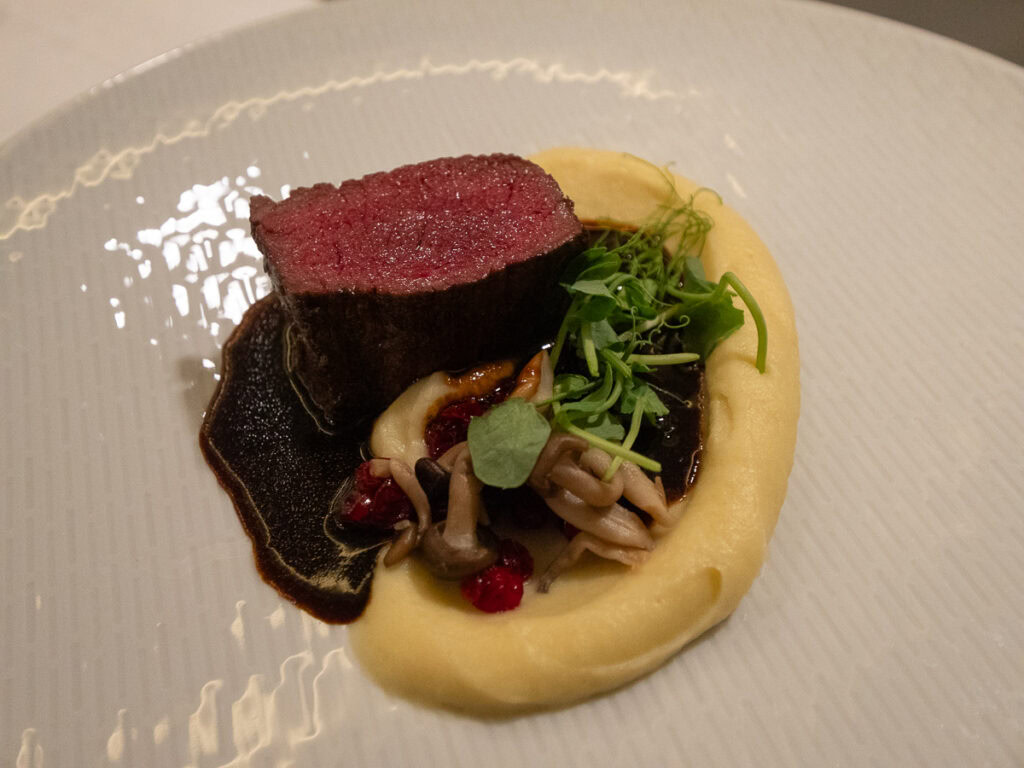
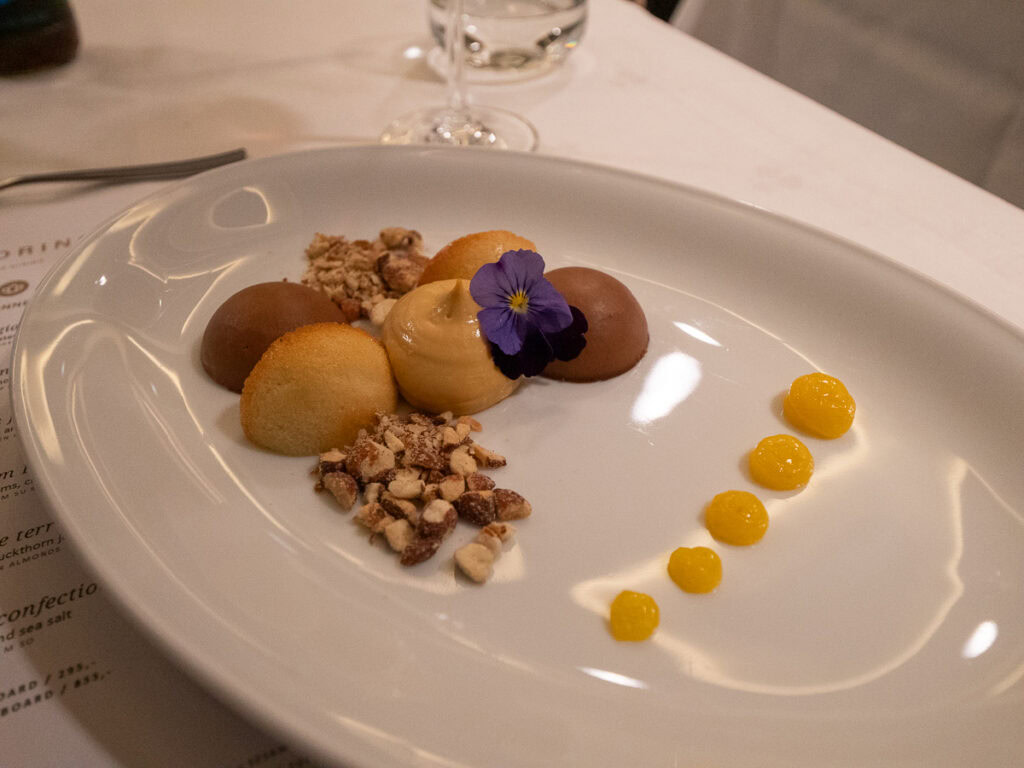
I did the land menu and it was divine, beautifully tender and perfectly-cooked meat from farms along the route, subtle sauces using local ingredients, brilliant service in a quiet and exclusive setting. I wish I ate here for the other menus too!
My parents did the King crab evening, this was on my dad’s bucket list and he said it exceeded expectations.
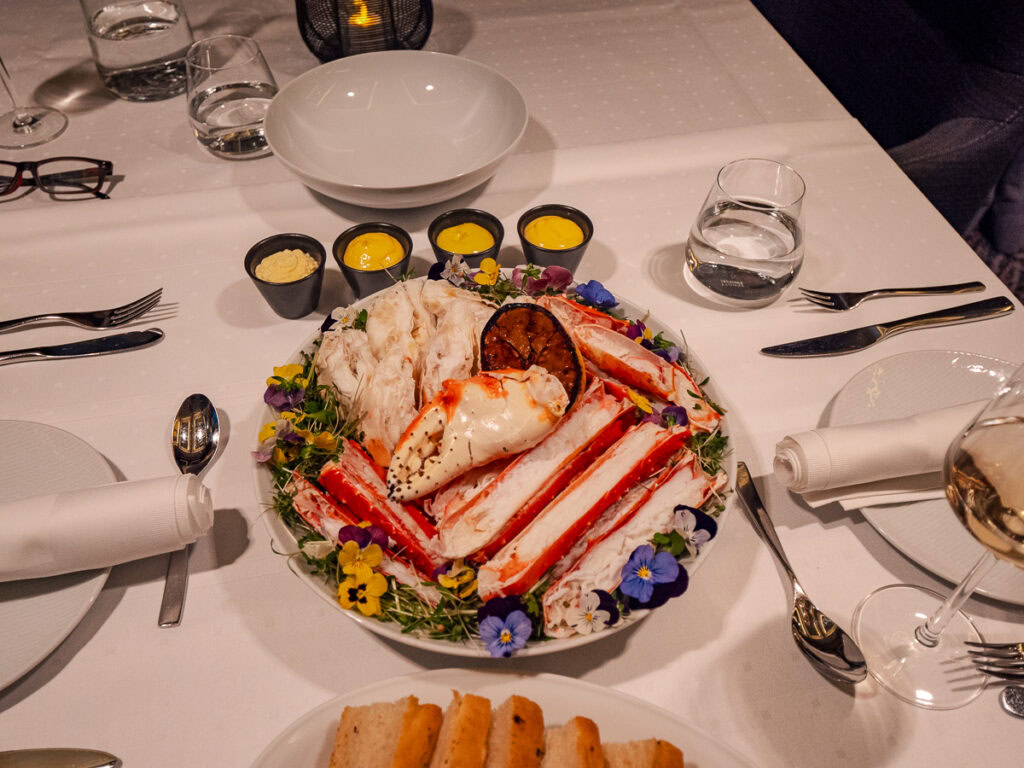
Beverages on the ship
There’s free still water, coffee and tea available on board at all meals, plus orange juice, apple juice and milk available at breakfast. There’s an extensive list of wine, beer and soft drinks available at the restaurants, plus cocktails at the bar.
When we got on board we were told there was a beverage package available but there was no info about this online so please note this might not always be on offer, and the price might be different to when we went in November 2024.
Alcoholic beverage packages:
- 50 units for 5995NOK (€495*)
- 70 units for 7995NOK (€660)
- 100 units for 10995NOK (€908)
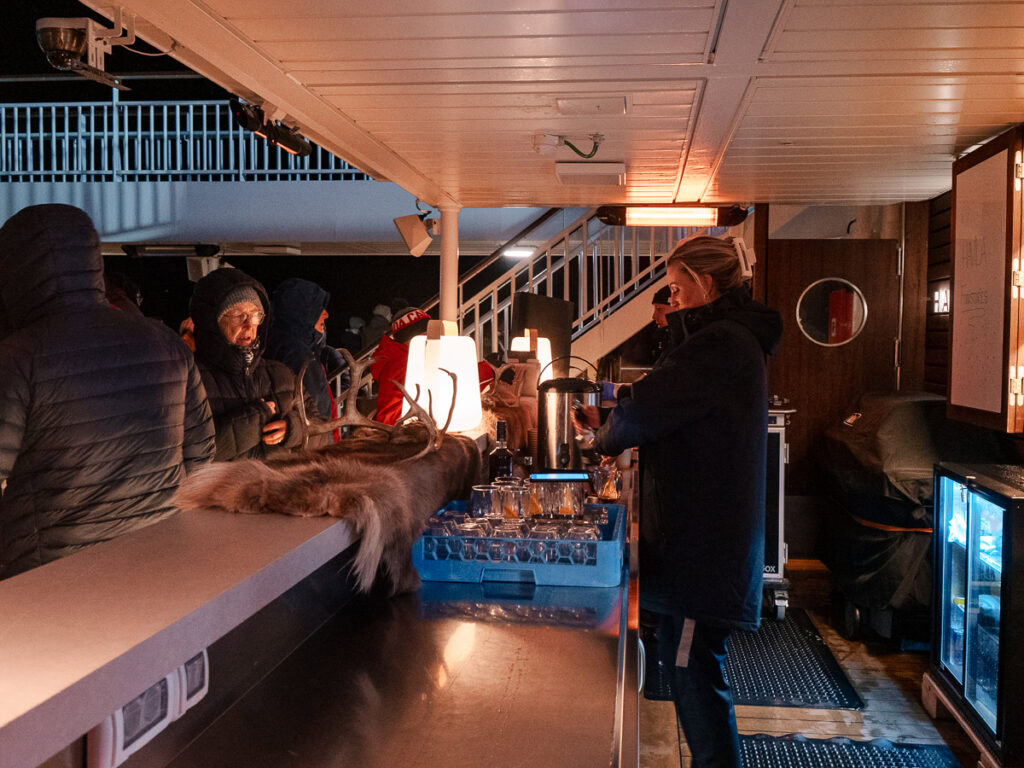
Non-alcoholic beverage packages:
- 30 units from 1995NOK (€165)
- 40 units from 2495NOK (€206)
- 50 units from 2995NOK (€247)
*NOK-EUR exchange rate as of 11 April 2025
After estimating our expected consumption rate we decided that paying for individual drinks would work out better value for all three of us.
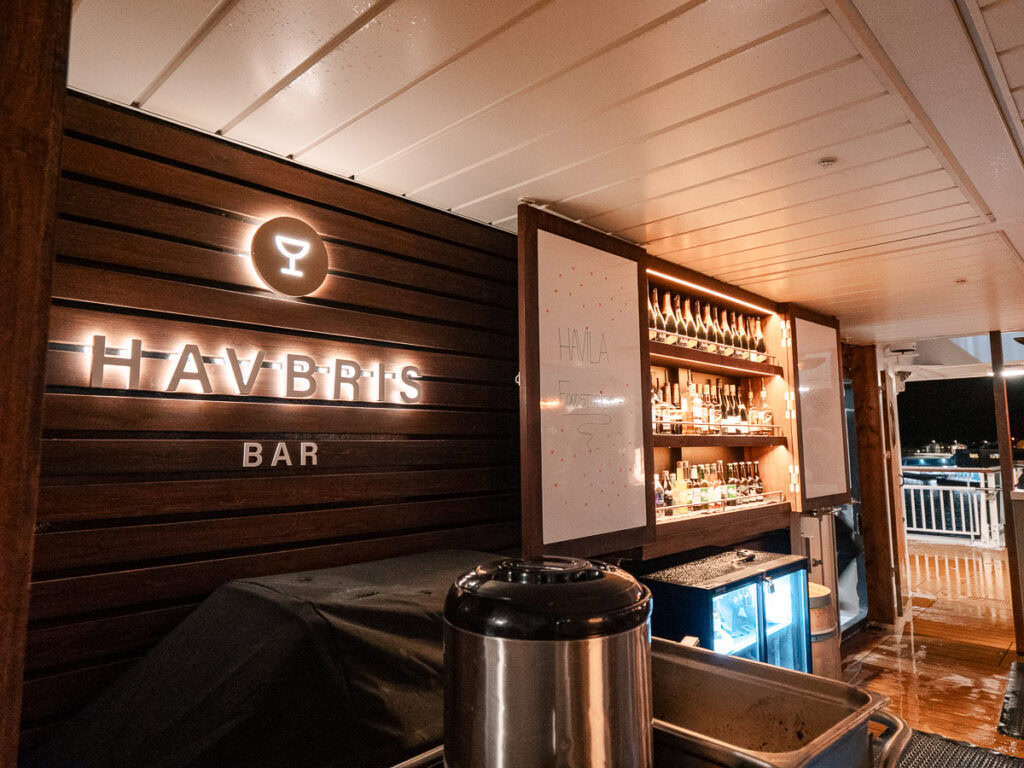
Havila Voyages excursions
You can tailor your Havila experience to perfectly suit your travel style by choosing the excursions you want to do along the way, and there’s loads on offer from cultural activities to active adventures to scenic road trips.
Excursion prices obviously depend on what the trip entails, but to give you a rough idea they start from around €45-70 for guided city walks and single-location activities like a musical performance or brewery tour, up to €200-390 for the full day tours or epic activities like snowmobiling, King crab fishing or dog sledding.

I did a few excursions during my time on the ship:
- Winter cruise to Geirangerfjord
- Reindeer sledding and Sami visit
- Magerøya Island ATV winter safari
- Dog sledding in the Arctic
- A taste of Vesteralen
I’ll tell you more about each of these in the day to day breakdown below.

Northern Lights
I’ve been very fortunate to see the mesmerising Northern Lights a fair few times on my travels in Iceland, Finland and Norway, but one of the reasons for this trip was because I wanted my parents to have the chance to see them.
We knew that visiting northern Norway in late November would give us a pretty decent chance for seeing the lights, but it’s always weather-dependent so you just have to cross your fingers and hope for the best.
Out of my ten nights on the ship, the aurora was visible on…
*drum roll*
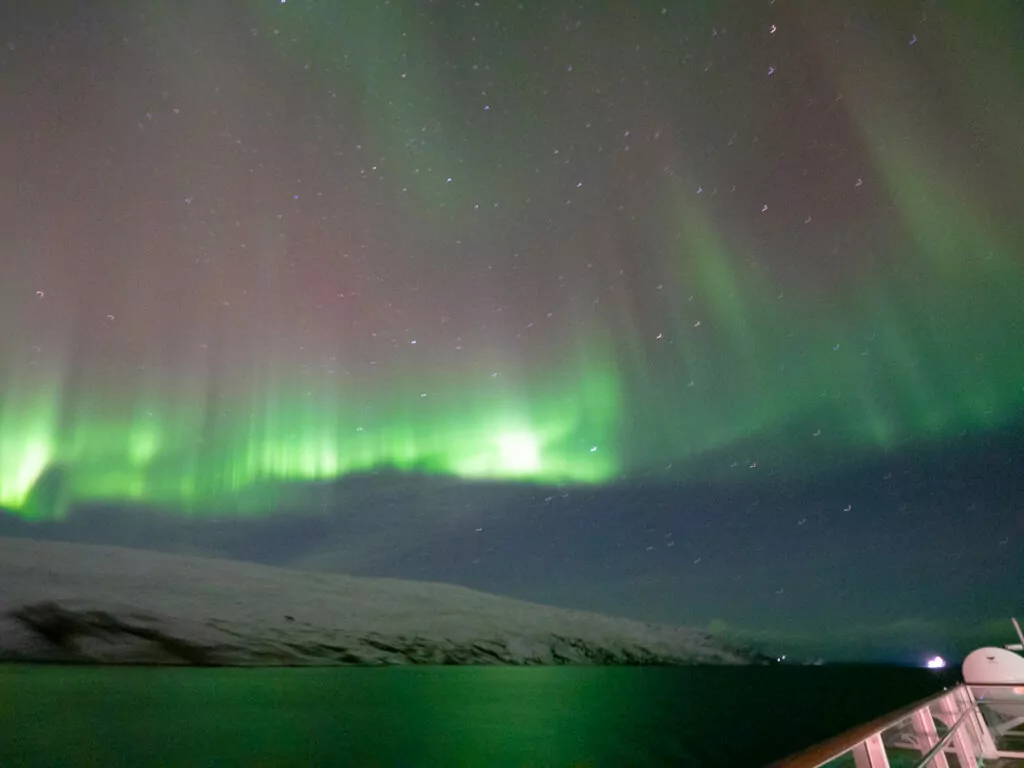
FIVE NIGHTS!
And three of those nights were particularly insane, with huge cloudless skies and dancing lights for as far as the eye could see. Just magical.
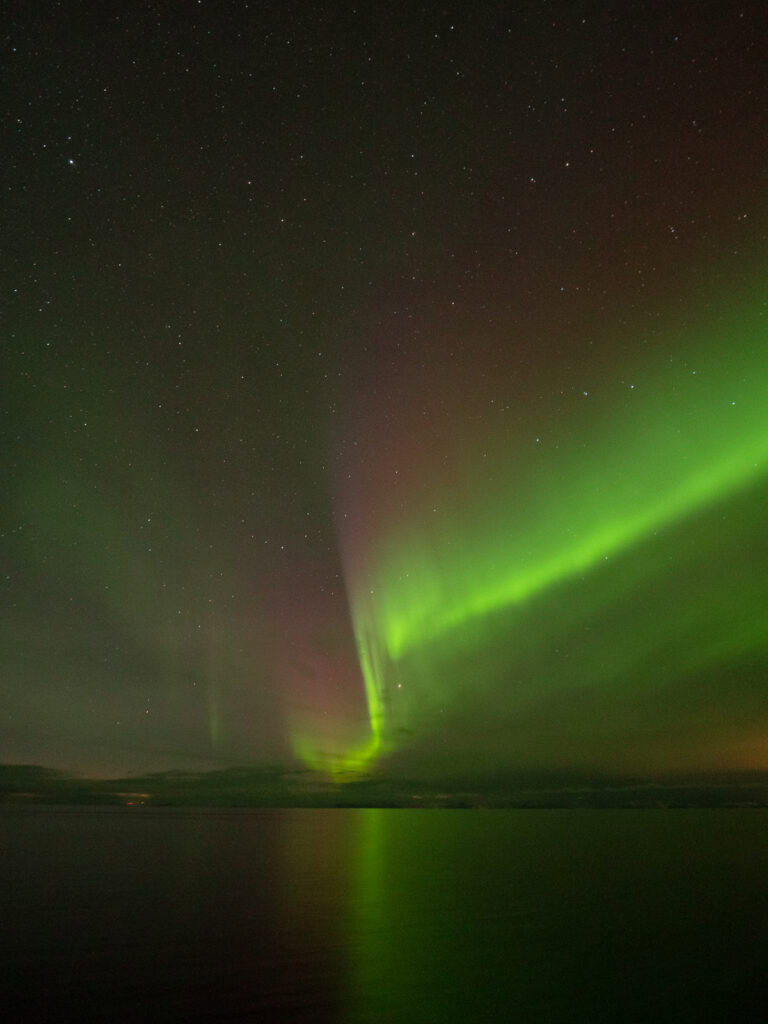
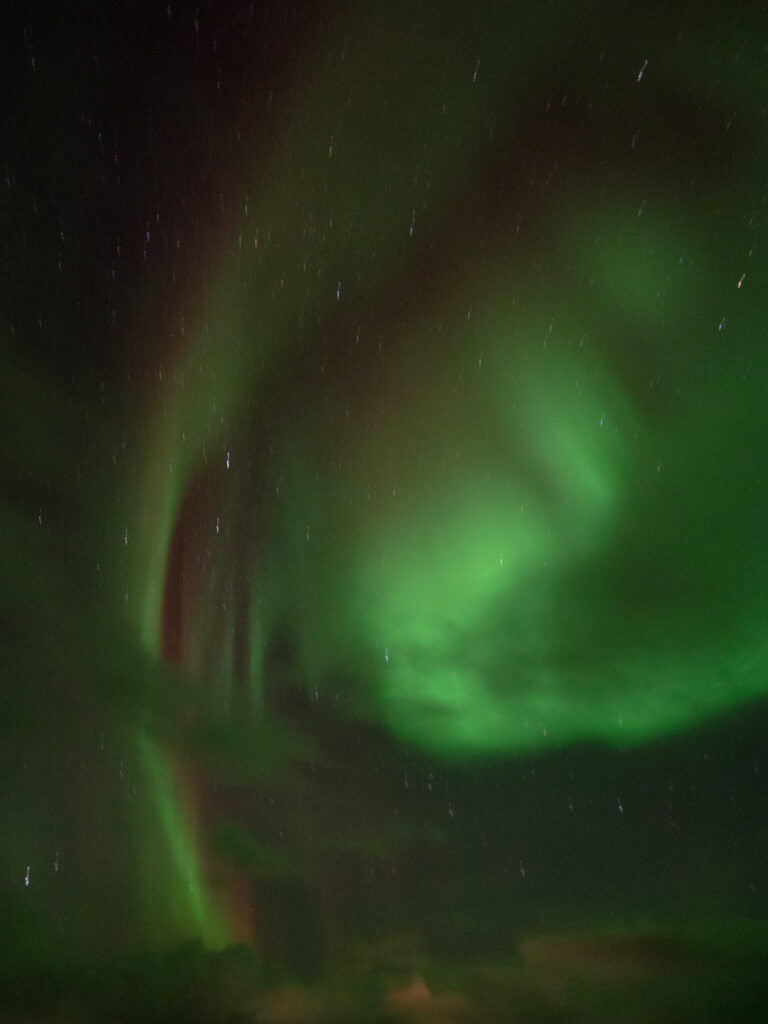
The best bit is that you don’t need to be constantly keeping an eye out either, you can turn the Northern Lights alert on on the phone in your room, and they’ll put out an announcement when the staff spot the lights from the captain’s deck. If you’re not fussed and don’t want to be woken up then turn the alert off, too easy.
Havila actually has a Northern Lights Promise from 1 October to 31 March, so if you book a Round Voyage between those dates and the Northern Lights don’t come to the party, you’ll get a Voyage South or Voyage North sailing for free to try again next time (but I’d say this is very, very rare).
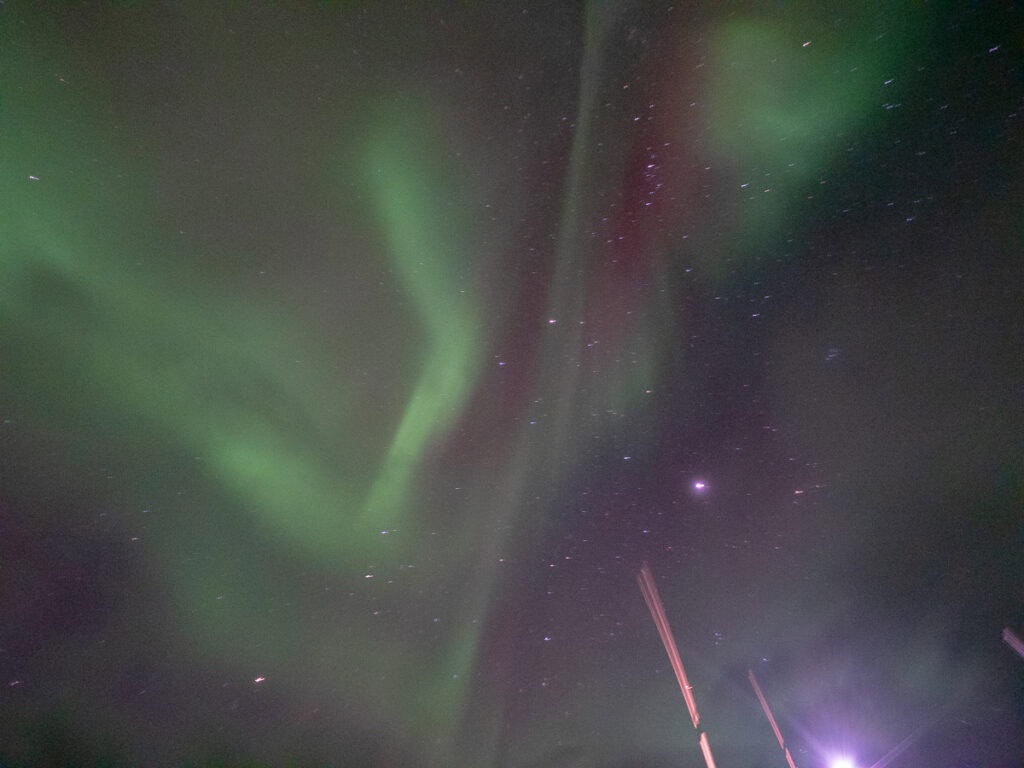
Entertainment on the ship
Unlike traditional cruise ships, there’s no entertainment on the Havila ships. No karaoke bars, no magicians, no comedy shows.
The entertainment here is the scenery, so just sit back, relax, bring a good book or download a show to watch while you enjoy floating along the Norwegian coast.
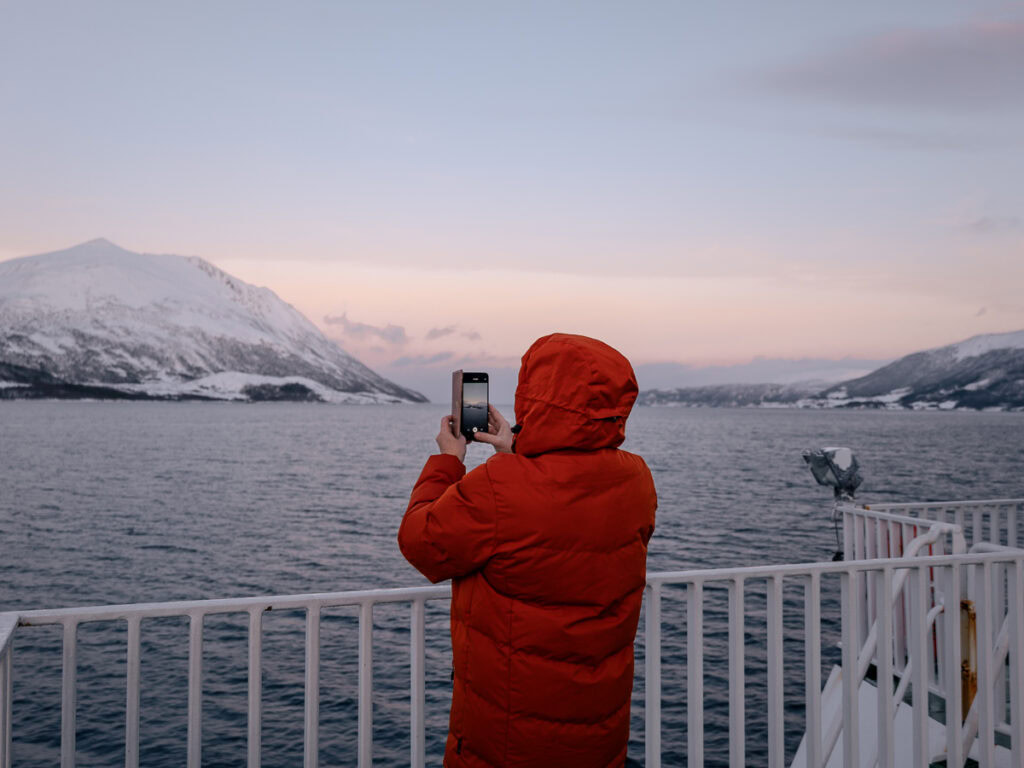
Havila Voyages coastal route day by day
Day 1: Check in in Bergen
After a solo trip to Copenhagen I caught the train to Oslo (via Gothenburg), where I met up with my parents who had just flown in from New Zealand. I had somehow managed to convince them to leave an incoming Kiwi summer and travel to the opposite end of the world for below freezing temperatures and a few hours of sun a day 🙃
After a night in Oslo we jumped on the train to Bergen the next morning, free for me with my Eurail Pass (read my Eurail guide for more info) and €122 each for my parents to join me in the first class cabin. The scenery is brilliant on both sides but I reckon the left side takes the cake.
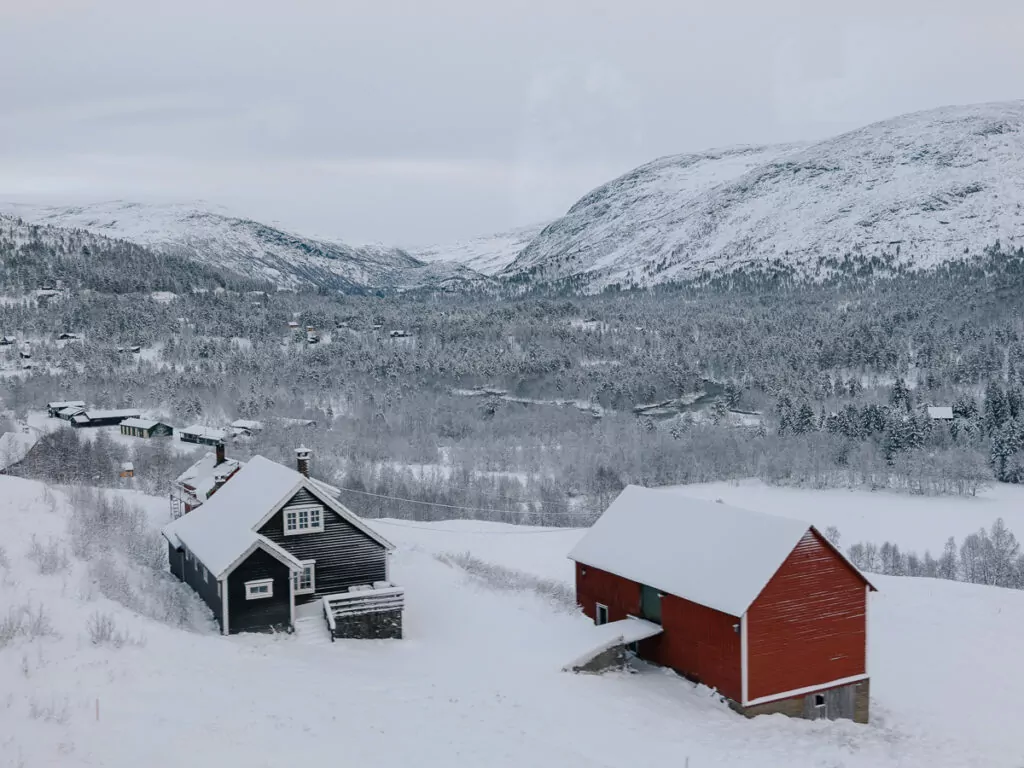
In Bergen we caught an Uber from the station to the Havila terminal, checked in as I already explained above, left our day bags in the lockers and did a short walk around Bergen before coming back to the boat once our rooms were ready.
None of us had been on a cruise before so the concept of set meal times was a bit of a surprise and took some getting used to, I don’t think it was explained particularly well because the other people in line for the restaurant all seemed a bit confused too, this could be made clearer at check in.
Our first dinner was a good intro to Norwegian cuisine, we went heavy on the seafood! I had porcini mushroom soup, poached salmon and strawberry rose sorbet.
Evening one was pretty chill because Dad and I had a huge day to prepare for on day two.
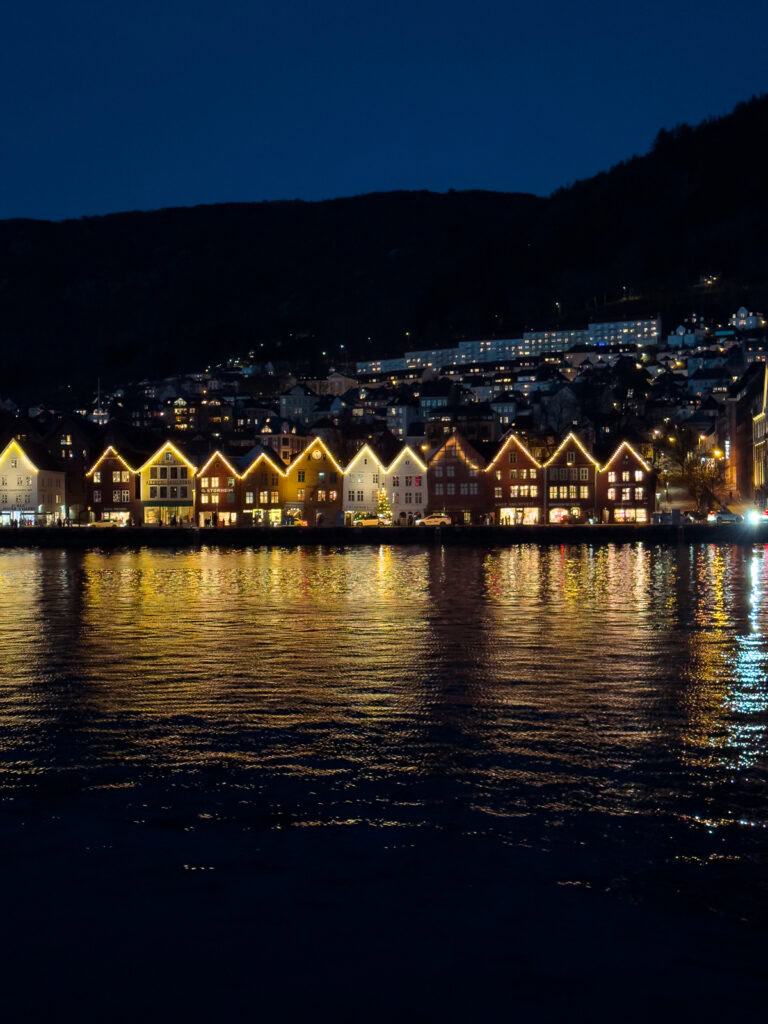
Day 2: Geiranger Fjord excursion
We woke up early to grab breakfast and get prepared for a father-daughter day out on the winter Geiranger excursion, an absolute must-do on the Norwegian Coastal Route!
In summer the Havila ships can sail all the way into the UNESCO-listed Geirangerfjord, in the cooler months this isn’t possible but you can still reach it with an excursion on a smaller boat.
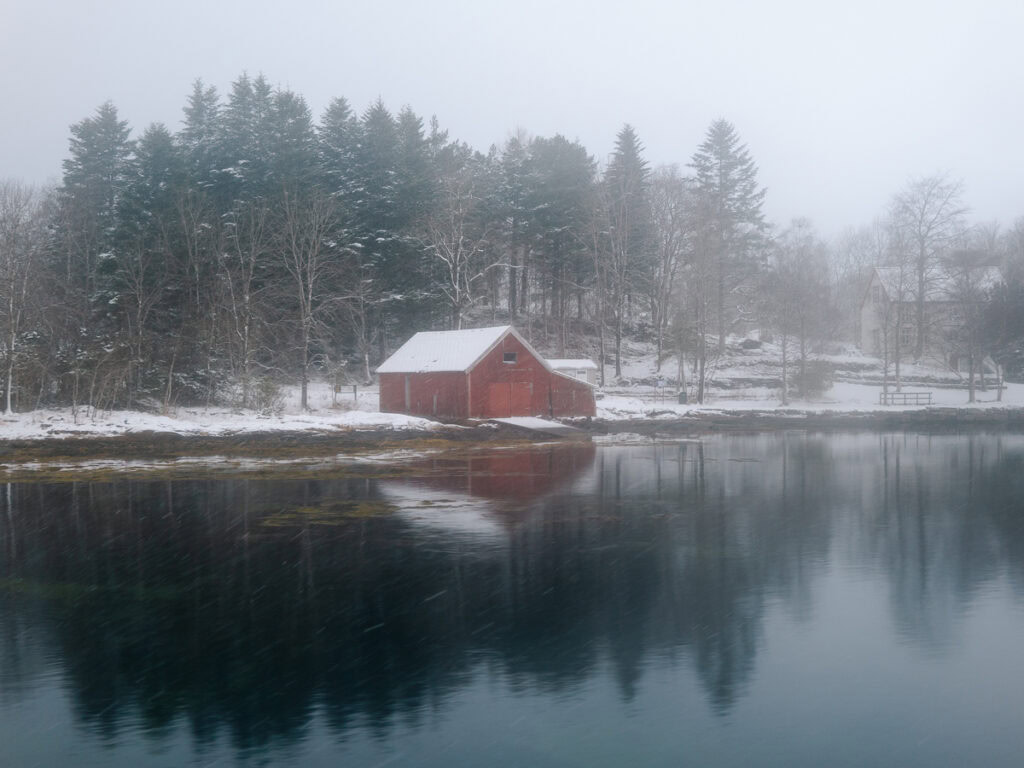
It was a 15 minute walk in the snow from where we’d docked to the small ferry for the three and a bit hour journey to Geiranger, it was foggy and sleeting but the Fjordrangers (the tour guides, love their name!) told us that the weather often clears as we reach the fjord.
And they weren’t lying!
The high clouds didn’t budge but we were treated to the most picture perfect, winter wonderland scenes as we made our way past dramatic snow-covered mountains. It was icy and chilly on the top deck of the boat (-7°C!) but I couldn’t bring myself to go inside, these photos don’t even do it justice.
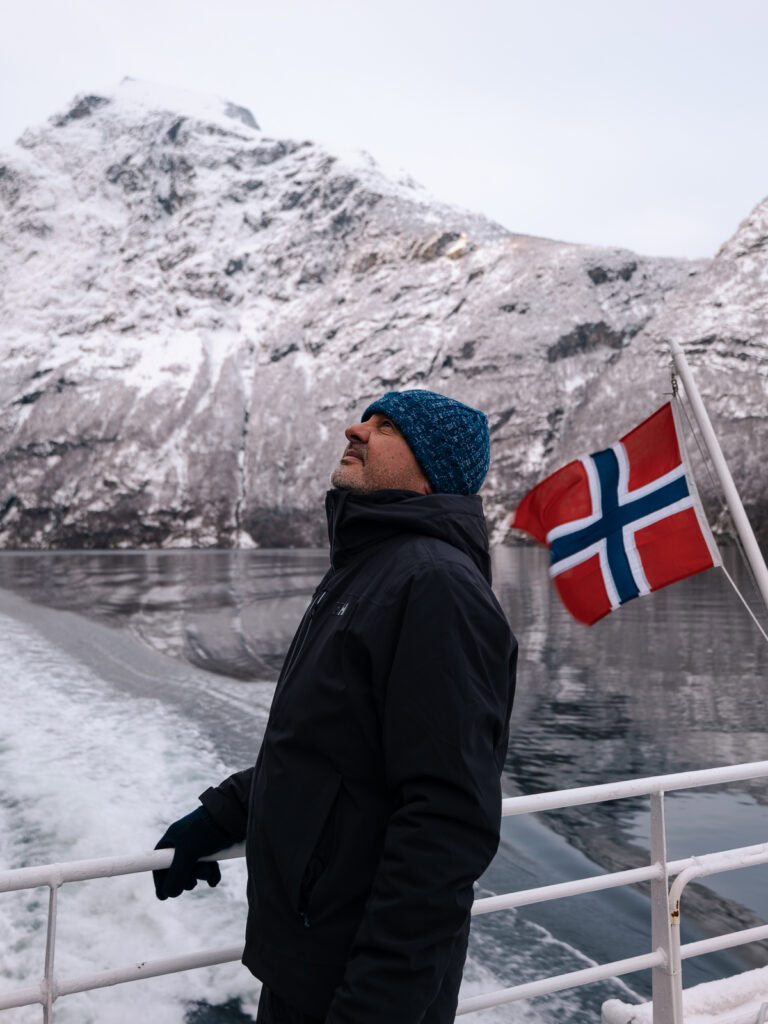
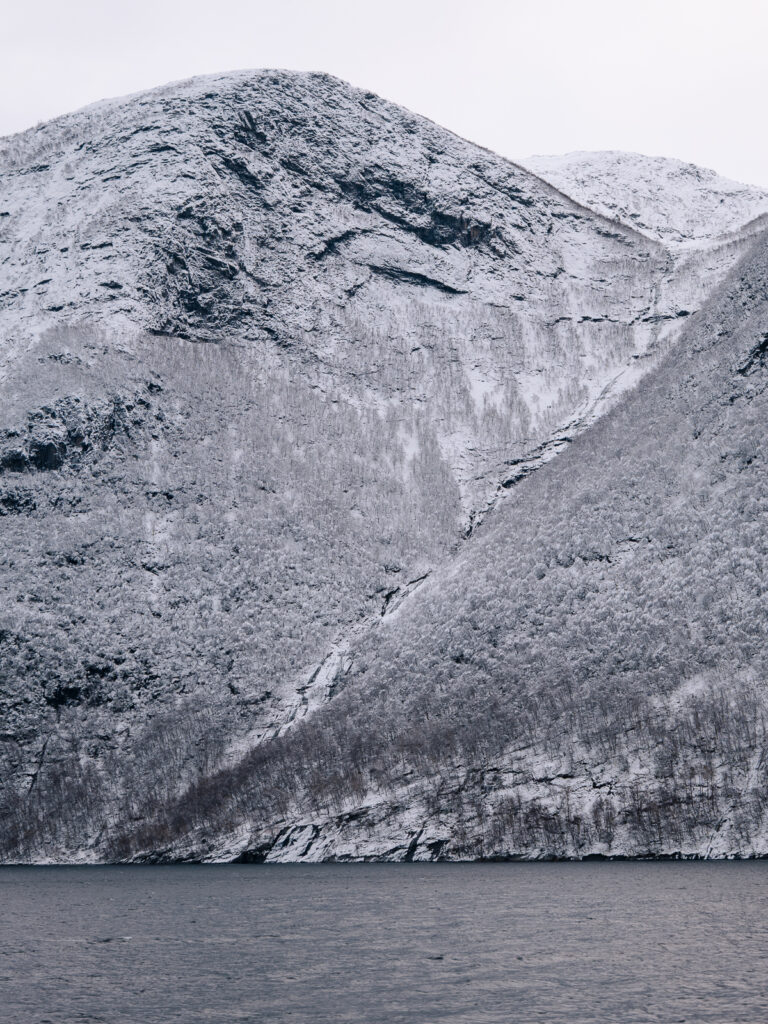
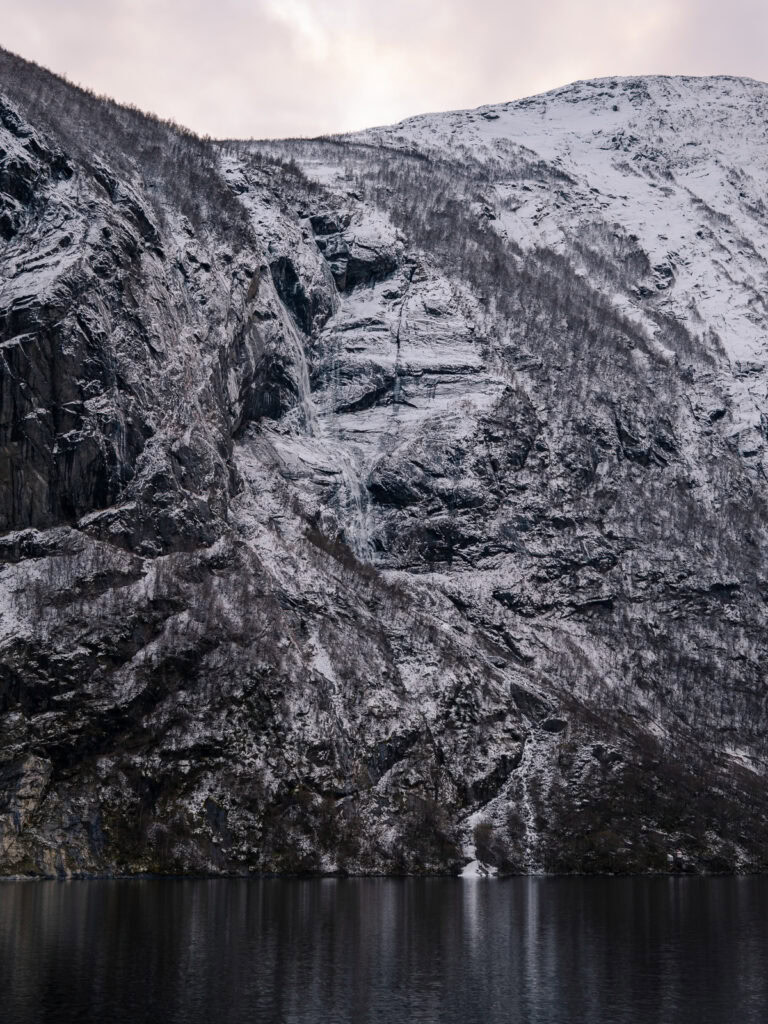
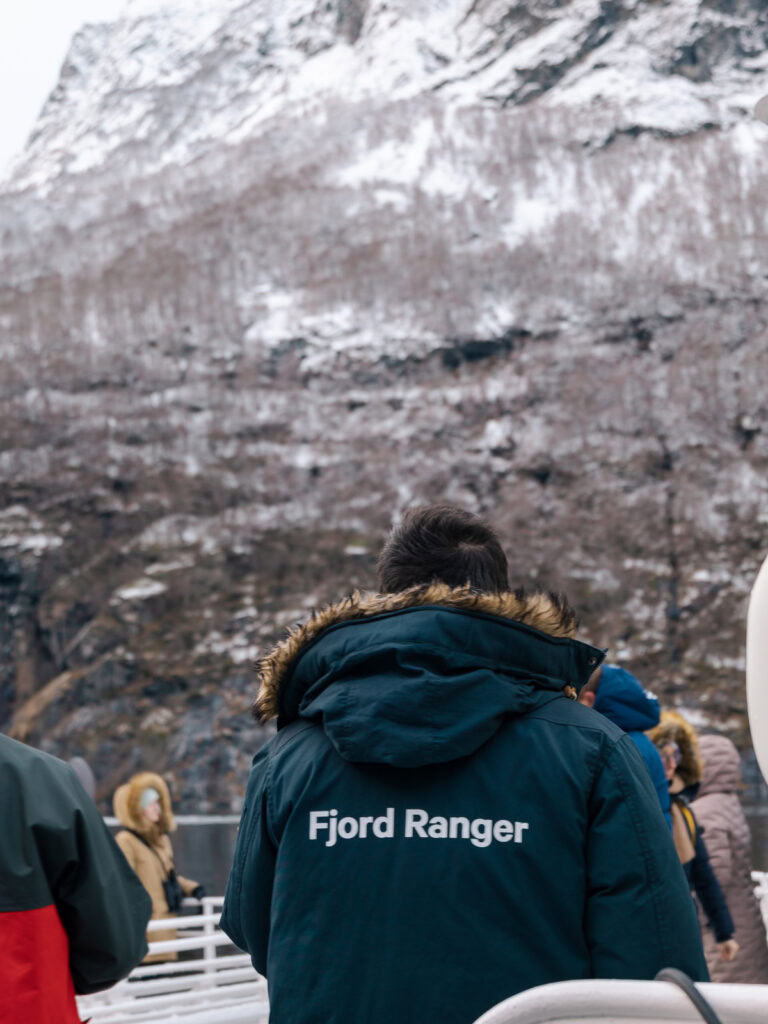
As we got deeper into the fjord, the conditions calmed down and the water turned to glass. My jaw was on the (very cold) floor. Lunch was included on the way to Geiranger but I was too busy taking photos to eat it.
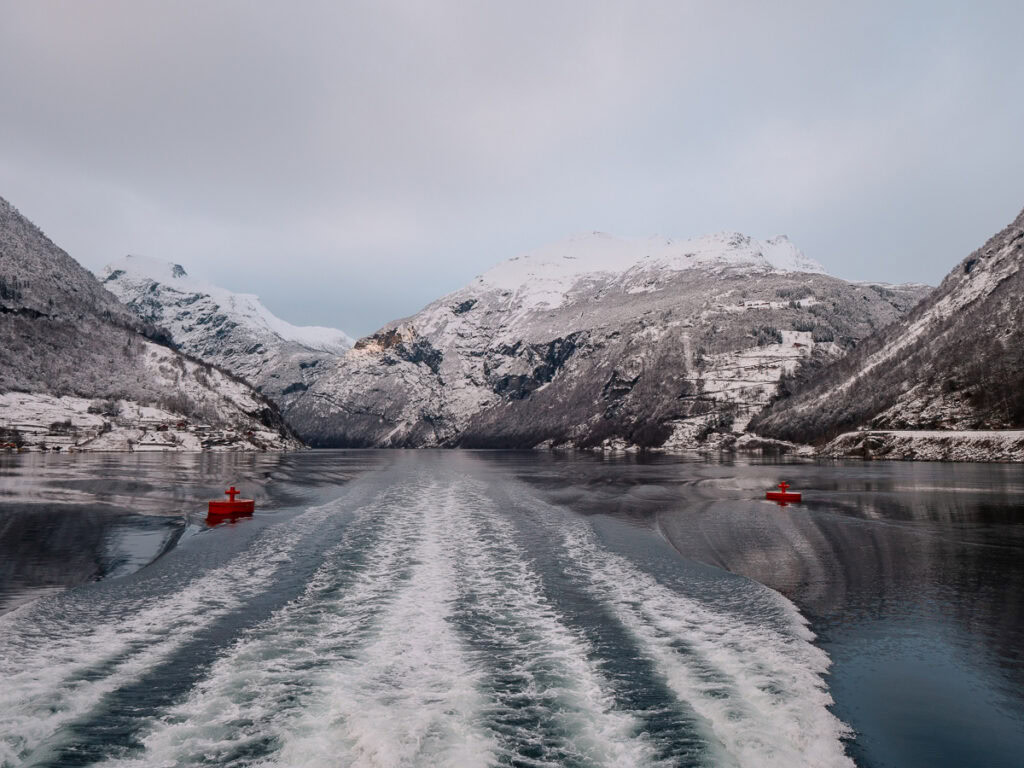
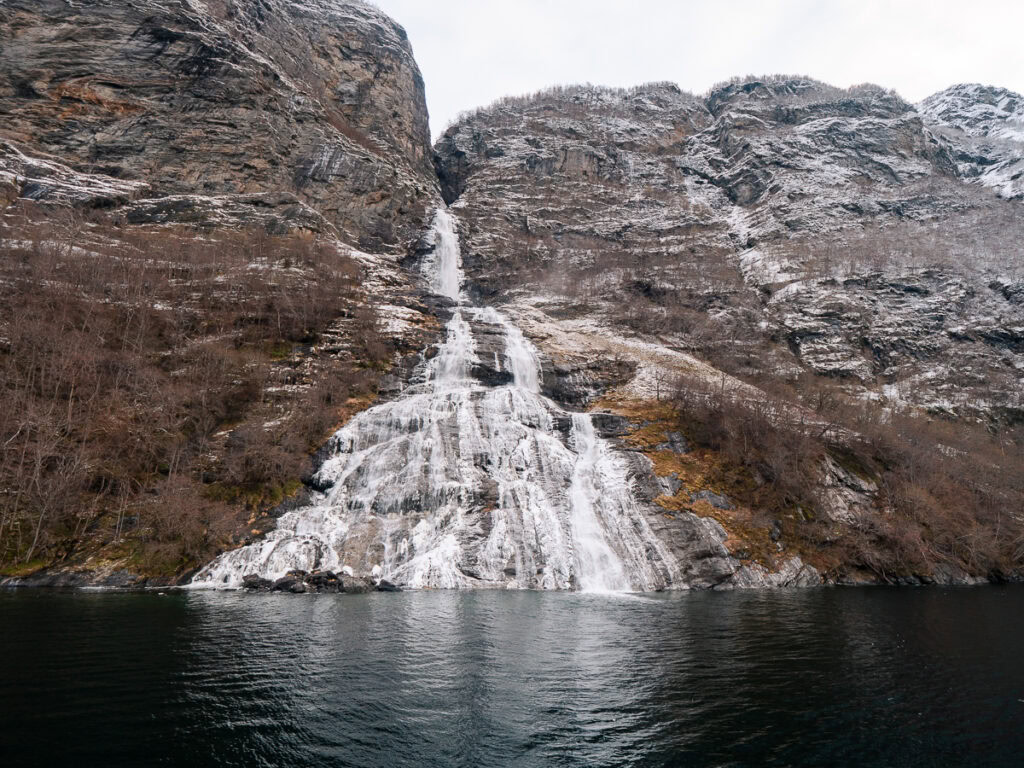
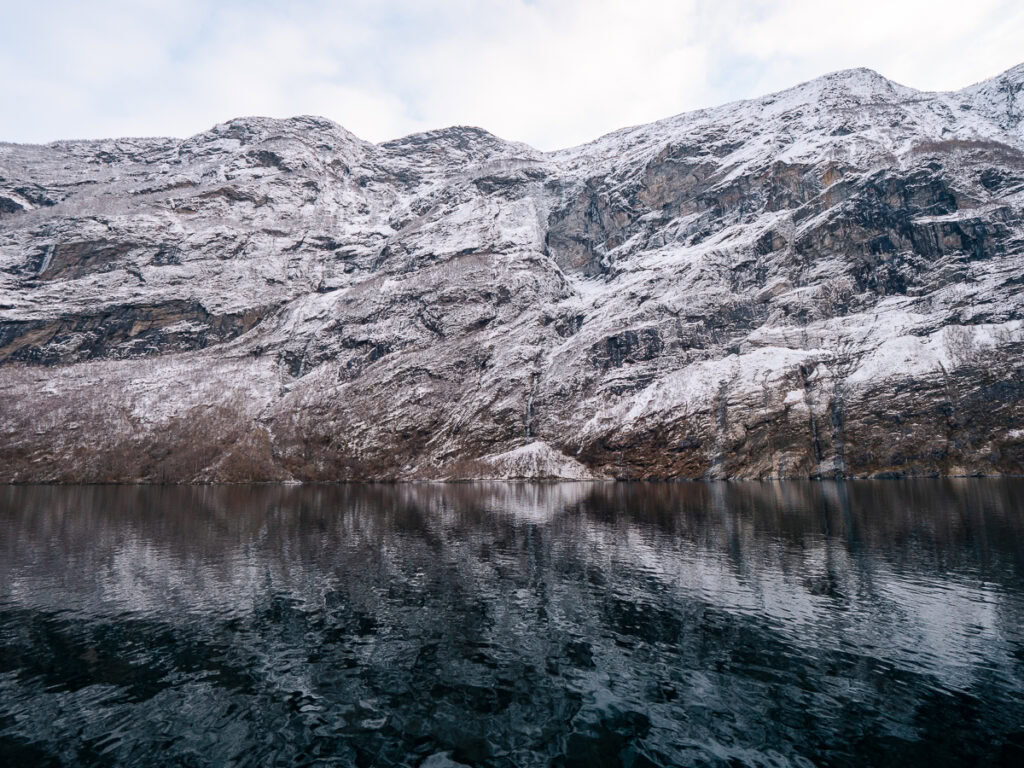
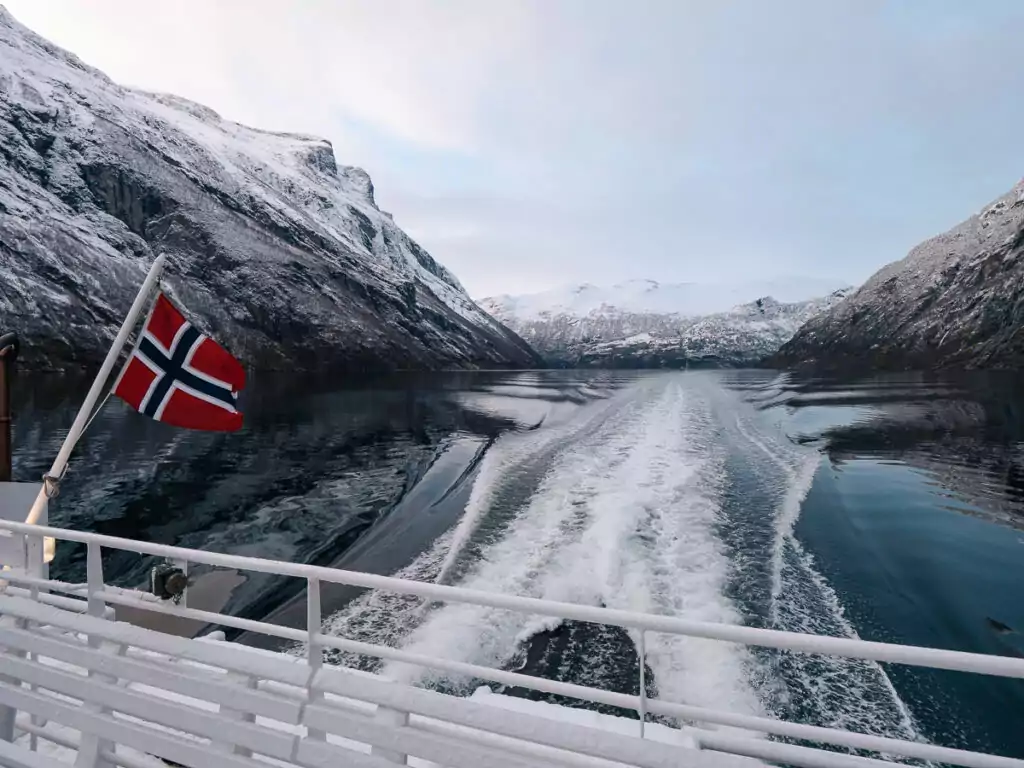
On arrival at the dock we jumped onto buses for a short drive up the zigzag road to reach this epic viewpoint overlooking where we’d just sailed through. I’m desperate to come back in summer and see the difference!
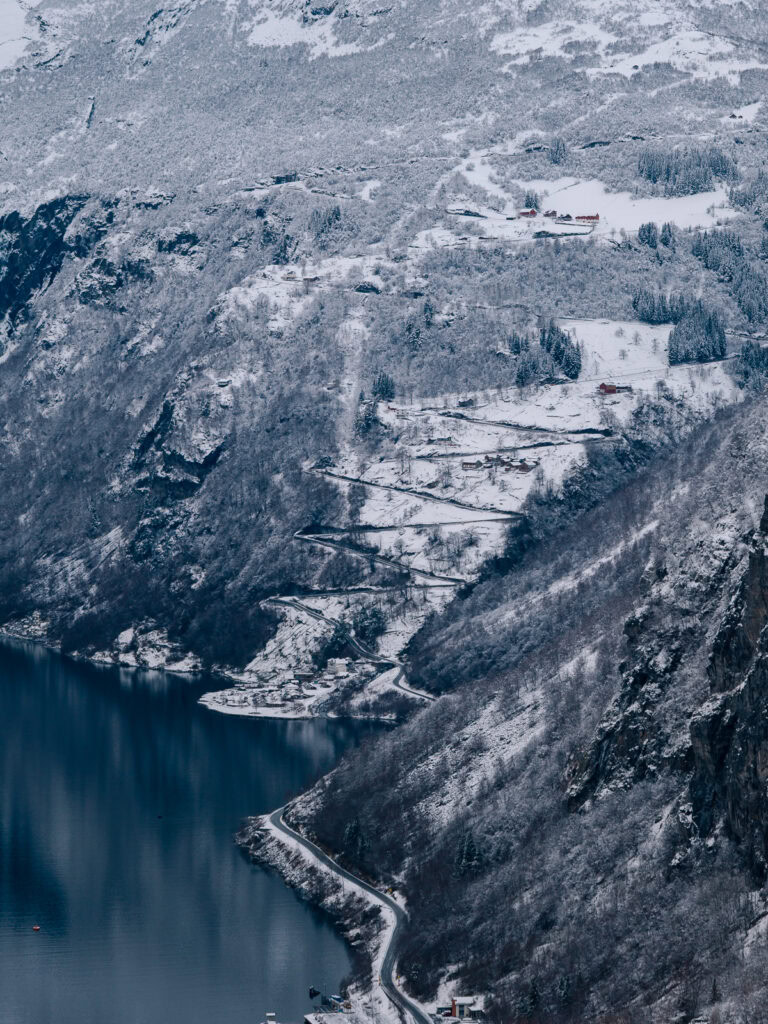
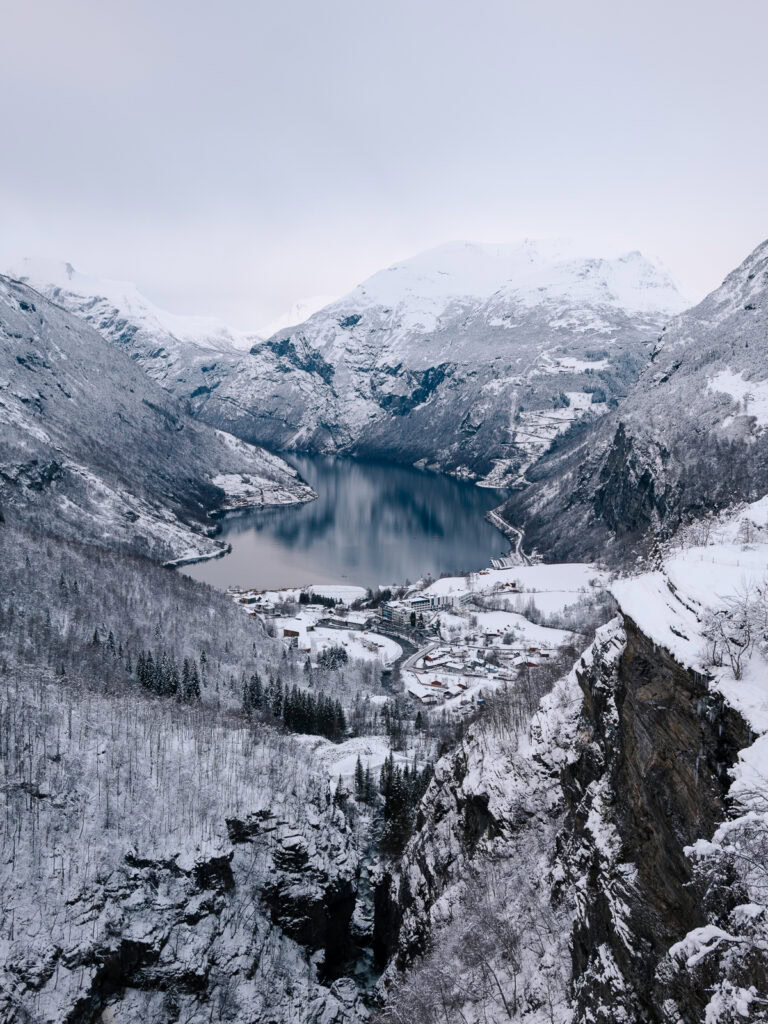
Next was the Norwegian Fjord Centre for a short film about the fjord and its history, plus a wander through the displays of local culture, housing and clothing, and time for a hot drink or a spot of gift shopping.
There was an option to walk or bus back down to the boat, we chose to walk the slightly precarious path along a big stream and its waterfalls, dodging the slippery ice along the way.

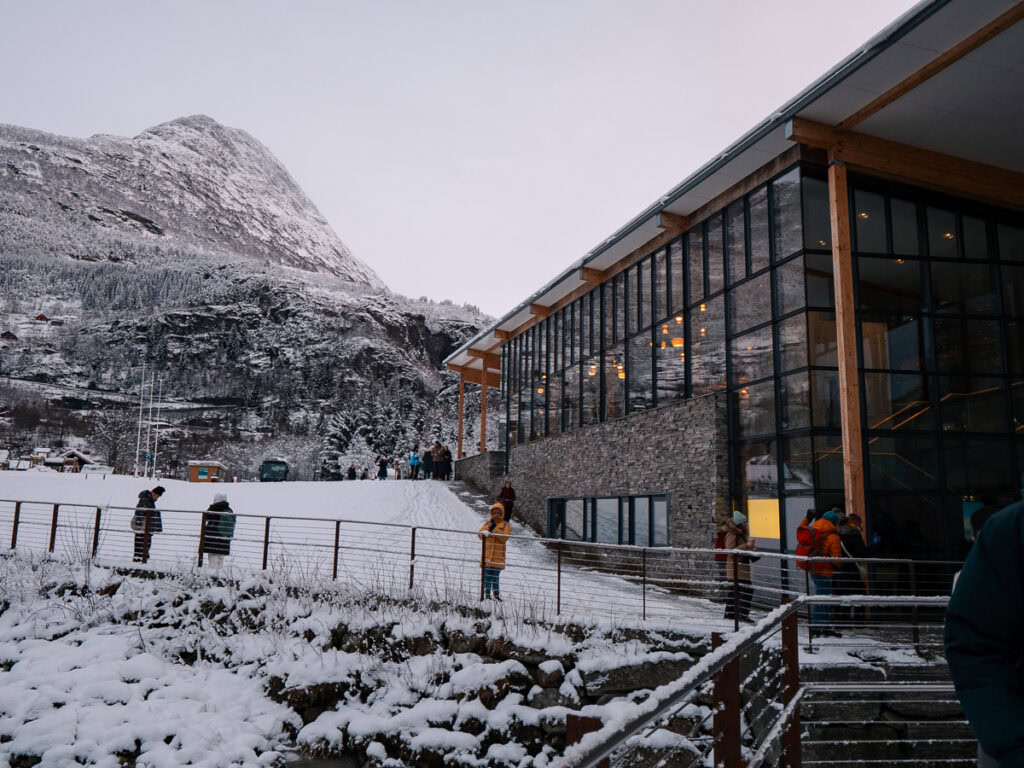
On the boat we got an afternoon snack box which was actually one of the food highlights of my trip! It had lots of local treats in it like smoked trout and salmon, cheese, a variety of cured meats and potatoes. The cured meats were SO GOOD, I wish I’d noted down what they were so I could buy some!
It was about 2.5 hours to get back to our ship from Geiranger where we caught up with Mum for dinner, no aurora sightings tonight either.
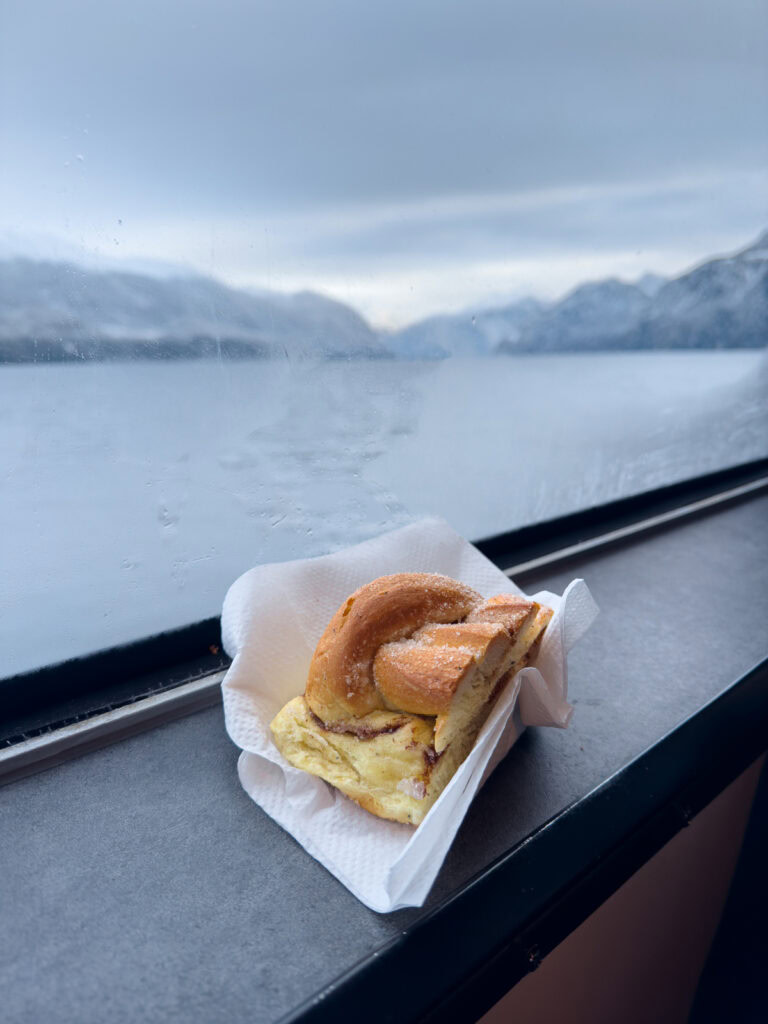
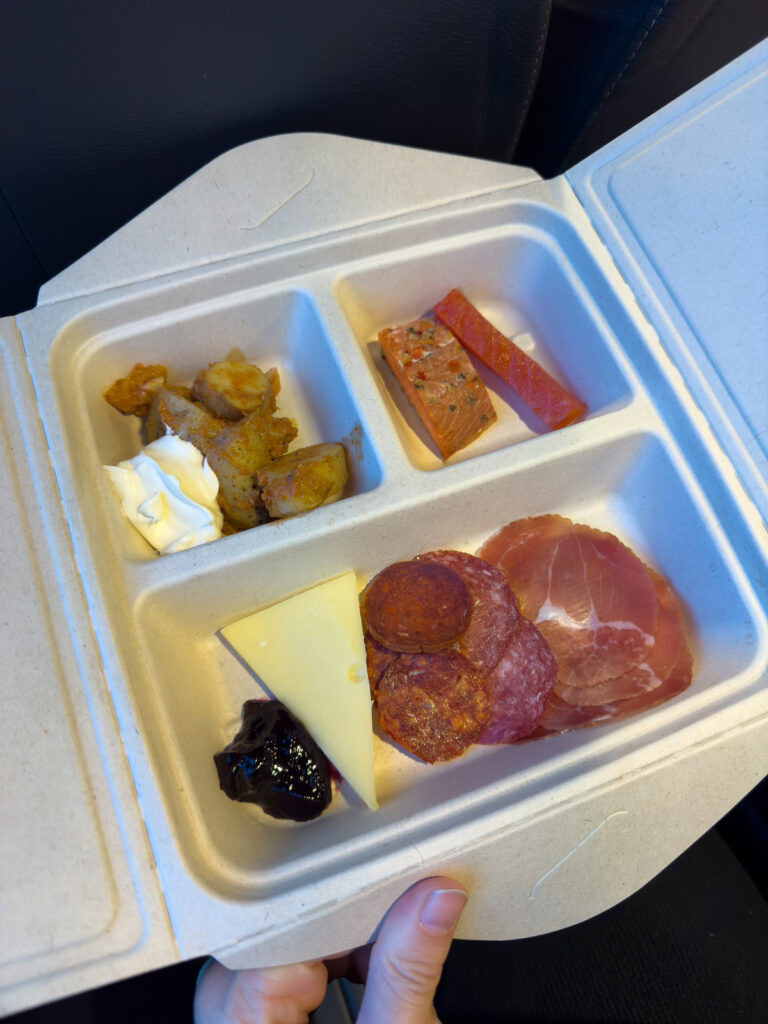
Day 3: Trondheim day visit
Trondheim is the second-largest city on the route (after Bergen), and on the northbound journey the ship stops here from 9.45am to 12.45pm, enough time for one of the excursions or some independent exploring.
The activities on offer were a vintage tram tour, city walk, boat ride or bus tour to the Nidaros Cathedral, but Mum and I decided to do our own little photo walk and got some amaaaazing shots of the coloured buildings lining the waterways.
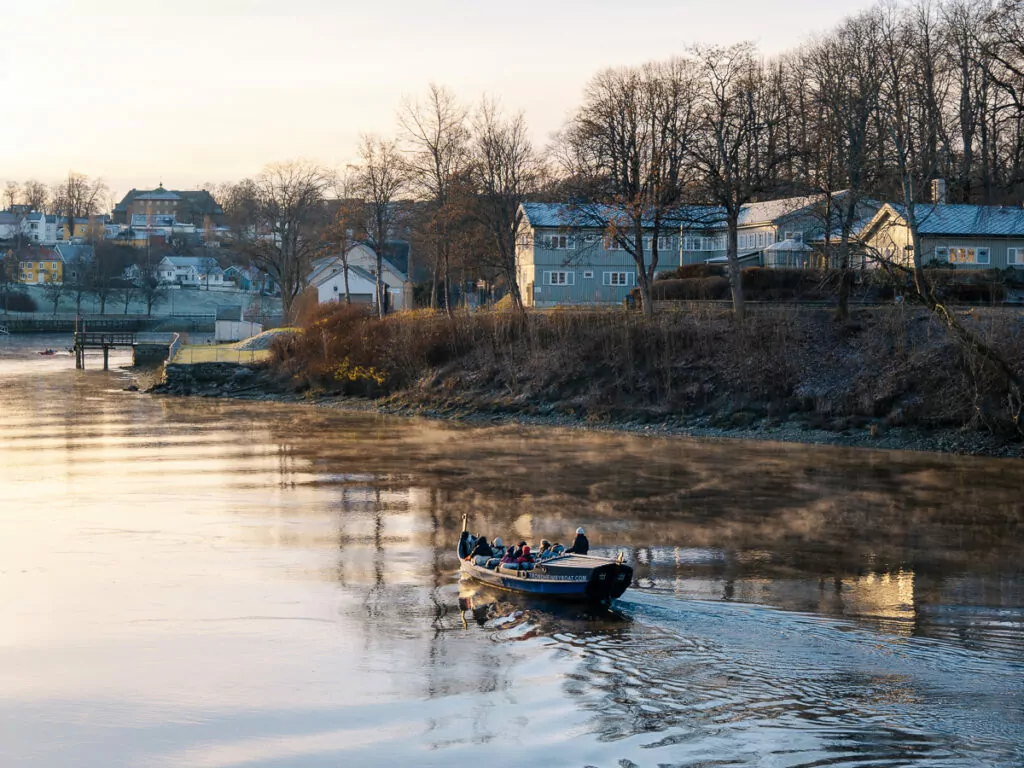
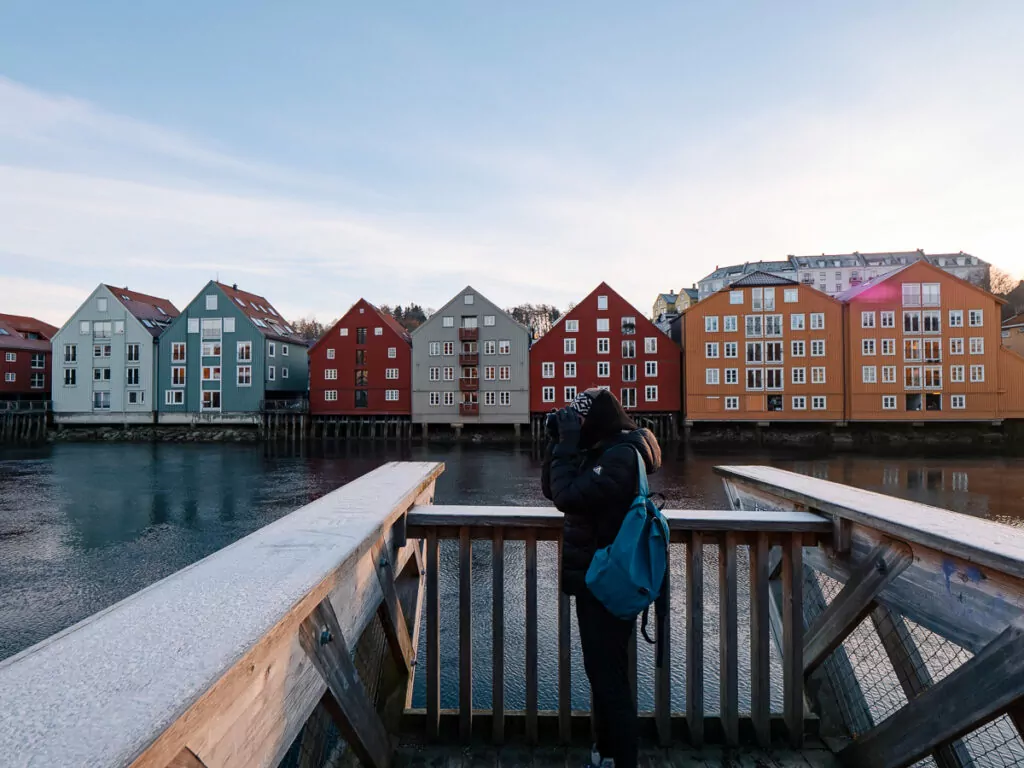
Christmas markets in Trondheim start on 3 December so we just missed them, but they’re meant to be incredible so if your trip aligns make sure you factor this into your plans!
We were back on the ship for lunch, my first foray into Havila’s lunchtime dining as I’d been on an excursion the day before. I love the small plates idea, I’m a small portions kinda gal (but constant snacks 🙃) so being able to try a few different things instead of getting one heavy meal is perfect for me.
My first choices were braised beef with mashed potato, broccolini with hollandaise, and crispy potatoes with parmesan.
Each day the Havila crew run a little guest meet up at Havbris Bar on the outdoor deck, with the opportunity to taste Norwegian treats and learn about local culture, history and traditions.
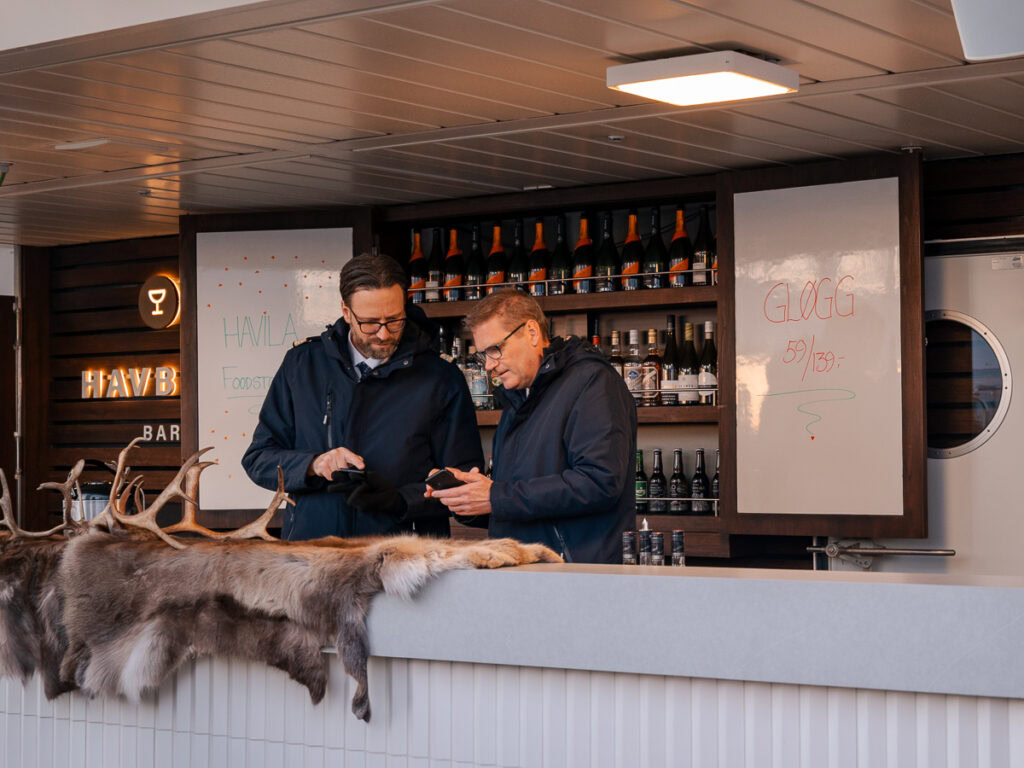
No aurora on day 3 either, still time to go but I was starting to get nervous. I didn’t want Mum and Dad’s long journey to not meet their expectations!
Day 4: Crossing the Arctic Circle, Bodø & something extra special
One of the best things about visiting Norway at this time of the year is that the lighting is so soft and beautiful for photography, with the sun sitting in the lower sky or just below the horizon for all the daylight hours. The photos from the boat this morning were some of my favourite from the entire trip! Shout out to my parents for letting me commandeer their balcony for a few hours.
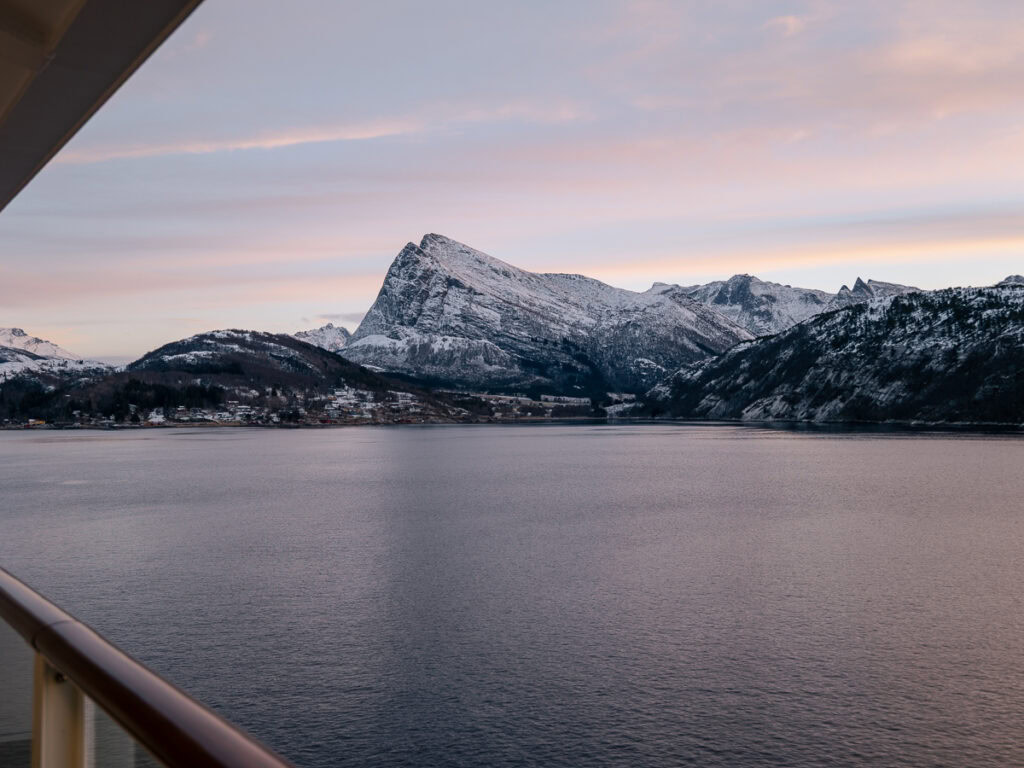
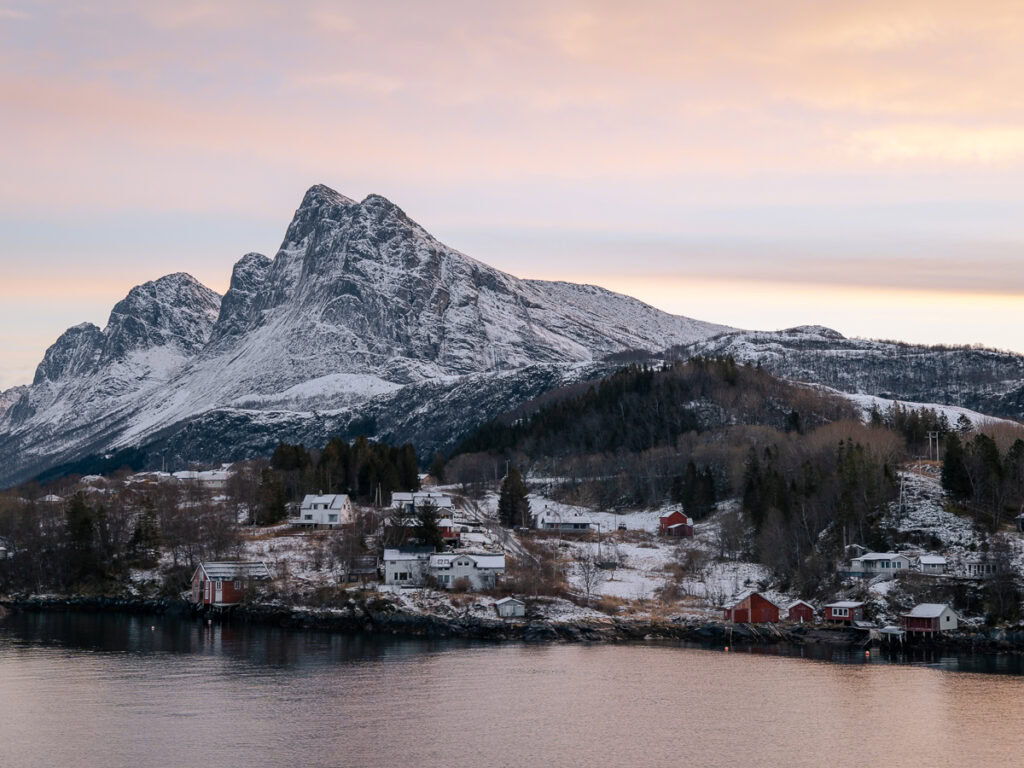
The Havila crew had a special get together on the top deck to celebrate our crossing of the Arctic Circle, and the guest of honour was Njord, the god of the sea in Norse mythology. What better way to start our Arctic Circle era than by having the god of the sea pour ice cubes down the back of our winter jackets?!

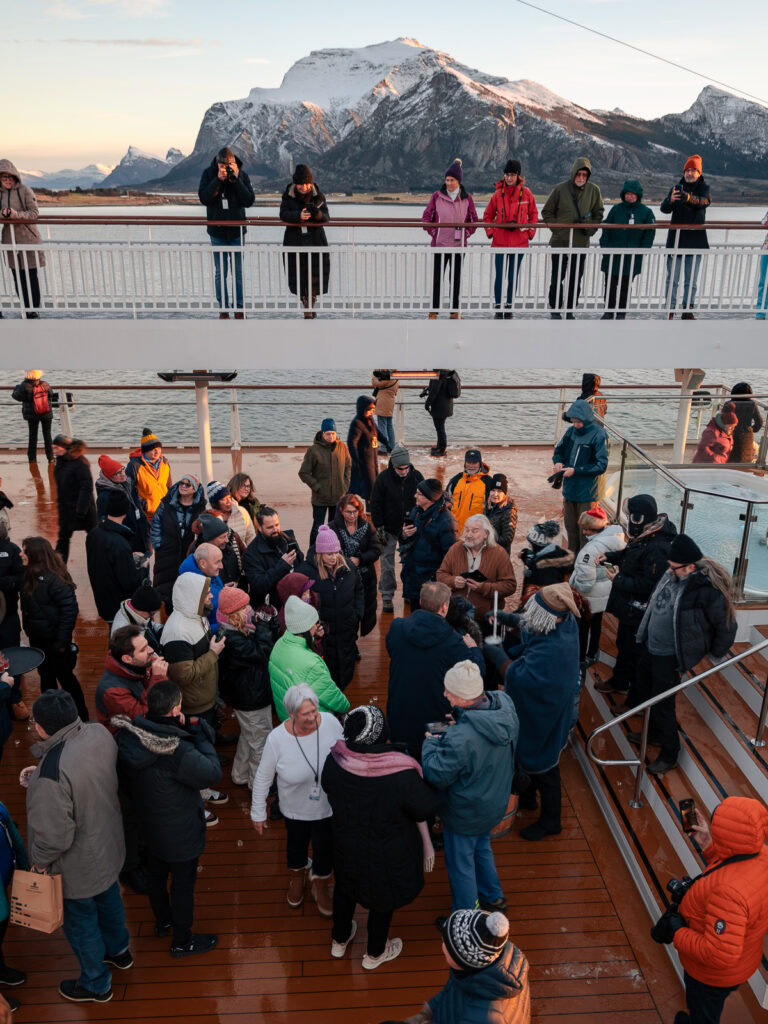
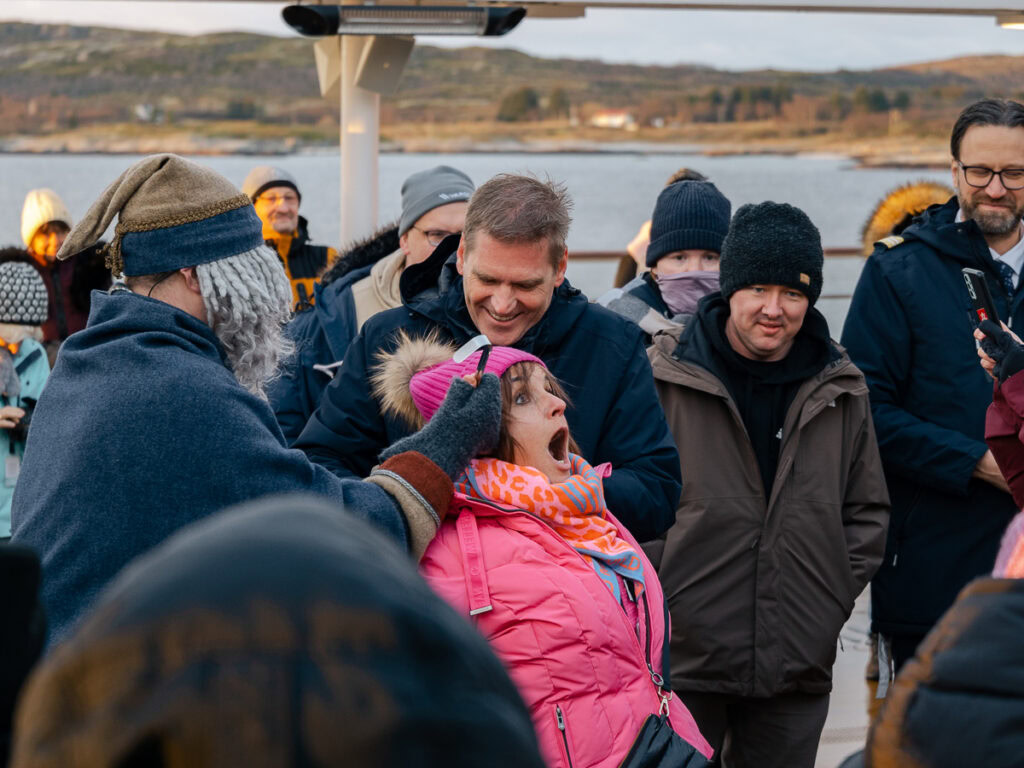
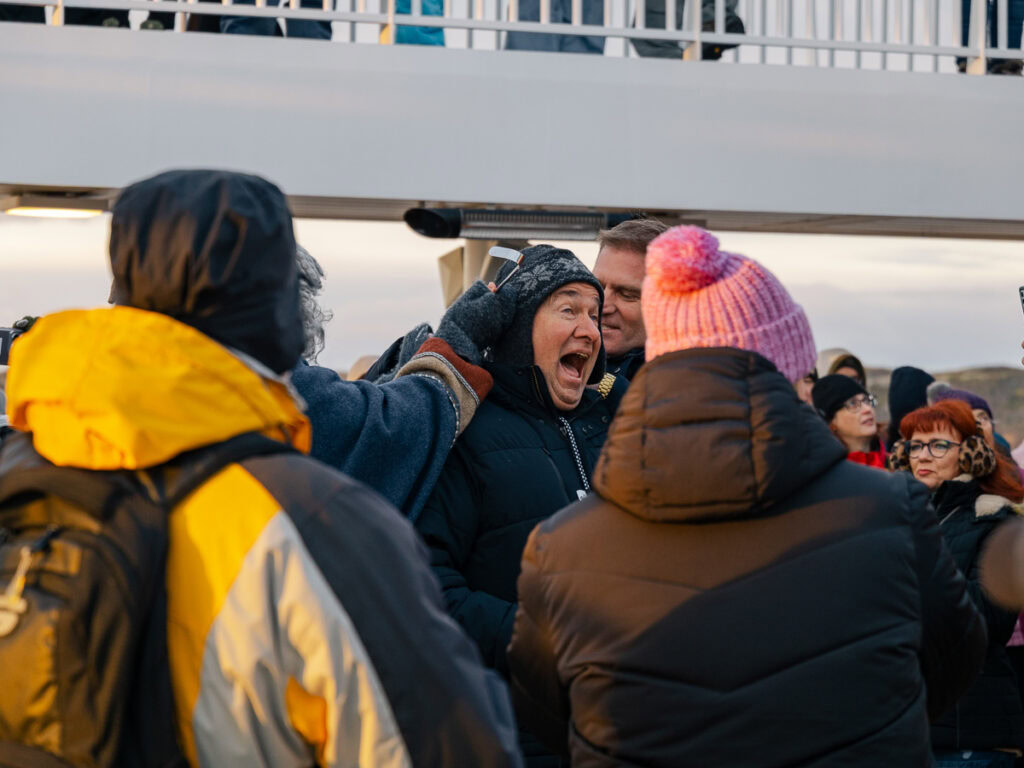
I’m an absolute wimp when it comes to the cold (sorry Wim Hof) so I used photography duty as an excuse to capture the crazy people partaking in this ritual, rather than being one of the crazy people myself.
We had lunch just before we pulled in to Bodø, one of Europe’s Capitals of Culture in 2024. Bodø is best known as the gateway to the Lofoten Islands, it’s usually just a transit point between the train from Trondheim and the ferry over to the islands but it was cool to spend a couple of hours wandering here.

We arrived at 1.05pm and had two and a bit hours to explore the city, discovering some impressive street art along the way.
I was tempted by an excursion in Bodø which included a bus tour through the city and then travelling onwards to Saltstraumen, where you can see the world’s strongest tidal current and the giant whirlpools it creates. I decided against it only because I realised I’d underprepared for the Arctic temperatures and needed to get some proper winter pants, and Bodø was the last stop with a cheap (for Norway) outdoors store!
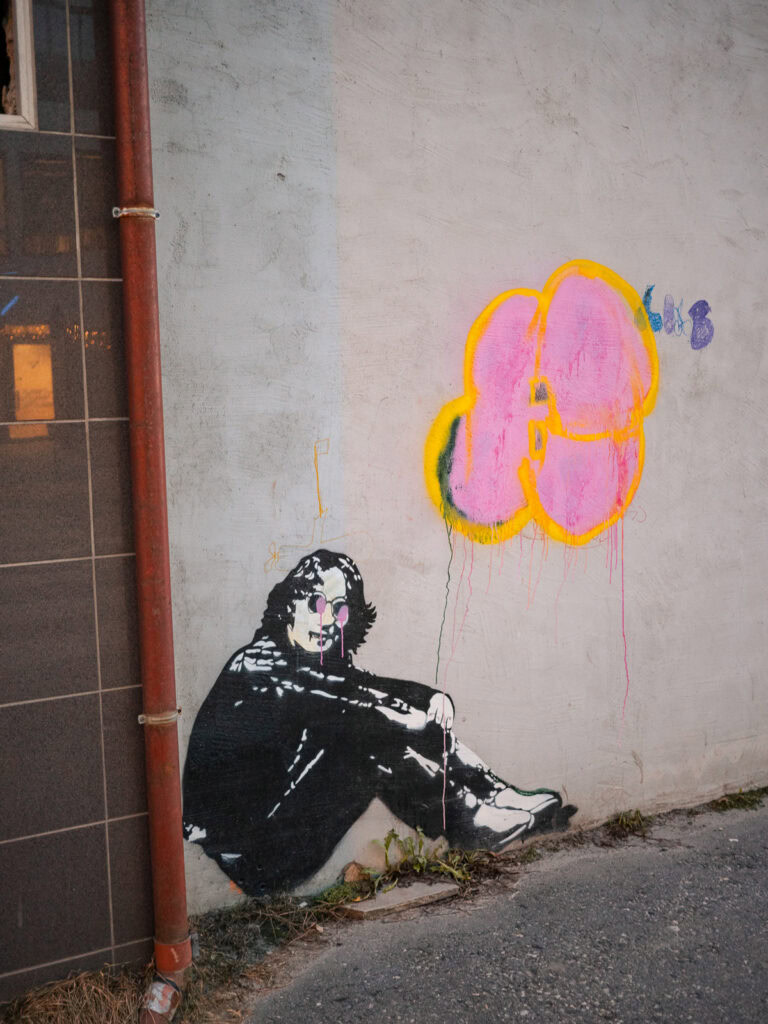
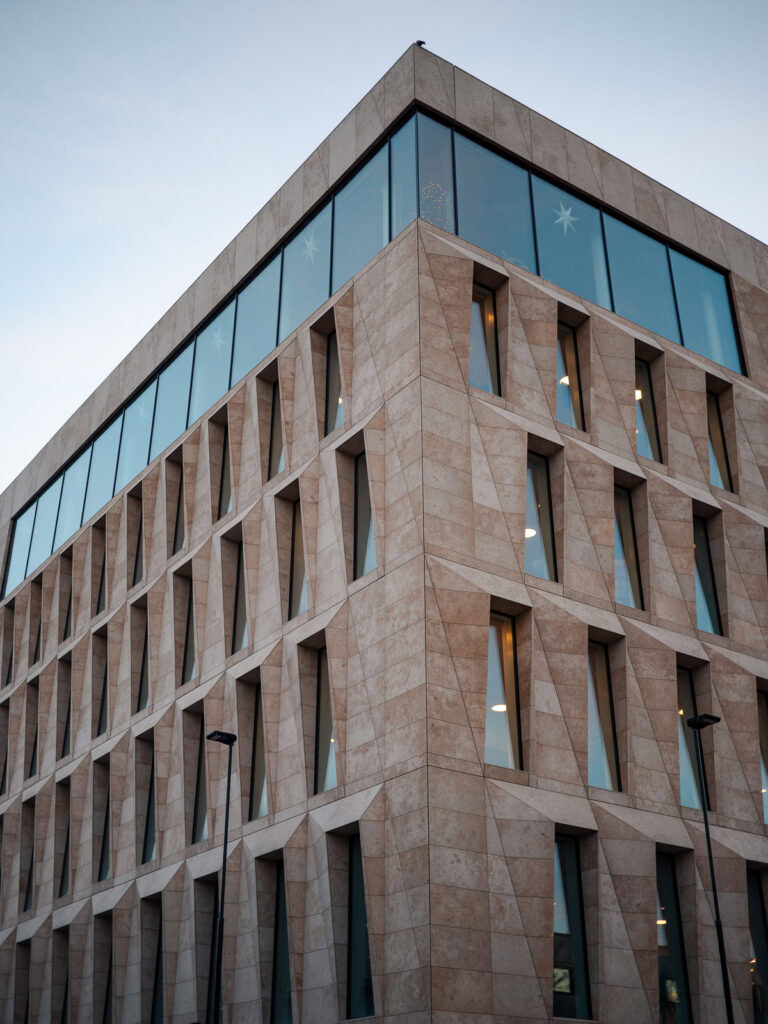
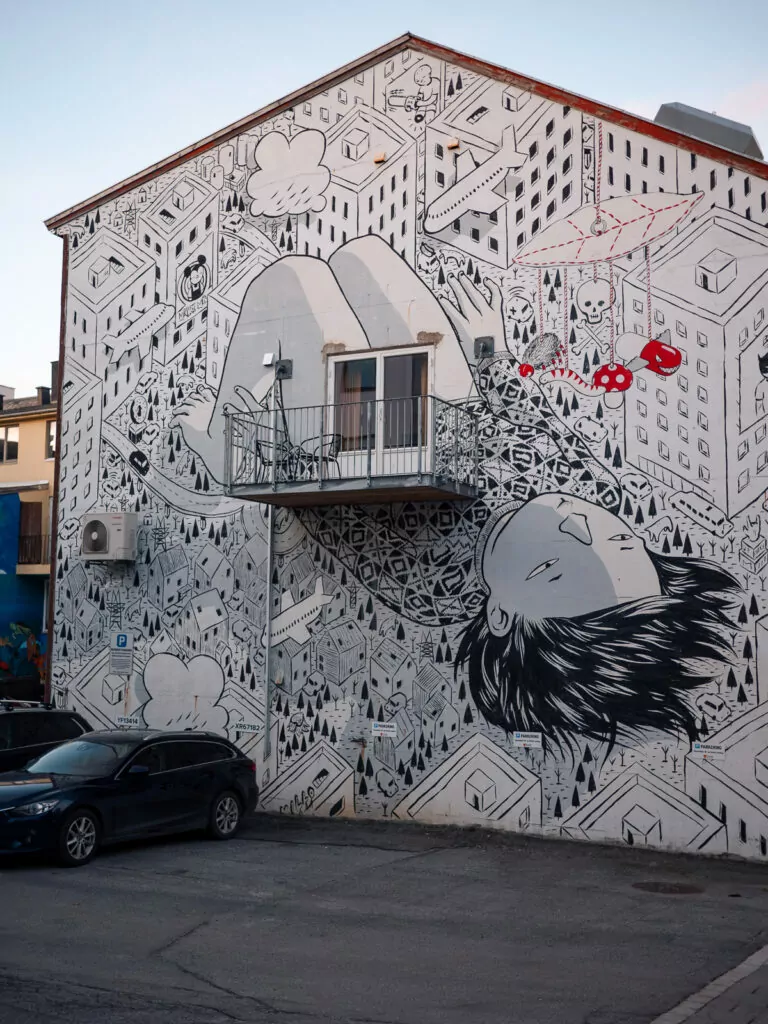
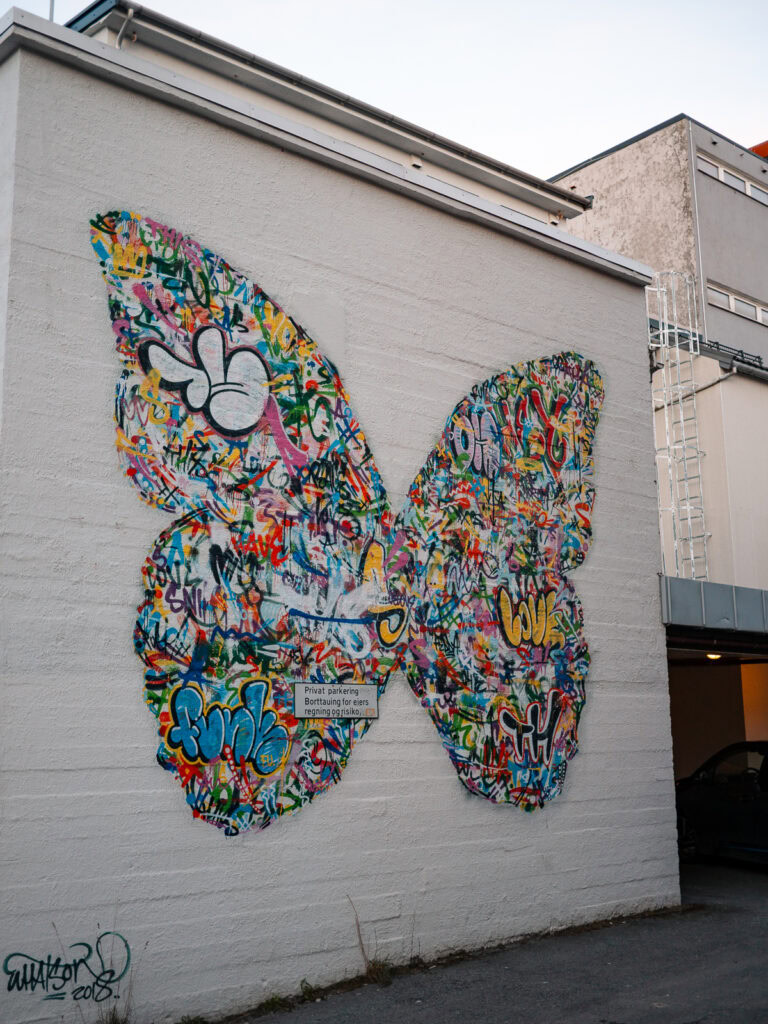
I snapped up a bargain though, I got some warm and weatherproof ski overalls for just 40EUR. And it was good timing too, because on this night I spent HOURS outside for good reason…
THE NORTHERN LIGHTS SHOWED UP!

It was 4.45pm and I was working in my cabin when the Northern Lights alert came through the phone speaker (you can turn this on or off as you wish), so I jumped into my Arctic gear, grabbed my camera and ran to my parents’ room to set up on their balcony which had the perfect vantage point.
We had a mini lesson around how to shoot long exposure photos on iPhone (the joys of travelling with Boomers 🙃) and they were stoked with their handheld phone shots. Here are some iPhone shots from my 15 Pro Max, it’s crazy how far phone cameras have come.
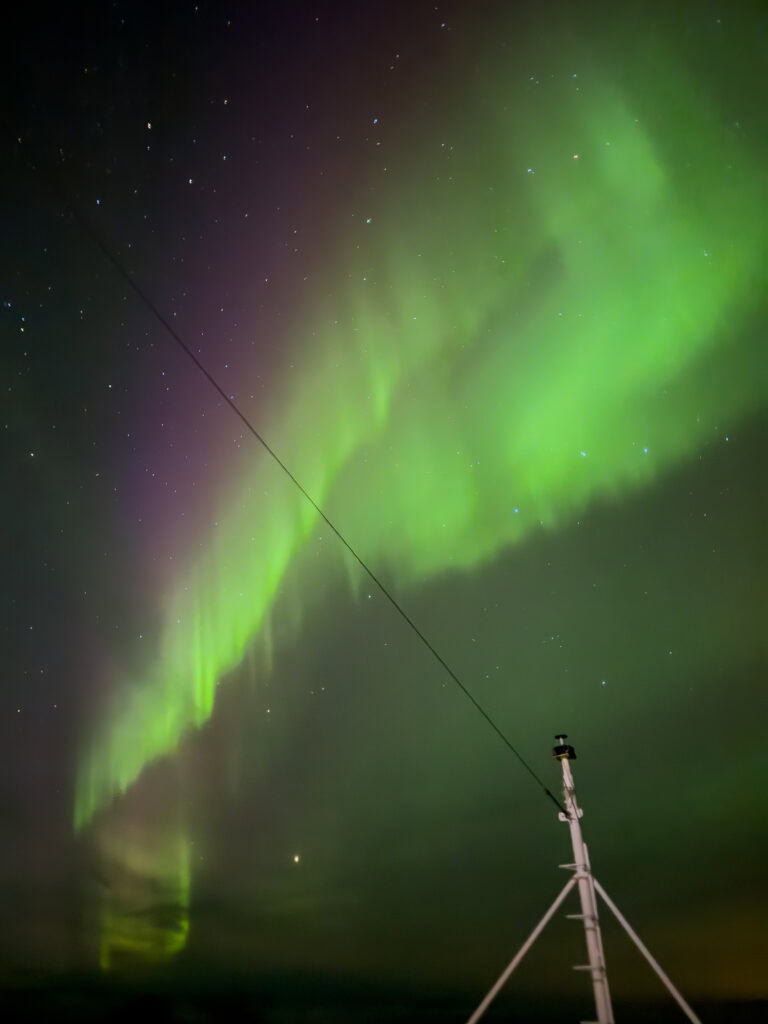
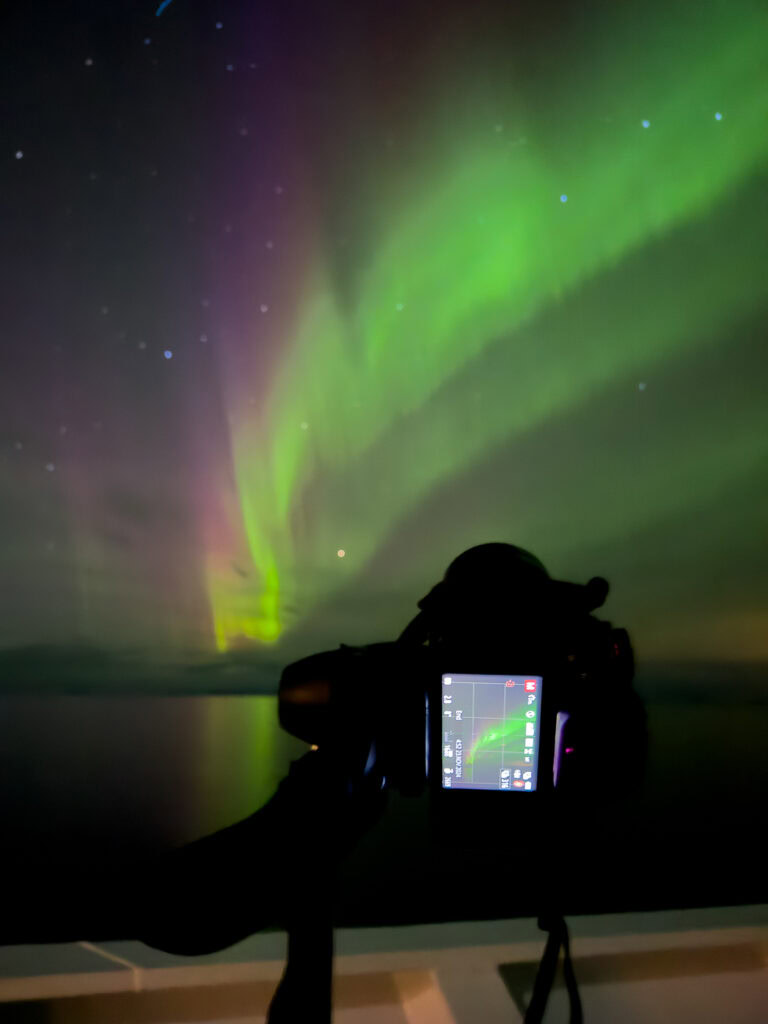
After one too many freakouts on my part that they were going to drop their phones into the ocean, I took my camera and tripod to top deck to get a more panoramic viewpoint. And it was worth it!
There’s some healthy scepticism around the aurora online and whether it’s an Instagram vs. reality situation.
It is true that photos are very different to what you see with the naked eye, due to long shutter speeds letting in more light and capturing movement, plus many photographers amping up saturation and brightness in post, but if you get a strong display in an area with minimal light pollution then you can absolutely see them in all their bright green glory, dancing across the sky.
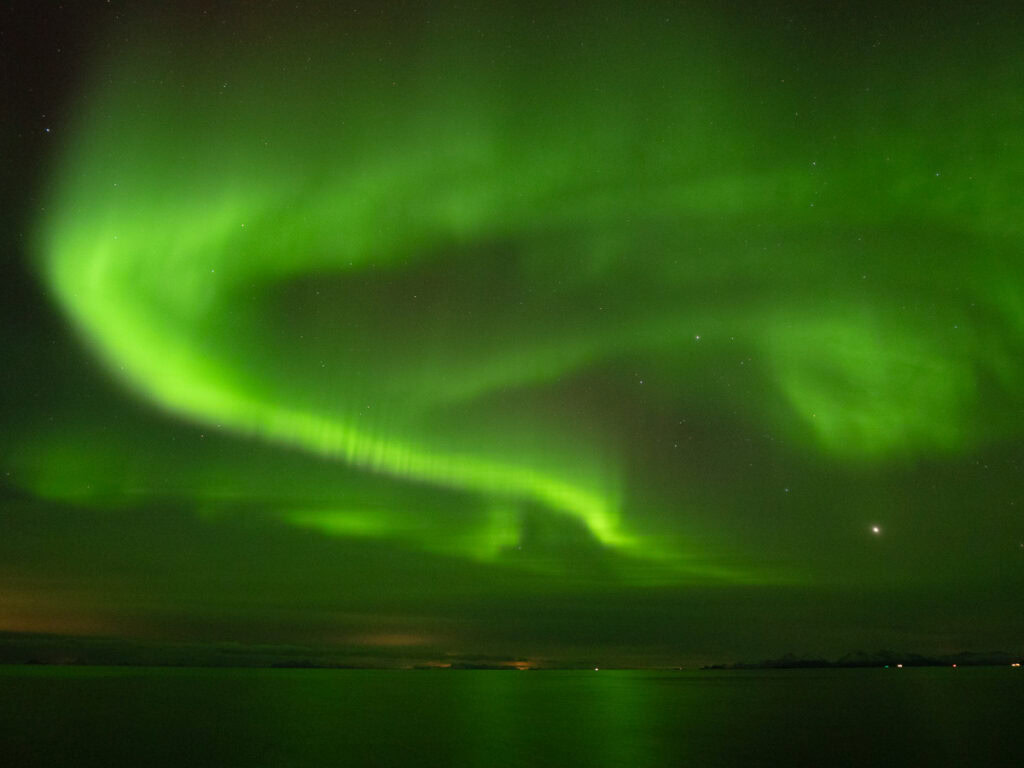
I have minimally edited my Northern Lights photos to try and portray them as realistically as possible, and you can see some videos in my Norway highlights which are more representative of what you’d see in person (though in person they’re brighter as your eyes have adjusted to the darkness).
The aurora died down around 6.30pm, just in time for our dinner sitting. The menu had changed to the second regional features for days 4-6 so we had some new options to choose from, I went for the fried Arctic char, tempura broccoli and beetroot tartare.
We had an evening stop in Svolvær from 9.20-10.15pm so I headed out for a walk in the heavy snow.
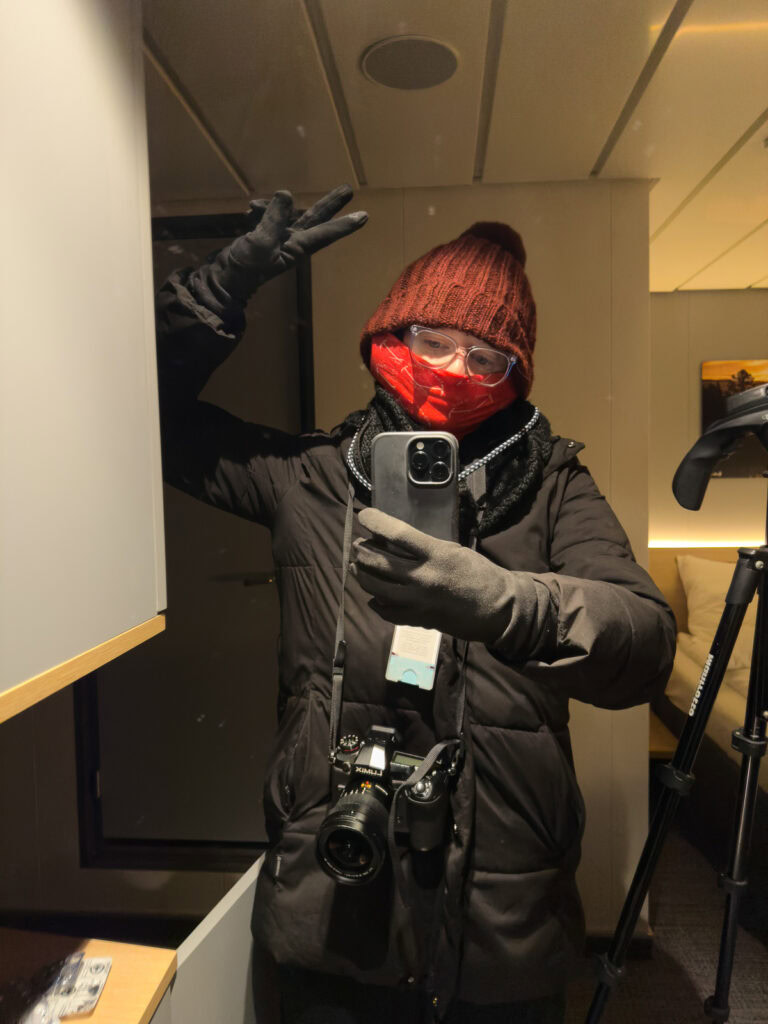
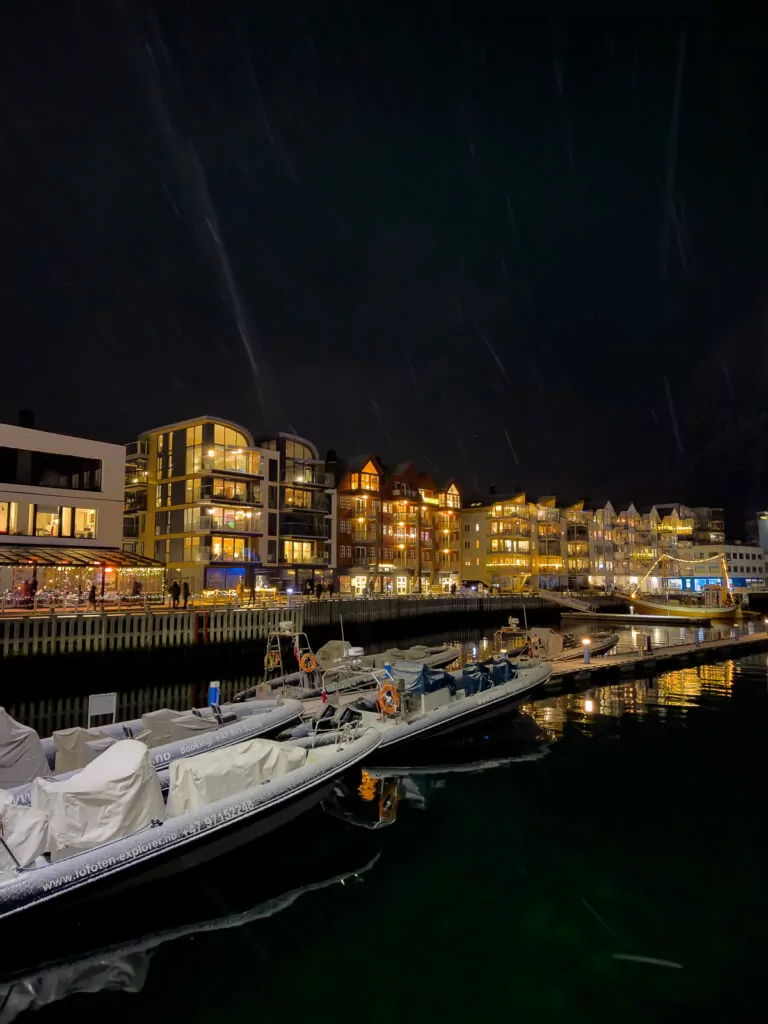
Svolvær is the main town in the Lofoten Islands, I’d been here before during my Lofoten road trip a couple of years ago. This part of Norway is one of my all-time favourite places in the world, if you have extra time on top of your Havila trip I’d really recommend jumping off in Svolvær on the way south and renting a car to spend four or five days exploring the magic of this archipelago.
If you don’t have time for a dedicated side quest but you’re sailing with Havila between April and August, then the Meet and Greet Lofoten excursion is a must-do. This bus tour takes you through a few different fishing villages and gives you a little teaser on offer in this remote group of islands.
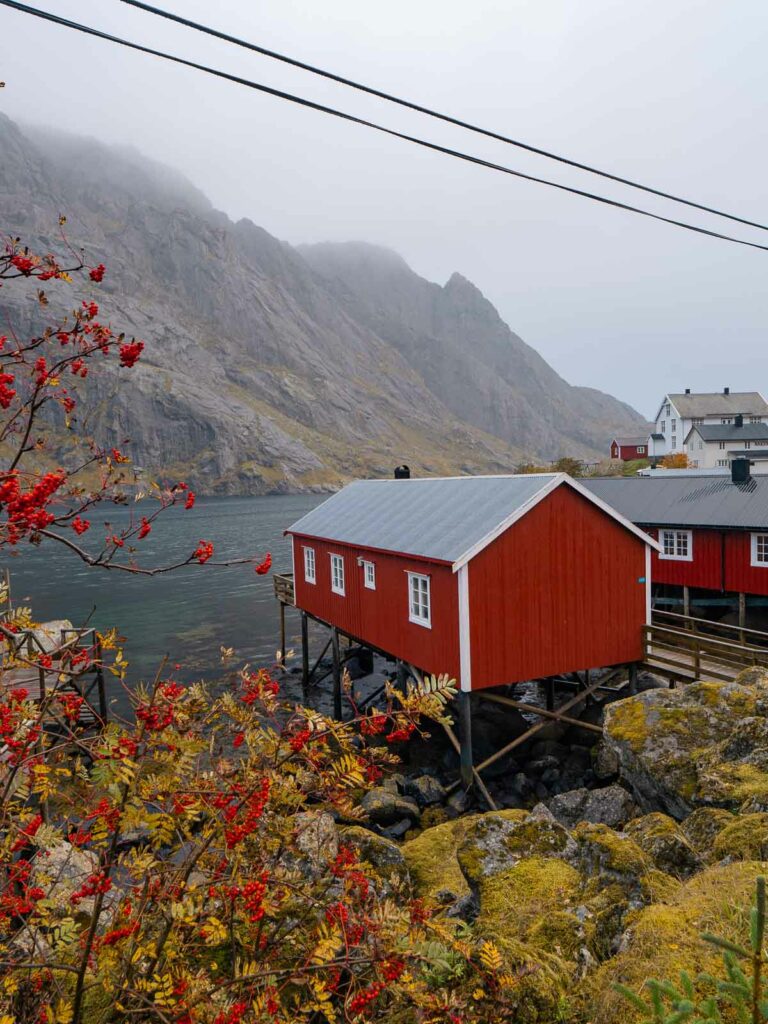
After a chilly walk in Svolvær I jumped back on the boat, but that wasn’t the end of the excitement for the evening. At about 11.50pm I saw a spotlight out my cabin window, coming from the boat and pointing towards land which seemed terrifyingly close to us.
I made my way up to the viewing deck and realised that we were sailing through some of the narrowest fjords we could even sail through, with little red fishermen’s huts and snow-covered forests within a matter of metres. It was heavily snowing outside but the water was perfectly still to let us sail through smoothly.
Day 5: Tromsø, Sami excursion & more aurora
It was a cloudy morning, according to my parents, I wouldn’t know because I slept until midday! The long hours of darkness were clearly impacting my circadian rhythm.
We arrived in Tromsø in 2.15pm and had four hours, with a few excursions on offer or enough time to go on your own adventure around the city.
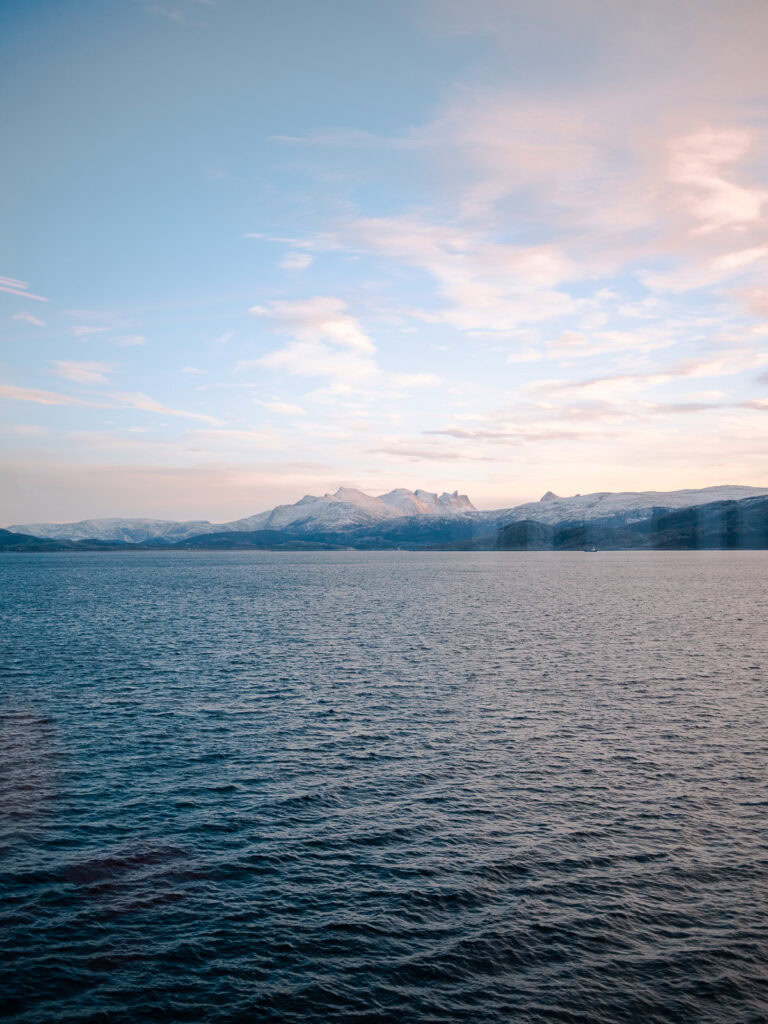
My parents opted for the latter, they walked to Tromsø’s iconic Arctic Cathedral and then found a craft brewery for a few drinks. They were even served by a fellow Kiwi, a whopping 16,000km from home.
I chose to join the reindeer sledding and Sami excursion, only available from November to April. We caught the bus through thick snow to reach the cultural village, where we first sat around an indoor campfire for an intro to the indigenous Sami people and how they use reindeer before getting to feed them ourselves.
It was certainly not the most photogenic setting for the reindeer, with the bright lights really bringing out the yellow and brown snow-covered ground, but this was clearly a bucket list experience for many guests.

We warmed up in a little wooden hut with a hot drink and some reindeer stew, which took some mental preparation for me to try, but it was deliciously tender. Sorry Rudolph.
Next was Sami Culture 101, where a young Sami woman explained the tumultuous history between the Sami people and the Norwegian government around the ‘Norwegianisation’ assimilation policy of the 19th and 20th centuries.
The aim of ‘Norwegianisation’ was to integrate the indigenous Sami people into Norwegian society, but this came at the detriment of their cultural identity, languages and traditions. Policies were strict and wide-reaching, and involved prohibiting the use of Sami languages, discouraging Sami cultural practices, and establishing boarding schools for Sami children to isolate them from their communities and speed up the assimilation process for that generation.
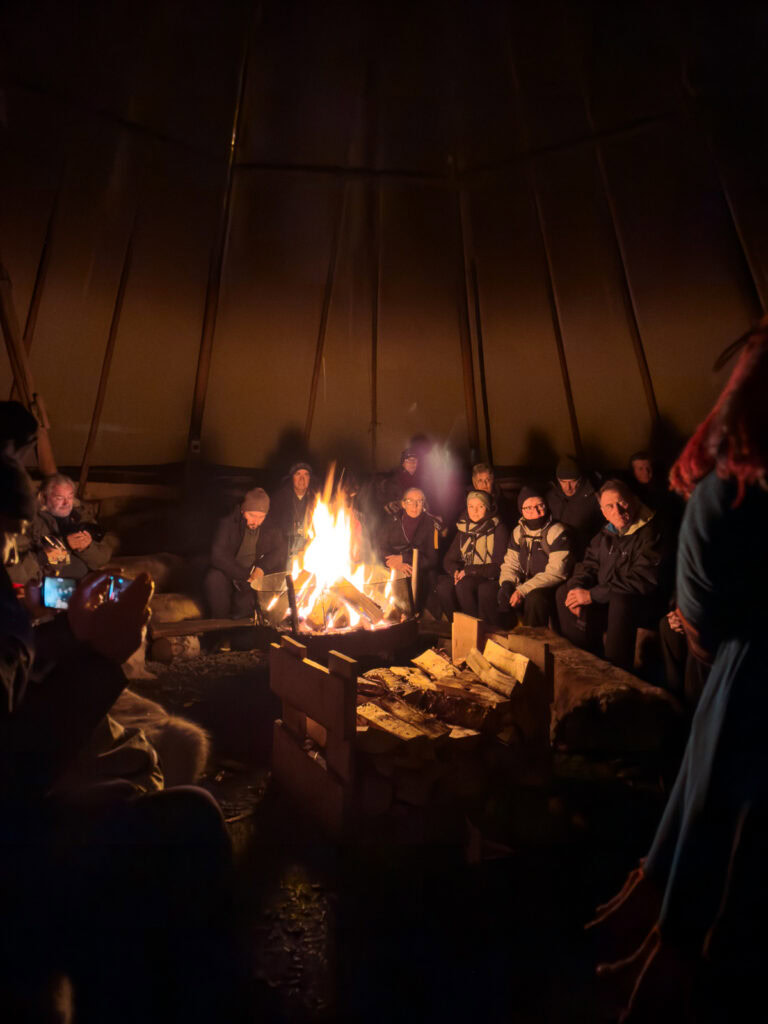
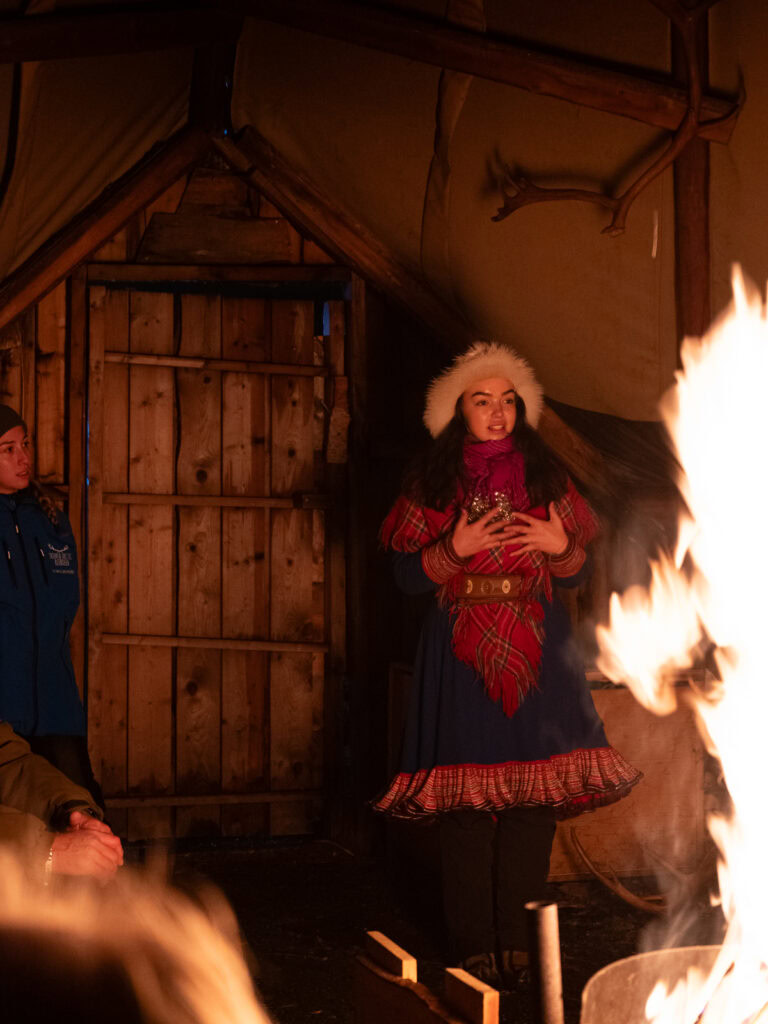
Some of these policies continued until the 1980s, with immense impact on language retention, cultural identity, indigenous knowledge around health and agriculture, and intergenerational trauma. So heart-breaking and sadly a common story when it comes to indigenous populations.
In more recent years there has been a governmental commitment to reconciliation, beginning with the Sami Act of 1987 which recognised them as indigenous people and gave them a voice in parliament, and most recently in November 2024 a formal apology was issued for the injustices and discrimination the Norwegianisation policy inflicted over all those years.
It’s an ongoing battle but it was truly inspiring to hear our Sami guide talk about her generation’s passion to reconnect with their heritage, after the generations before them were shamed or even punished for practising their culture and speaking their language. For me as a (white-passing) Māori, with grandparents/great-grandparents who had te reo (Māori language) beaten out of them at school, it hit very close to home.
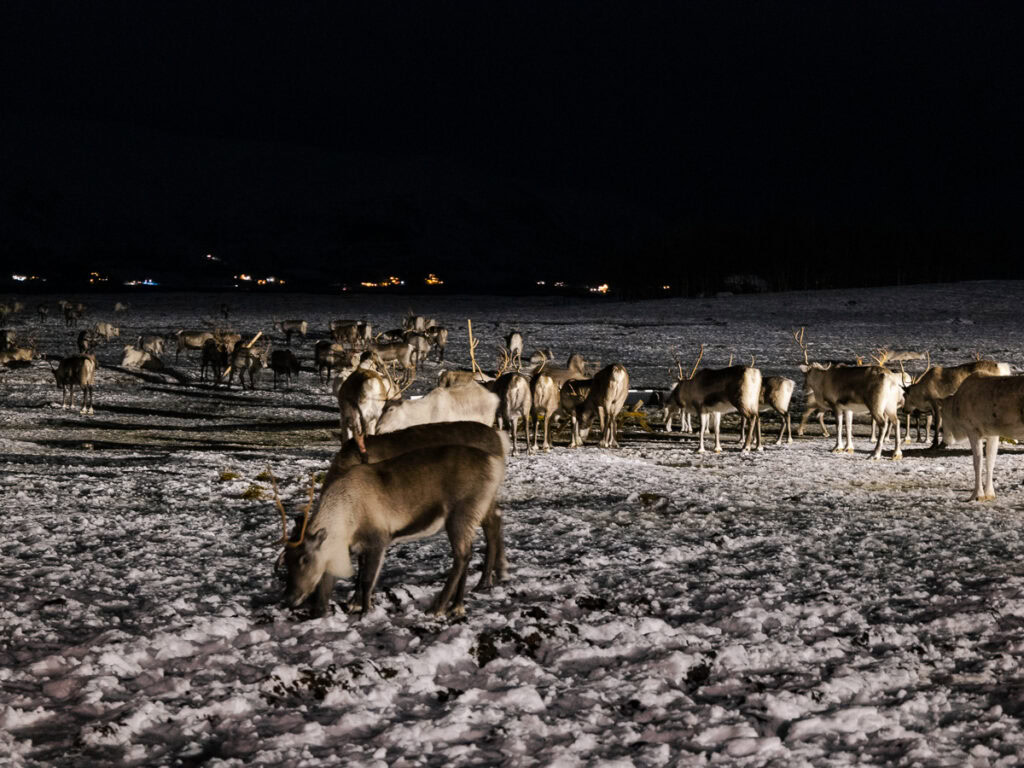
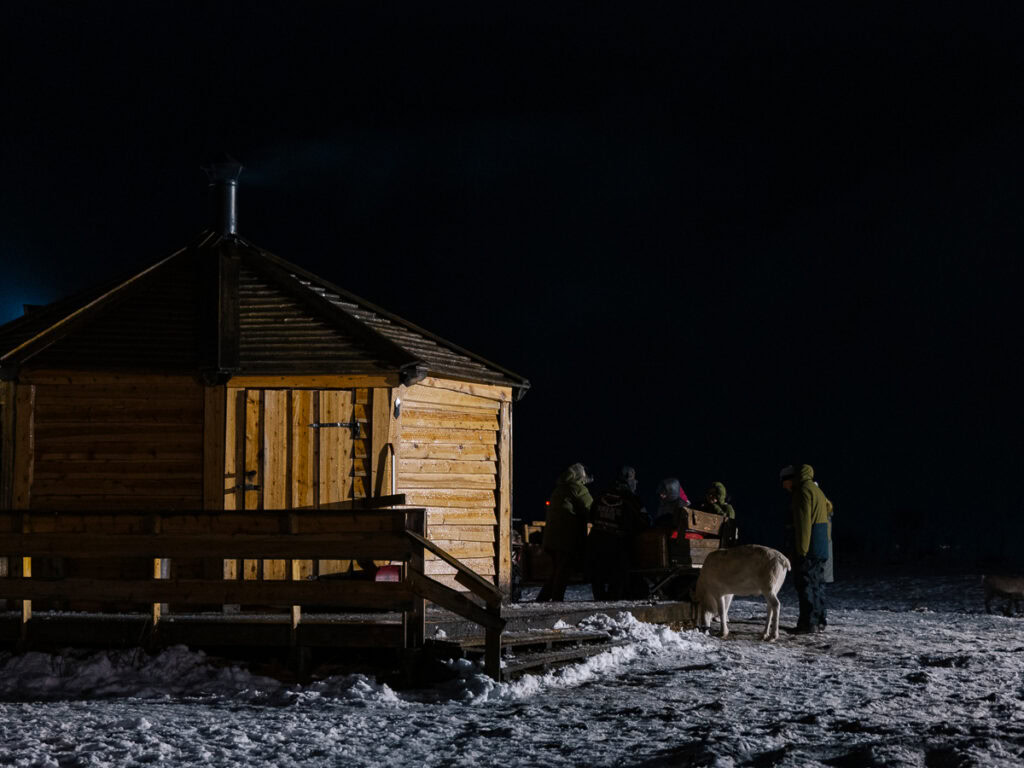
The excursion was brilliant and definitely worthwhile, but unfortunately we missed out on reindeer sledding due to the Sami talk being conducted in English and then translated to German, which meant it took twice as long as it should have. I’m not sure why they did this and didn’t split into two groups to ensure we stuck to the schedule.
I got back to the boat in time for dinner, with a great view of Tromsø’s cathedral as we departed to head further north.
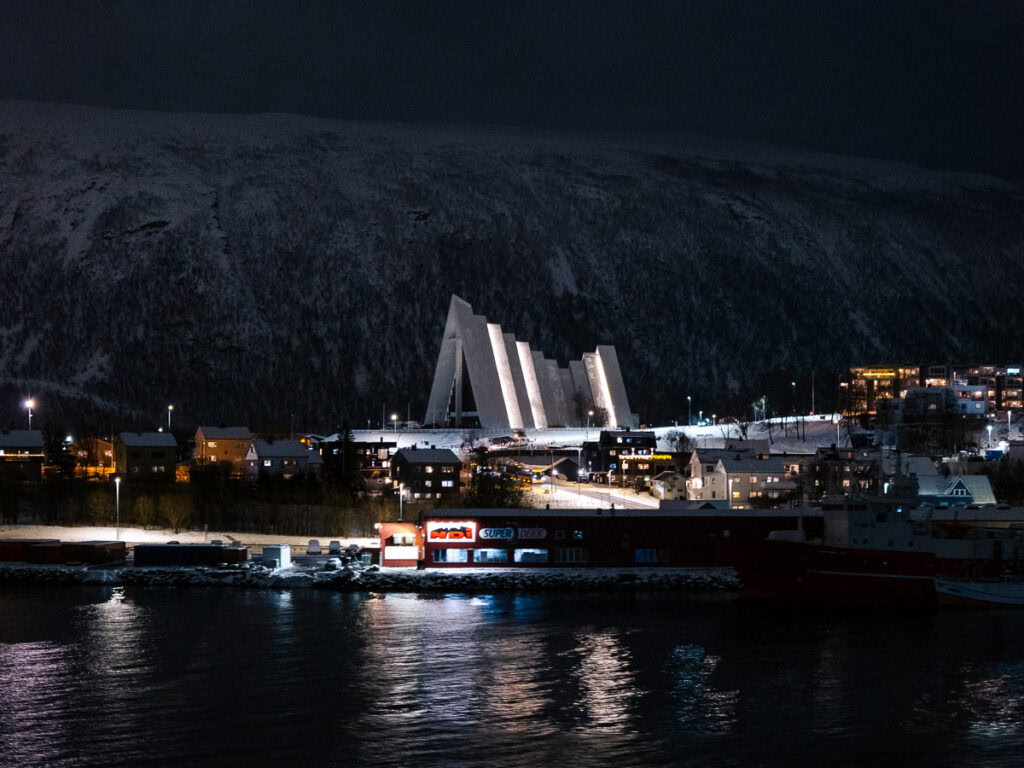
My parents decided to have a fancy evening, booking a table at the Hildring fine dining restaurant for the King crab night (1995NOK which was 170EUR at the time, but I think the price changes slightly depending on season/demand). They got a huuuuge plate of crab with various sauces and plenty of bread, and as seafood-lovers they were impressed!
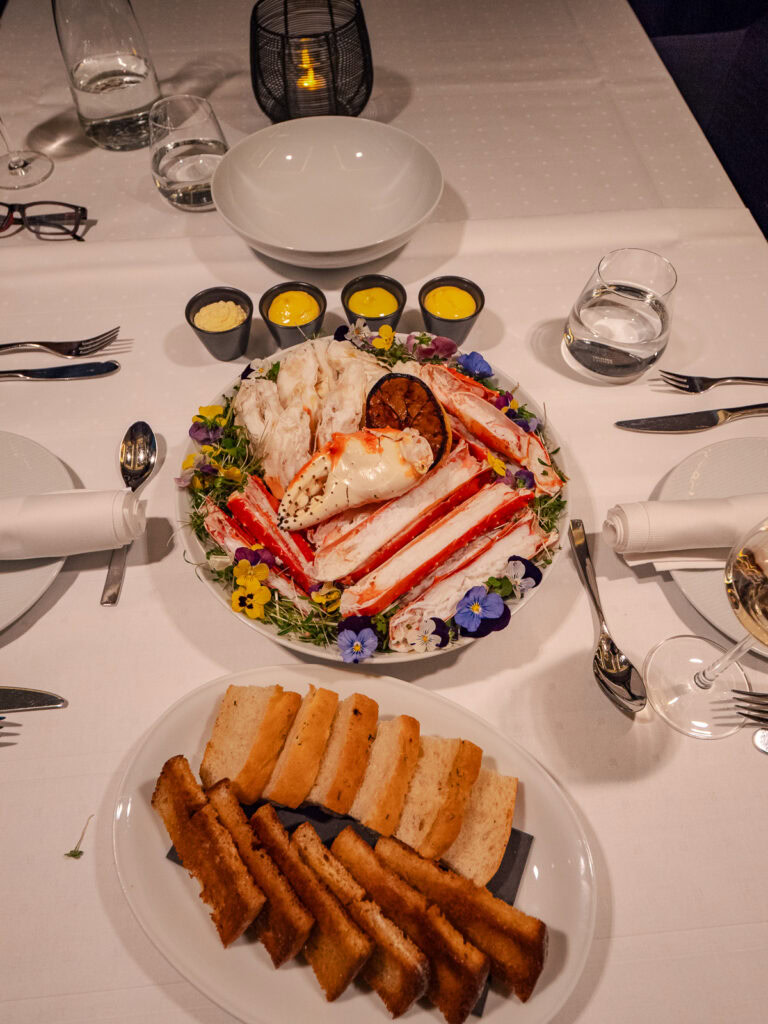
At 8.45pm there was another Northern Lights alert, and the aurora was absolutely exploding above us as the thick cloud dissipated. Mum and Dad were already in a still-jetlagged deep sleep / King crab food coma and I had a mental battle with myself about whether I should wake them up, and I decided that it was worth the risk.
Once the initial ‘what time is it and where are we?’ post-slumber shock wore off, I think they were pretty grateful that I let them know what was happening in the skies. Look at this!
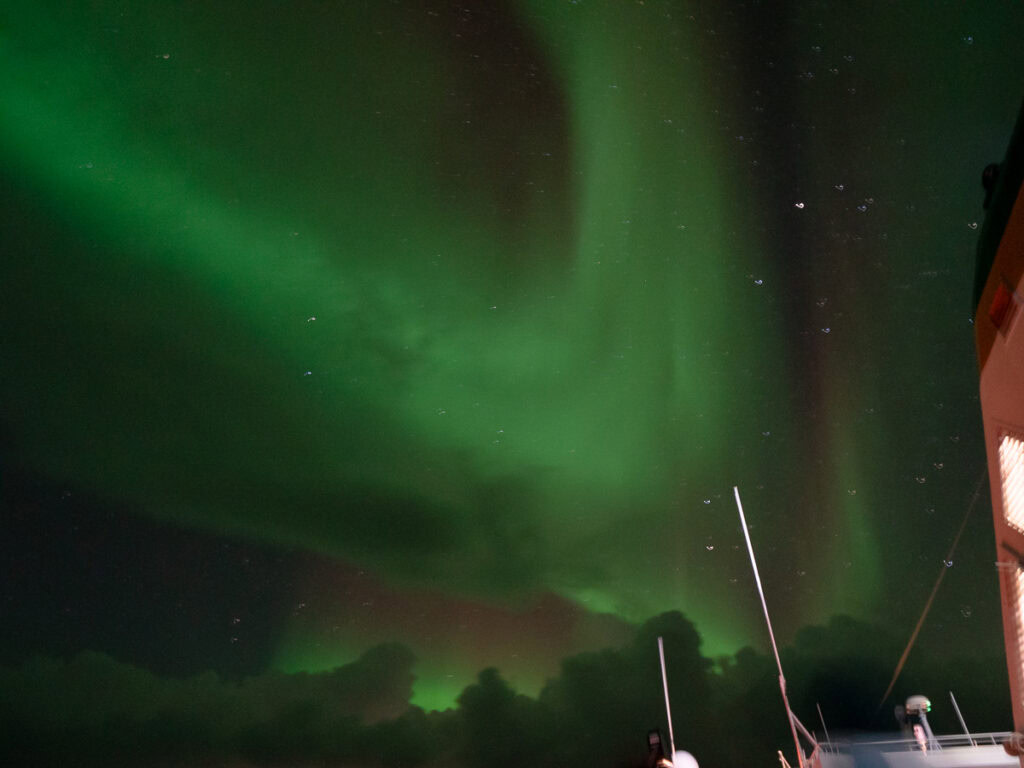
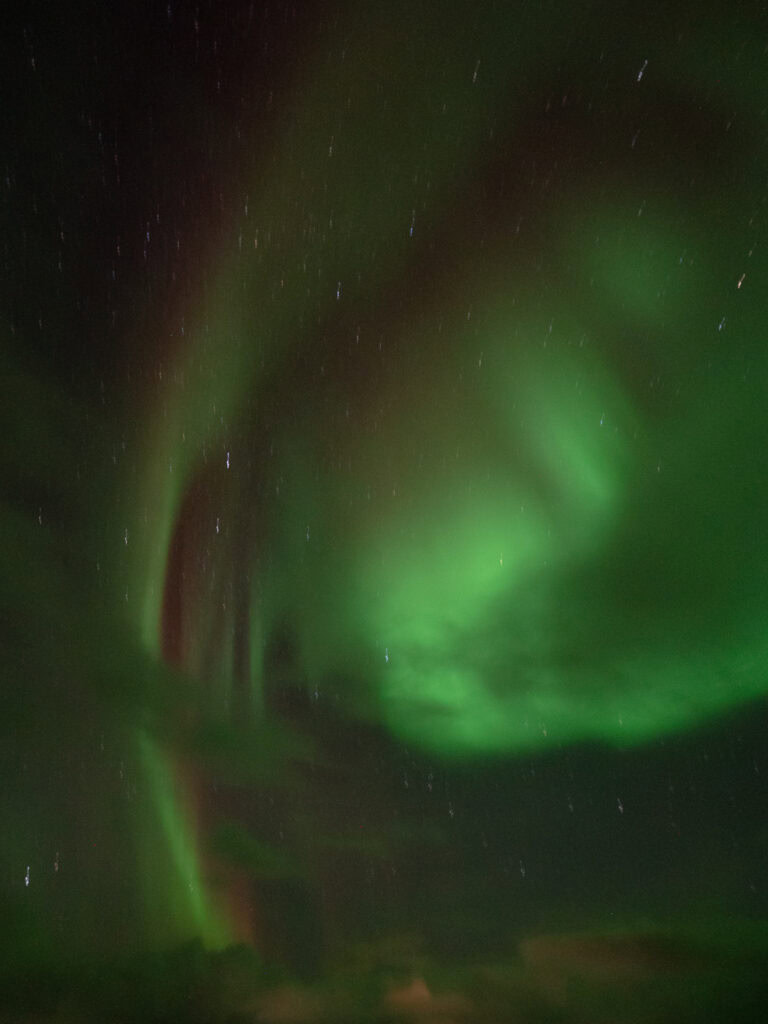
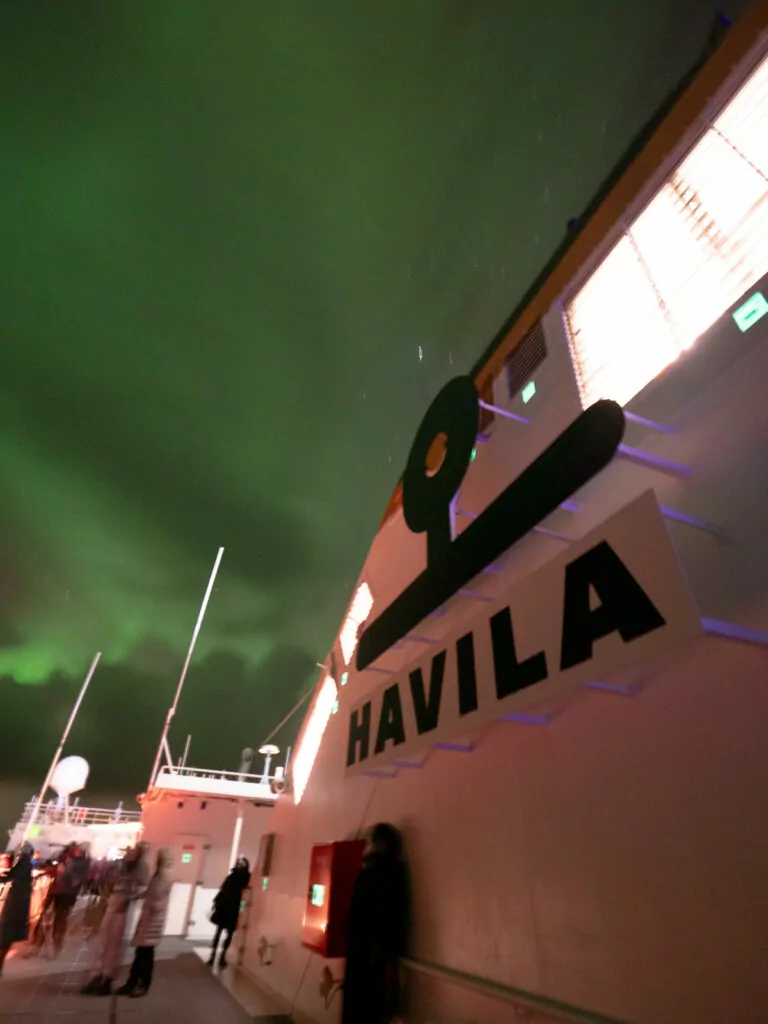
This really is the huge benefit of having a room with a balcony, being able to enjoy the Lights from just steps away from your bed is so much easier than needing to put on full winter gear and heading up to the deck with hundreds of other passengers. And don’t even get me started on people who have their flash turned on or use their phone torch to check their camera settings, completely ruining everyone else’s long exposure shots 🙃
The swells on this night were no joke, as the boat left the protected coastline and ventured into to the open sea to get from Skjervøy to Øksfjord. I don’t get seasick thankfully but if I did, this would definitely have required some medication and deep breathing.
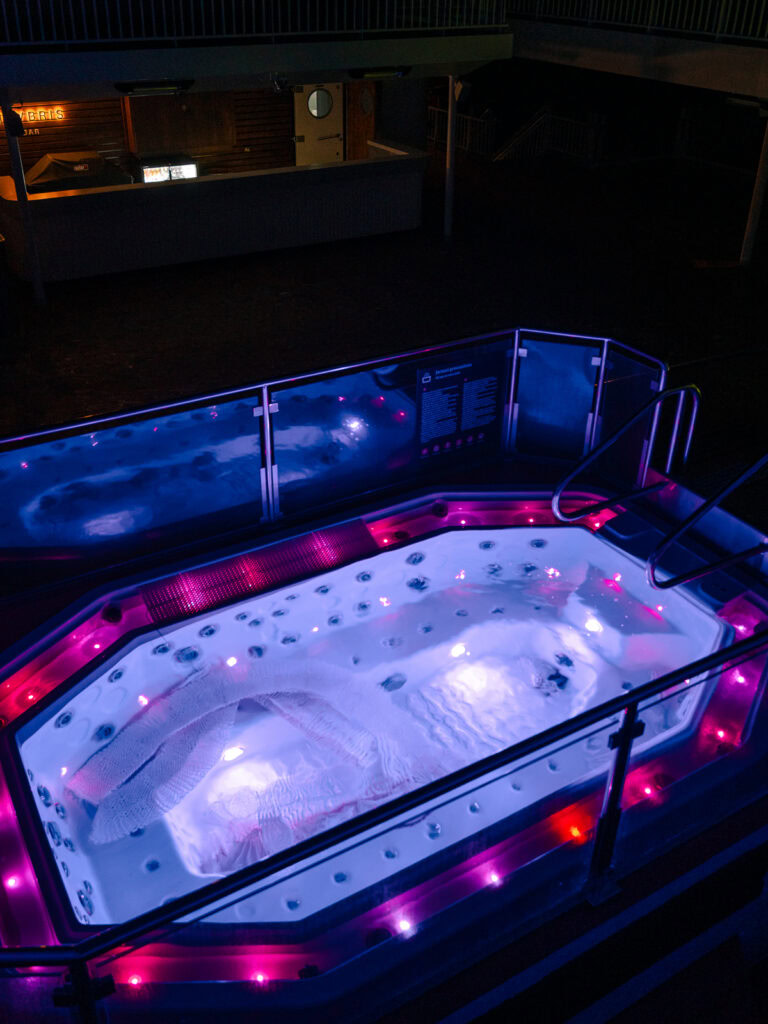
Day 6: Honningsvåg quad biking & aurora round three
On day 6 we sailed past Nordkapp (the North Cape) on Magerøya Island, which isn’t just the northernmost point of Norway, but of all of mainland Europe.
The main stop of the day was Honningsvåg, from 10.55am to 2.30pm, and I decided to book the Magerøya Island winter ATV safari to explore the harsh Arctic landscapes on four wheels. IT WAS SO FUN. This one has limited space and books out in advance so lock in your spot early if you’re keen to do it.
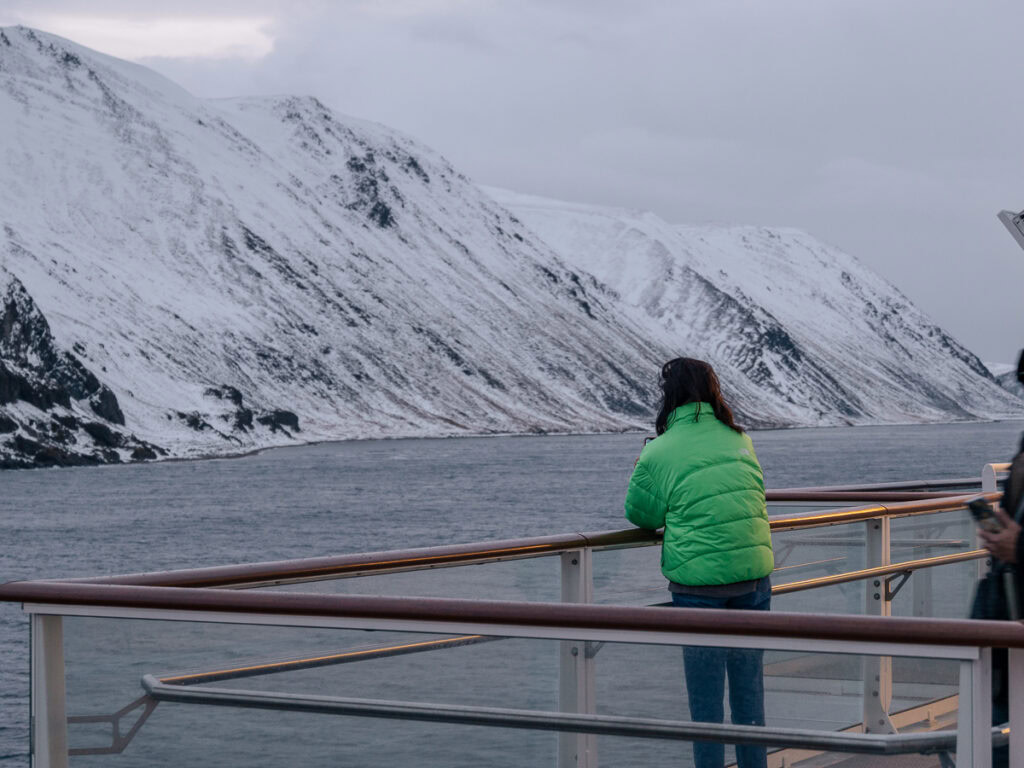
I got all geared up in a full snowsuit we hit the road, driving along the coast amongst normal cars before we reached the mountain we were going to climb.
The views all along the trip were so spectacular, it felt like we were traversing another planet, but the excursion details promised “there are many photo stops on the way” and unfortunately we only got one photo stop at the very top due to weather.

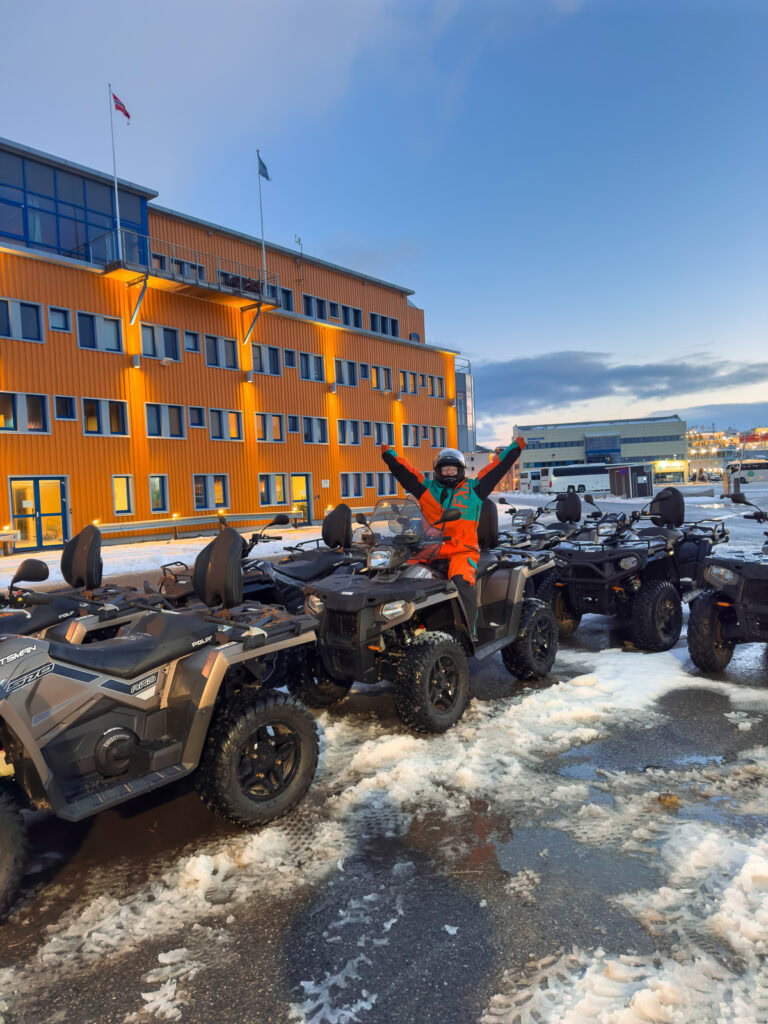
The road was covered in snow and ice, the guide said it should have been ploughed but for some reason it hadn’t been done that day, and this meant it took longer to manoeuvre our way around corners where the snow had built up. I was driving solo so I couldn’t take any photos along the ride which hurt my soul, because the landscapes were mindblowing.
But this is the risk of visiting in the harsh winter months, you’re really at the mercy of the conditions on the ground!
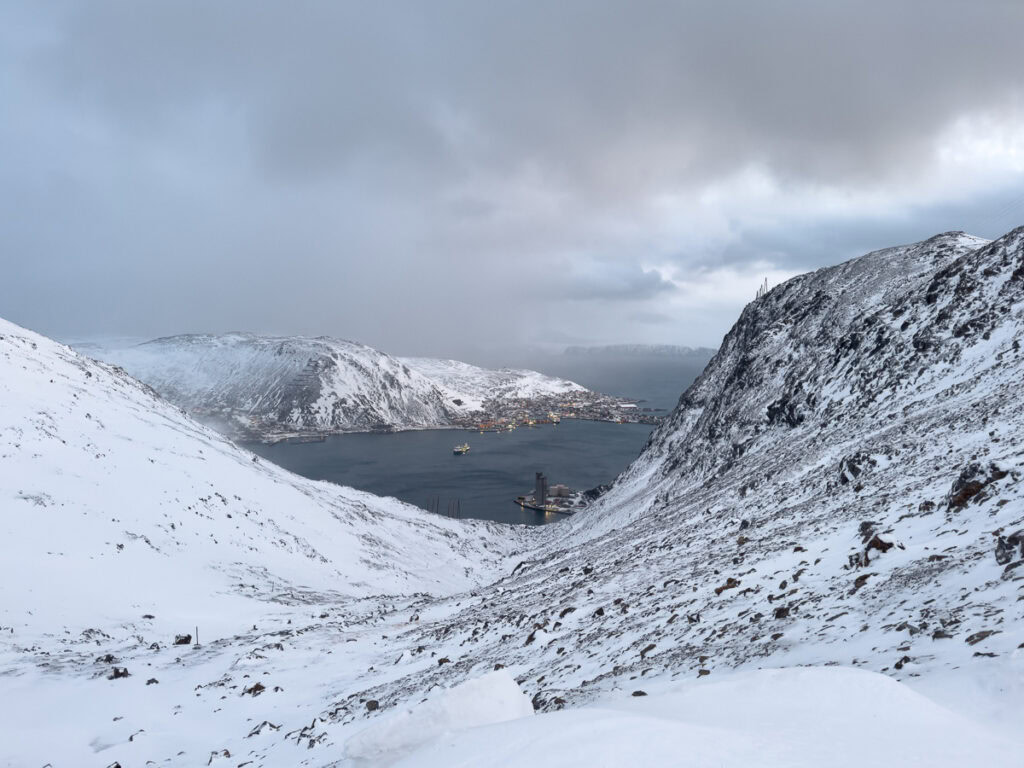
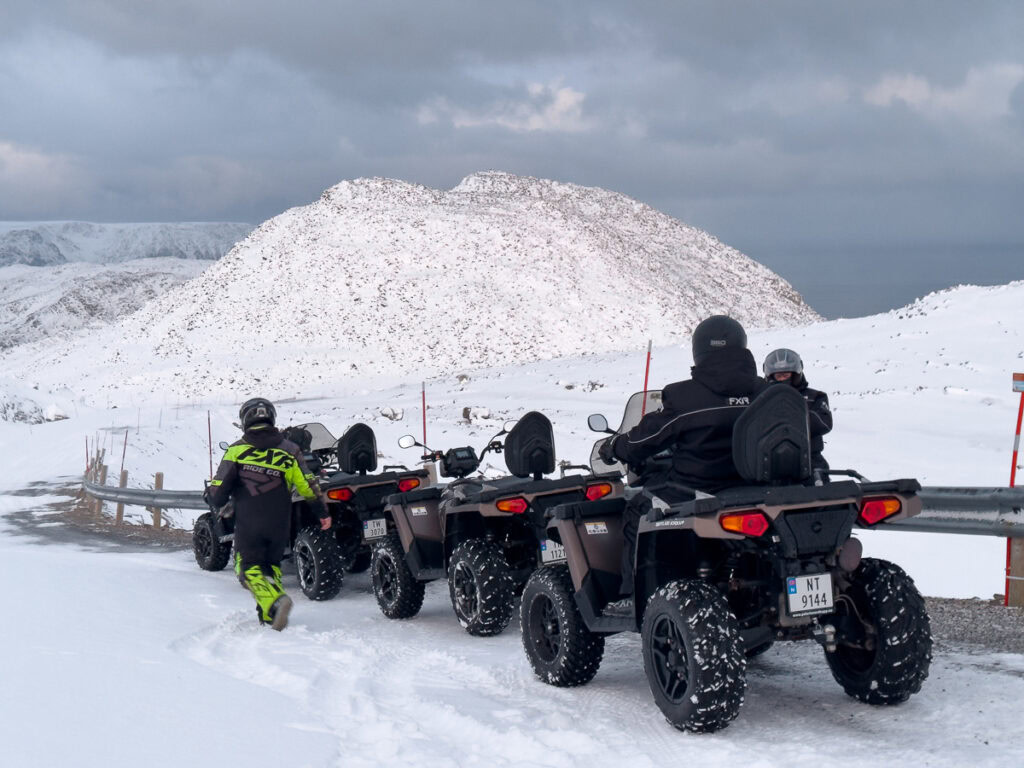
I caught up with Mum and Dad back on the boat and they said they’d wandered around Honningsvåg but it was very small and most cafes/bars were closed (it was a Sunday), so I’d say choosing an excursion on this day would be your best option.
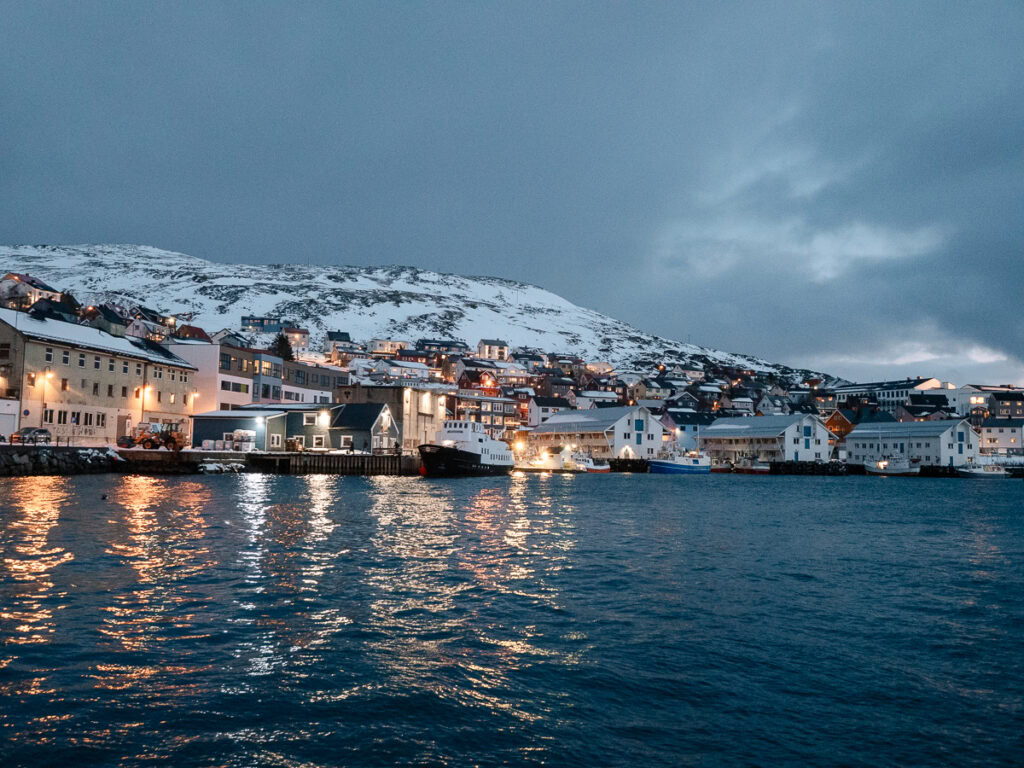
The Polar Land portion of the menu wasn’t my favourite, so I changed it up and ordered a simple but yummy Caesar salad from Havly Café instead.
It was another rocky few hours on the water as we sailed along a completely exposed section of the coast, but luckily the swells lessened a little in the late evening.
An aurora alert came through at about 9.45pm, the skies were perfectly clear but we were at the port in Berlevåg so light pollution diluted the impact and photography opportunities. It was far, far too cold to wait outside while we undocked so I headed back inside, and there was another alert an hour and a half later.
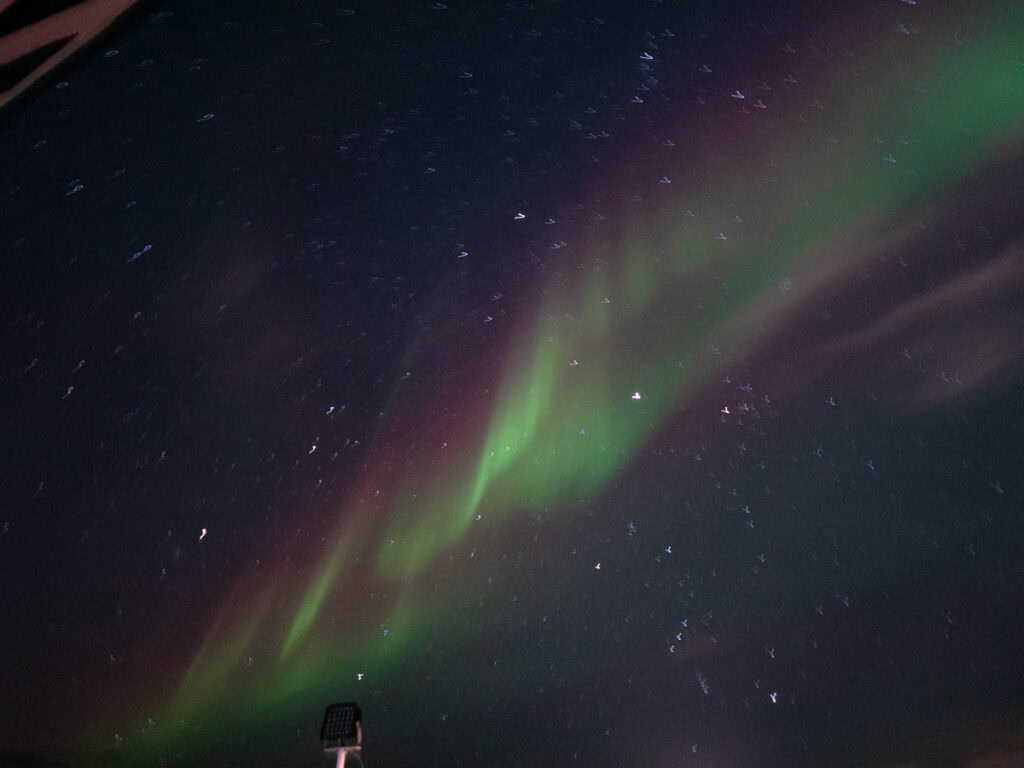
A lot of people were obviously either asleep with the alerts off or not willing to brave the sub-zero temps, but they missed out, because this was one of the best Northern Lights displays I’ve ever seen (and I’ve been very fortunate to have seen them 10+ times now!).
From 11.30pm until 1.30am I risked frostbite to capture hundreds of photos and videos of a jaw-dropping aurora session, complete with what they call an ‘auroral corona’ or crown of the aurora, where the solar activity is so strong that the Lights appear to be converging right above you.

They danced for hours, a hue of bright green with purple tint shining through too, and best of all there were only a few of us up there shooting so it was easy to find vantage points with no one else in the way.

Day 7: Kirkenes huskies & ice hotel & aurora #4
After a late night of photography I woke up early to have breakfast with my parents, they were finishing their Havila adventure with a night at a hotel here in Kirkenes, the end of the Norwegian Coastal Route, before flying back to Oslo and onwards to London. But not before Dad joined King crab RIB excursion, a life highlight for him!
I was staying on the ship for most of the return journey down south, jumping off in Trondheim on day 11 of the 12 day Round Voyage, where I could catch a train to Oslo to complete the challenge I’d set myself to spend three months travelling Europe without flying.

In Kirkenes I booked the dog sledding excursion which took place at the Snowhotel, and we were welcomed with puppy cuddles which is the only type of welcome I want for the rest of my life.
We met our musher and the crew of powerful huskies who were going to take us on the sledding track, and off we went! These beautiful dogs were have been bred for generations for exactly this, and it’s very clear that they love it.
If you’re concerned about the ethics of husky sledding (as I was initially) then this guide on Responsible Travel’s website is a fantastic summary of what to look out for, and you can read more about Snowhotel’s dogyard here.
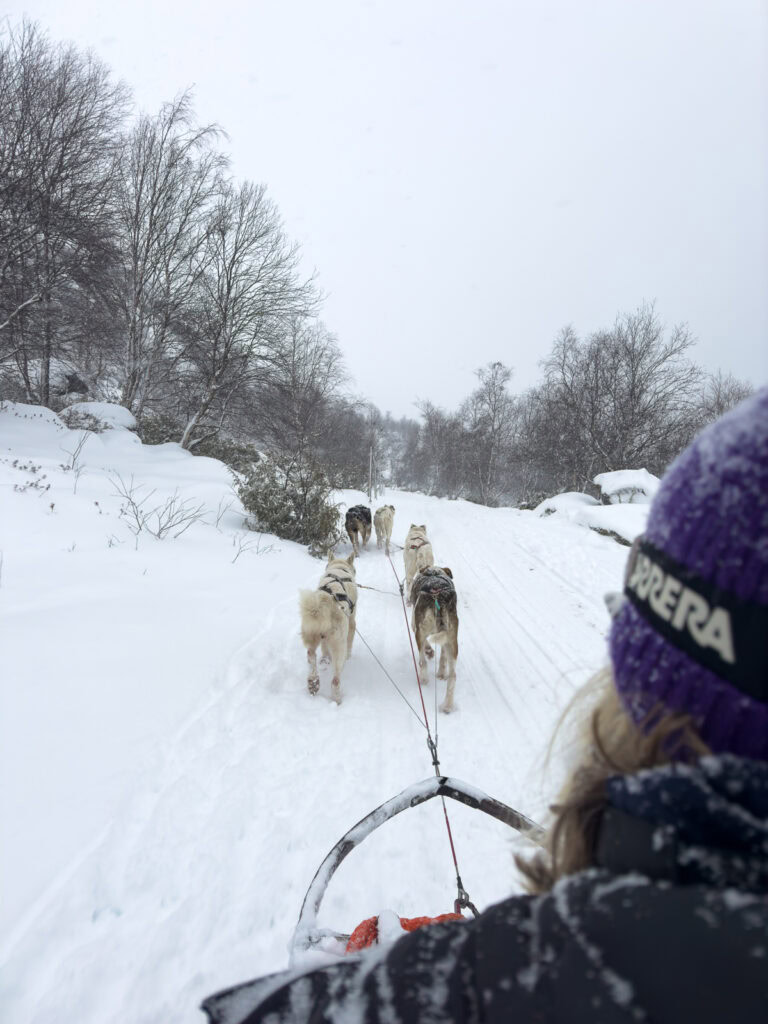
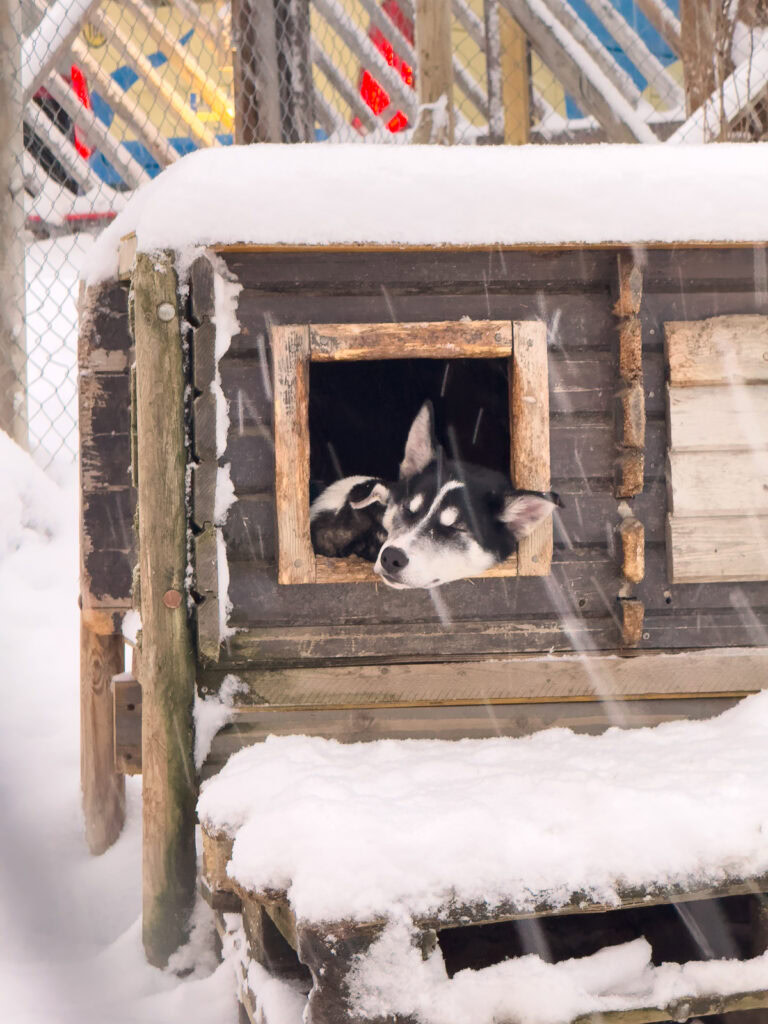
We had a post-sled hot drink in a cute café hut, said hello to the resident reindeer, took a tour through the onsite ice hotel (where you can actually sleep if you stay here!), said goodbye to the puppies and headed back to the boat to begin the southern voyage back down to Bergen.

The ship was leaving Kirkenes at 12.30pm, my parents had to check out of their suite at 9am but they could use the ship’s facilities until just before departure. Their bags were taken off the ship by Havila staff but were left in a row outside in the snow, so you’ll want a hard-shell suitcase with weatherproof zips (or carry your bags yourself).
Dinner was the third menu of the four regional showcases so I had some new options to choose from, before getting to see the Northern Lights for the fourth night in a row!
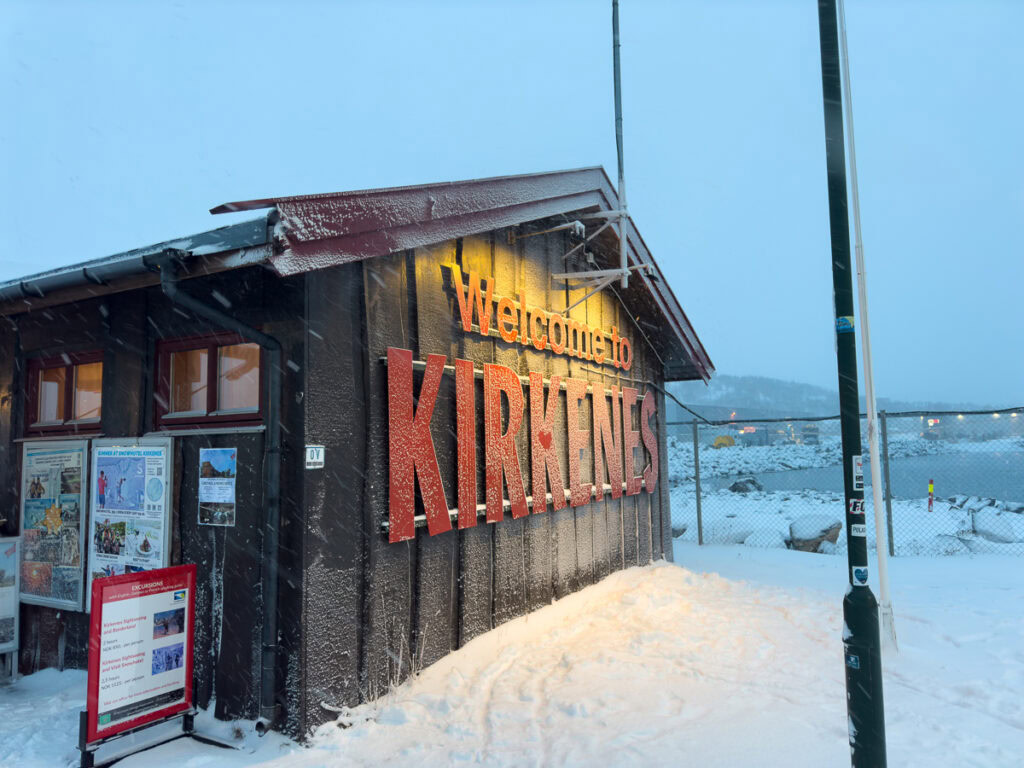
I was keeping a close eye on the skies from my cabin and spotted them myself, then ran to the front desk to let them know they could put out an alert, but they said it was too windy outside and that if they announced it they’d have people losing phones and slipping on the ice.
Sucks for everyone else because I got the show all to myself, although they were not being overdramatic about the wind 🌬️ it was so strong that my sturdy tripod kept getting knocked! I ended up lying down on the deck to shield myself from the gusts, soaking in the aurora while listening to bangers on full volume, making sure I moved every ten seconds or so so that whoever was watching the security cameras didn’t freak out that I was dead.
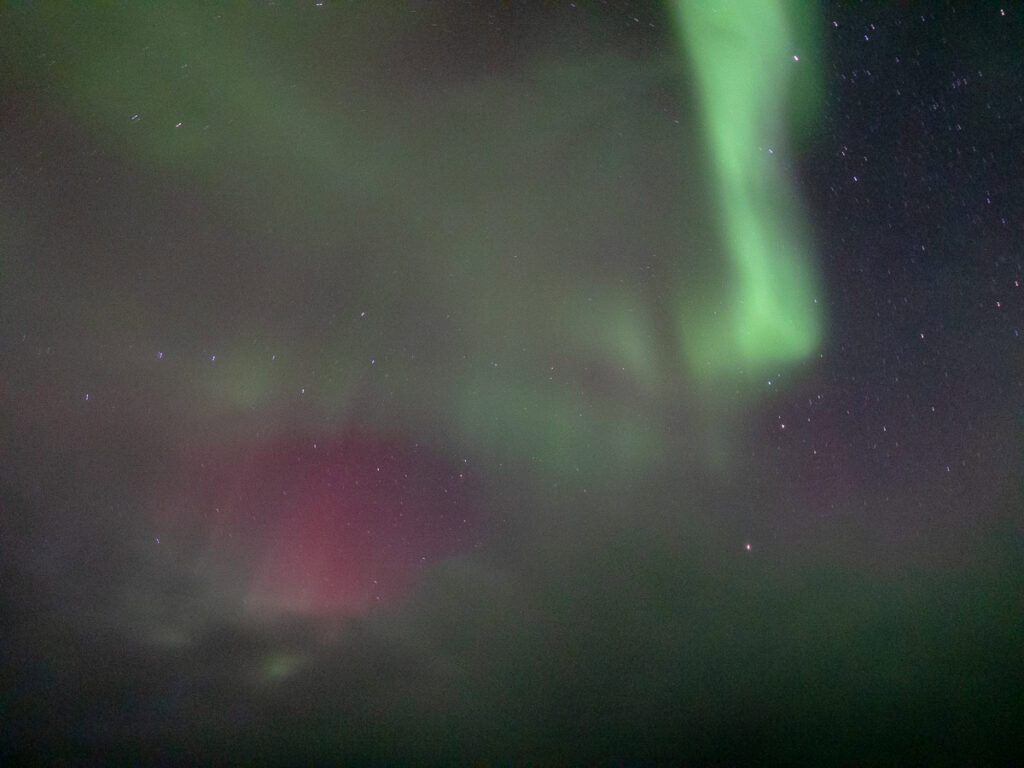
Day 8: Sailing
I was pretty tired after a full on week on the boat so I took day 8 as a rest day.
We made a stop in Hammerfest from 11am to 12.45pm but I was doing a load of laundry with all my thermals and my pyjamas were not appropriate outdoor attire for Arctic temperatures.
This evening there was a midnight concert at the epic Tromsø Cathedral which was an absolute hit according to the people I spoke to the next day, so consider booking a spot if that’s your kind of thing.

Day 9: Vesterålen excursion & (cloudy) aurora five
After a day of recharging my internal batteries (and camera batteries for that matter), day 9 was a half day excursion around Norway’s Vesterålen region, somewhere I’d never heard of but now I’m desperate to return to.
It was a bus tour with a lottt of guests which isn’t my typical choice of travel experiences, but it was worth it!
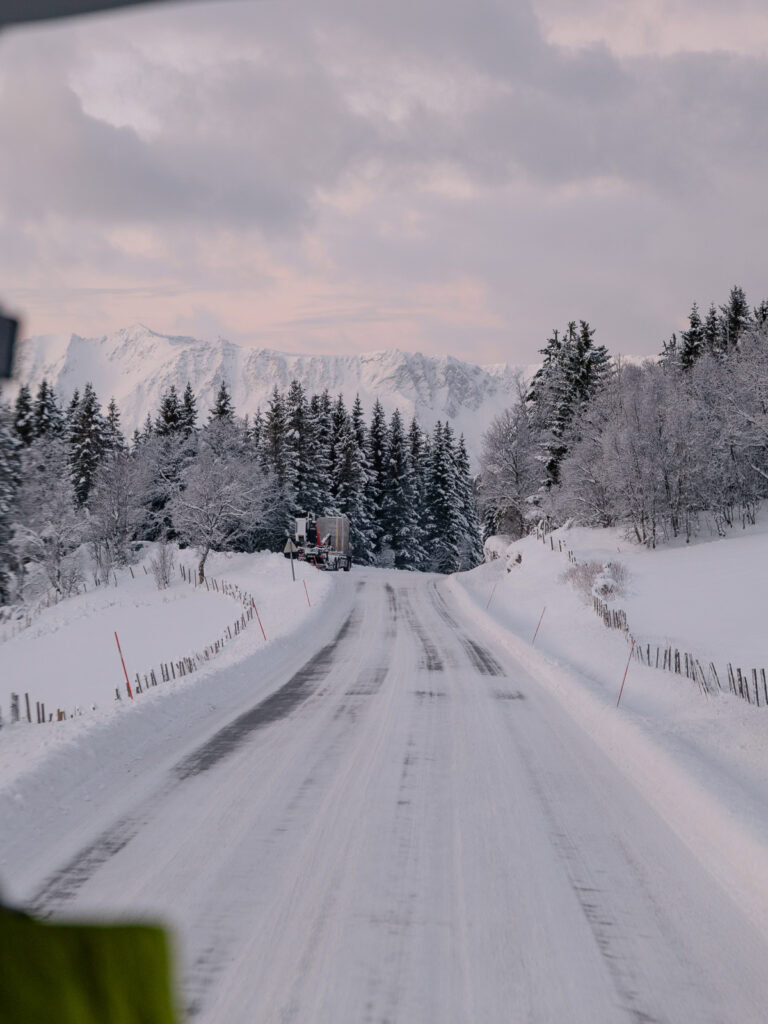

We began at a 15th century church, visited Trondenes Historical Centre and its medieval farm, enjoyed insane views from the bus with a few photo stops, took a scenic ferry ride under pink skies, and then crossed the 1km Sortland Bridge while we waved to our ship passing underneath.
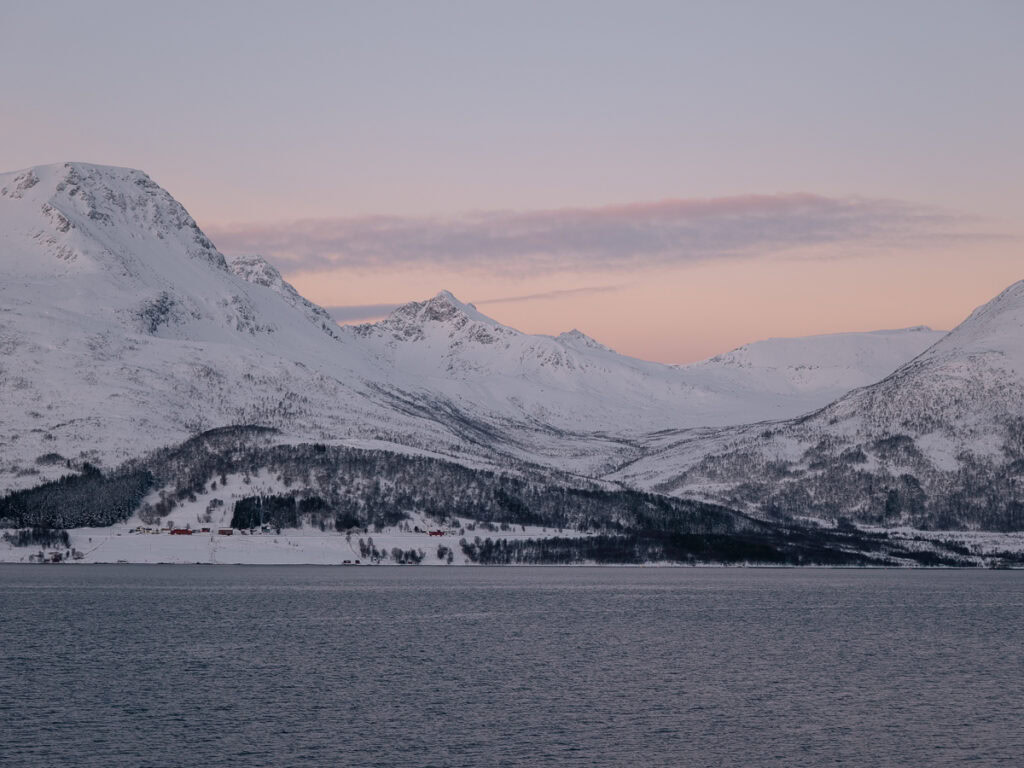
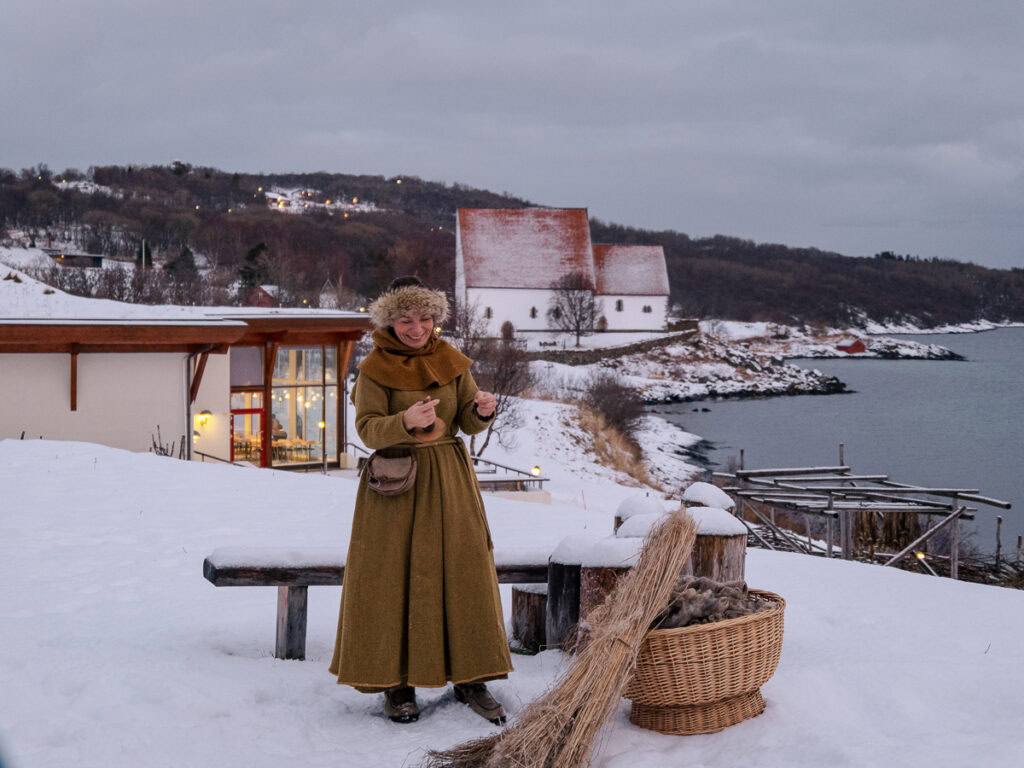
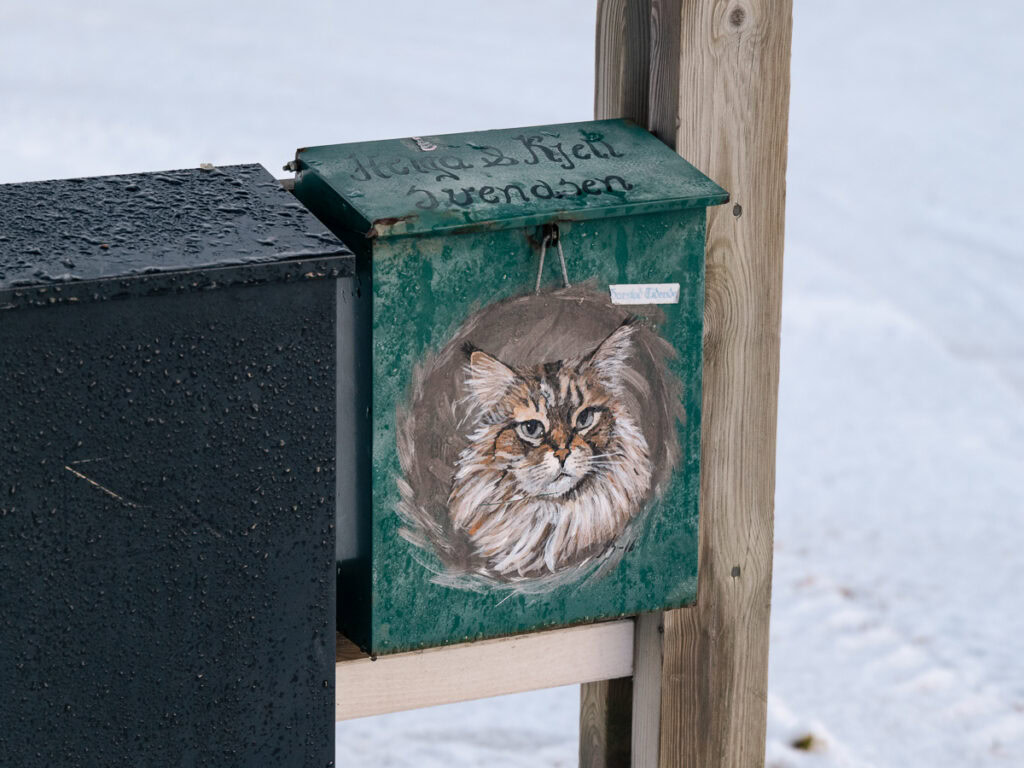
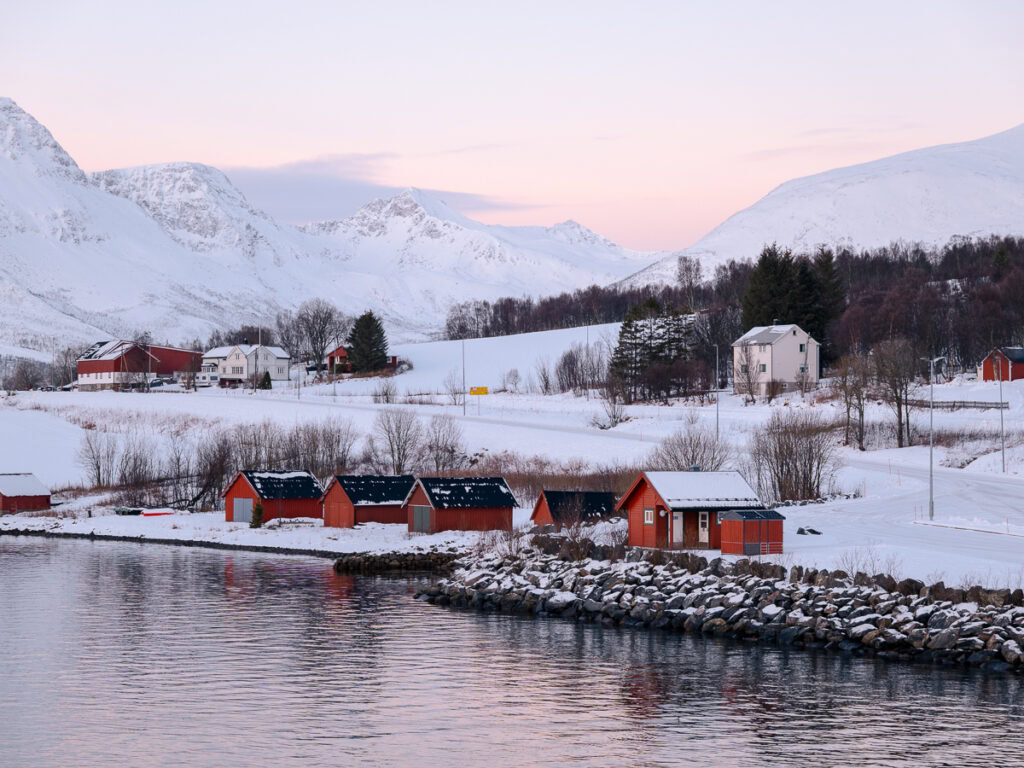
The panorama as as we departed Sortland was pure magic, with unforgiving mountains spiking up through thick snow and dwarfing tiny huts along the coastline.
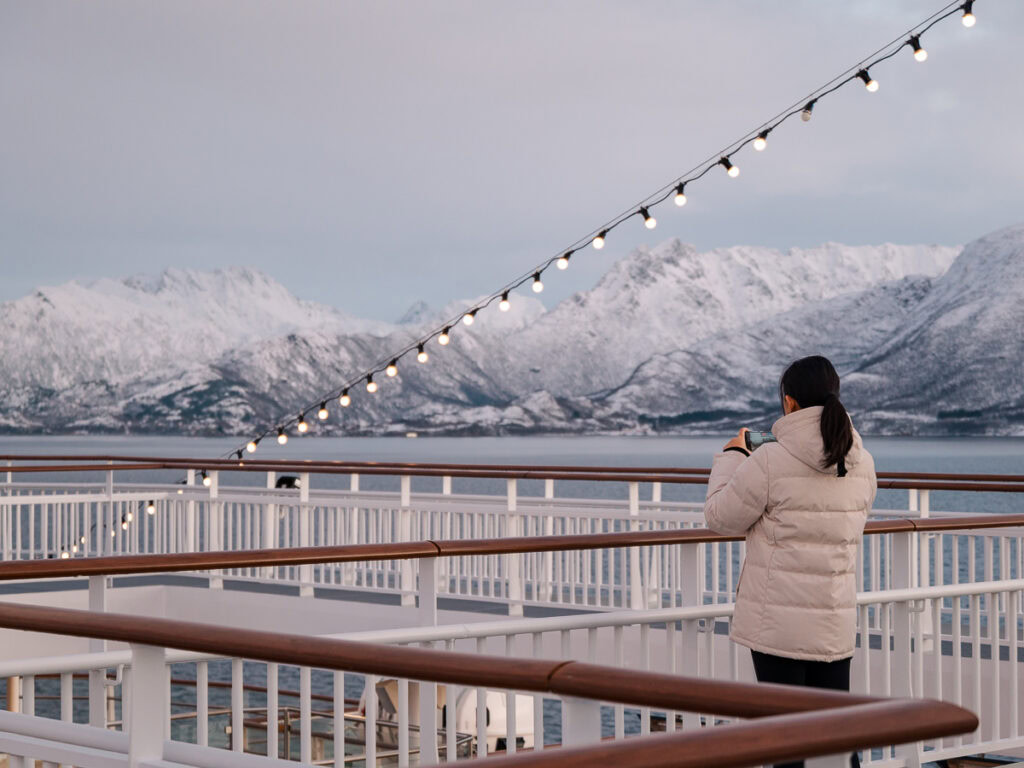
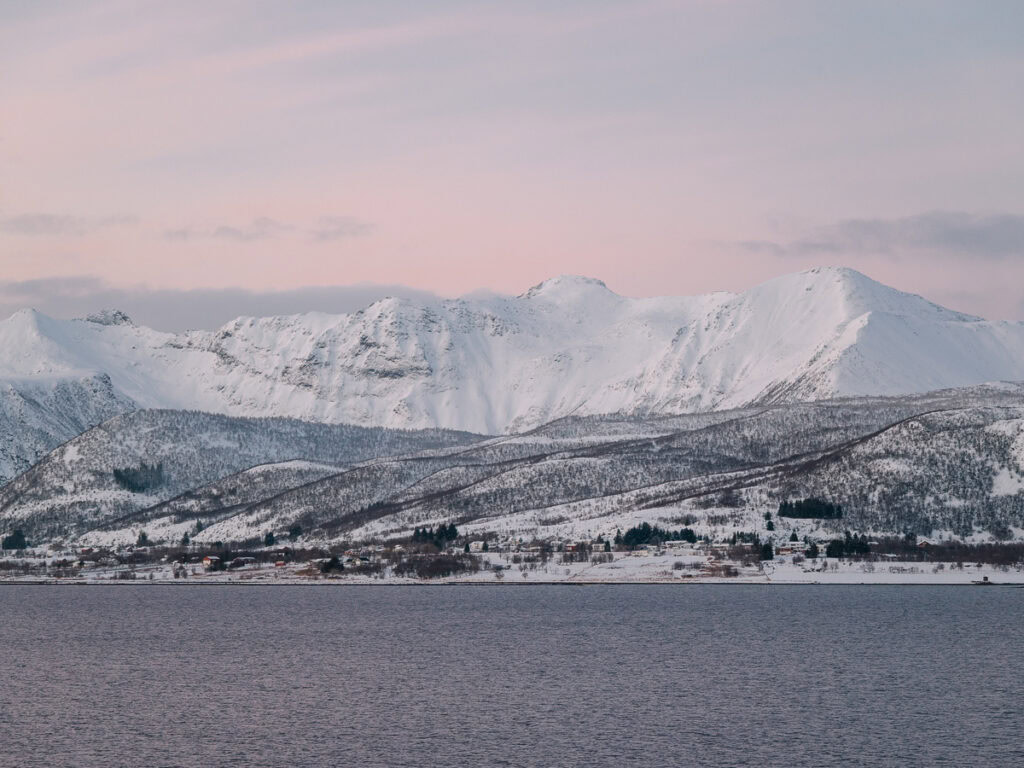
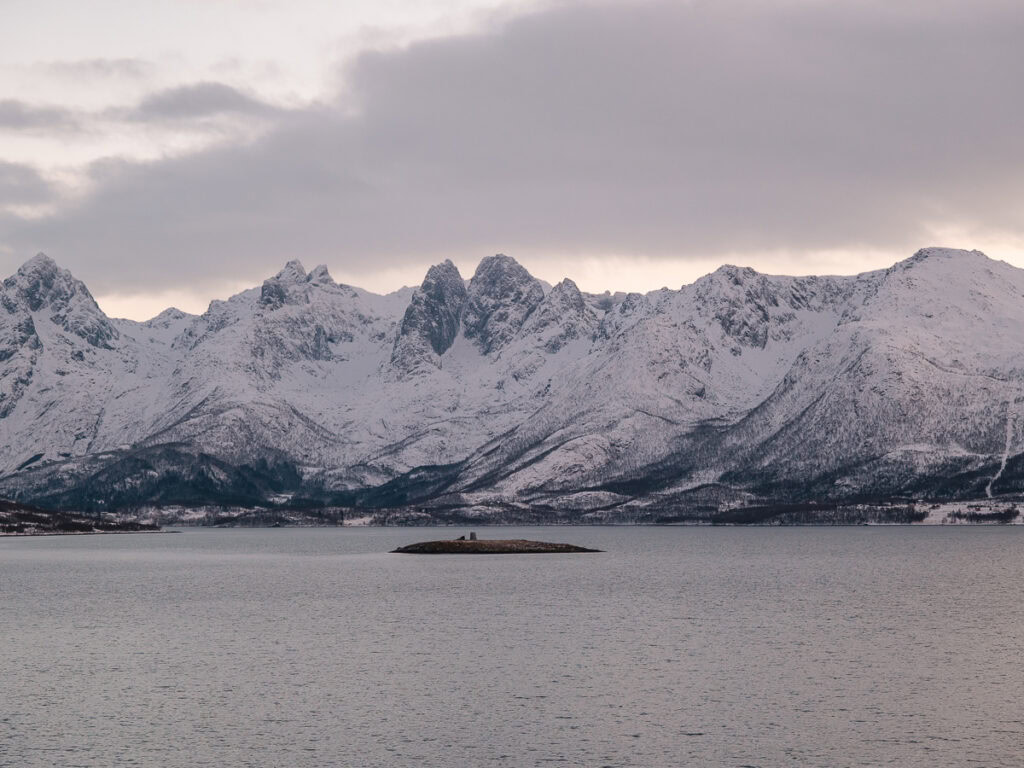
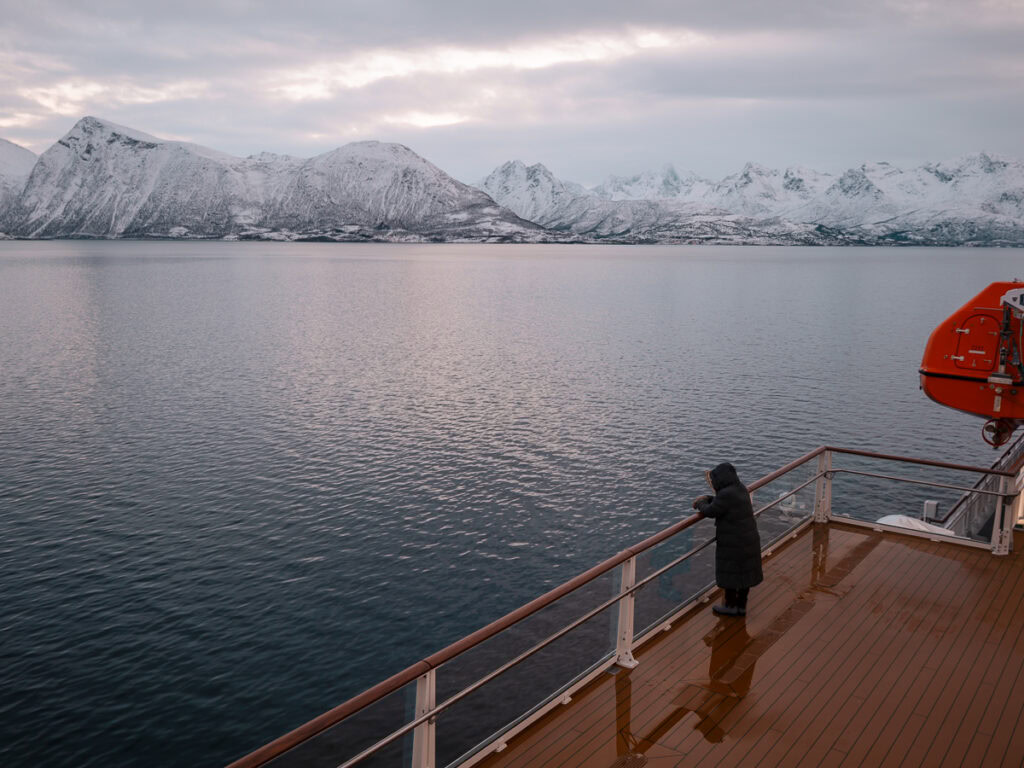
In the late afternoon an alert went out over the phones to say that we were about to enter Trollfjord, a natural marvel with rugged 1100 metre peaks towering above the narrowest point of the fjord, only 100m wide. Pretty impressive to take our ship in there!
It was 5pm and pitch black for us at the end of November, but this experience is a highlight of the cruise in the summer months where you can enjoy the scale of the scenery.

Later in the evening we were crossing paths with another Havila ship heading north, which we marked by having a flag-waving competition with a soundtrack of very loud Norwegian tunes to drown out the wind.

And to finish up a fantastic day, I had my last aurora sighting for the trip! It was super, super cloudy but the Lights were so strong that they shone through and lit up the whole sky, I can’t imagine how bright they would’ve been if it was a clear night.
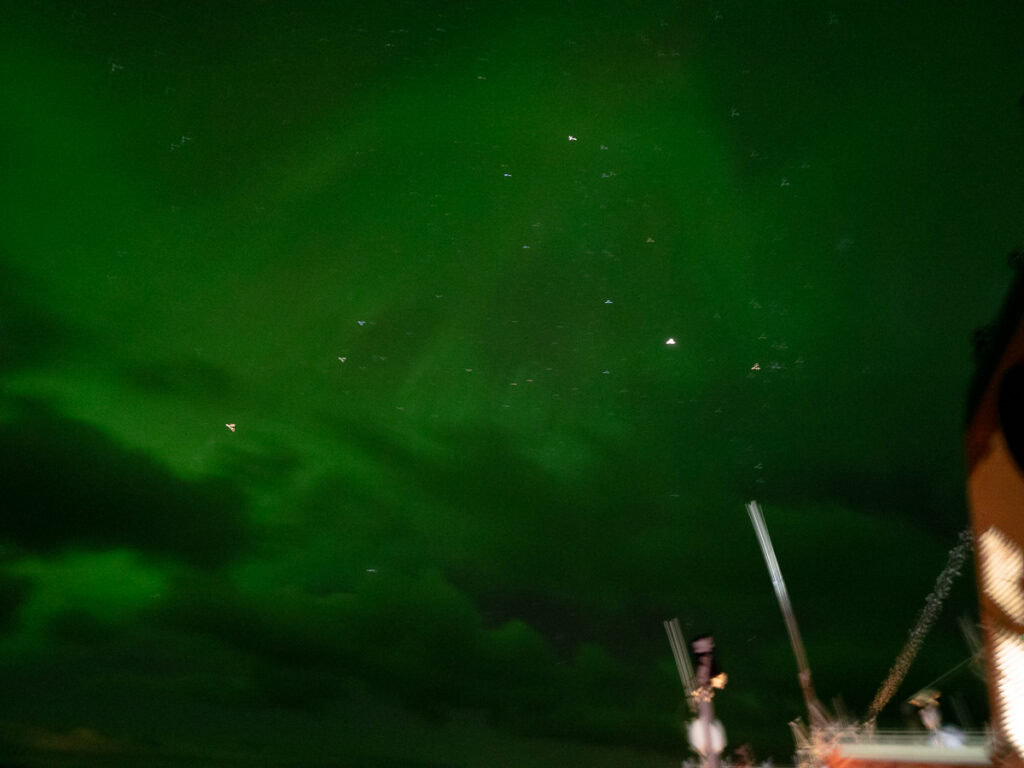
Day 10: Captain’s deck & fine dining
Day 10 took us back across the Arctic Circle, with a few short stops during the day and then 2.5 hours in Brønnøysund from 3pm to 5.25pm.
There’s a Torghatten winter hike excursion available from November to March but by 3pm it was pretty much dark so I decided it wouldn’t be worth the effort. Instead I joined a tour through the captain’s deck which was really cool, so many screens, buttons, computers and keyboards!
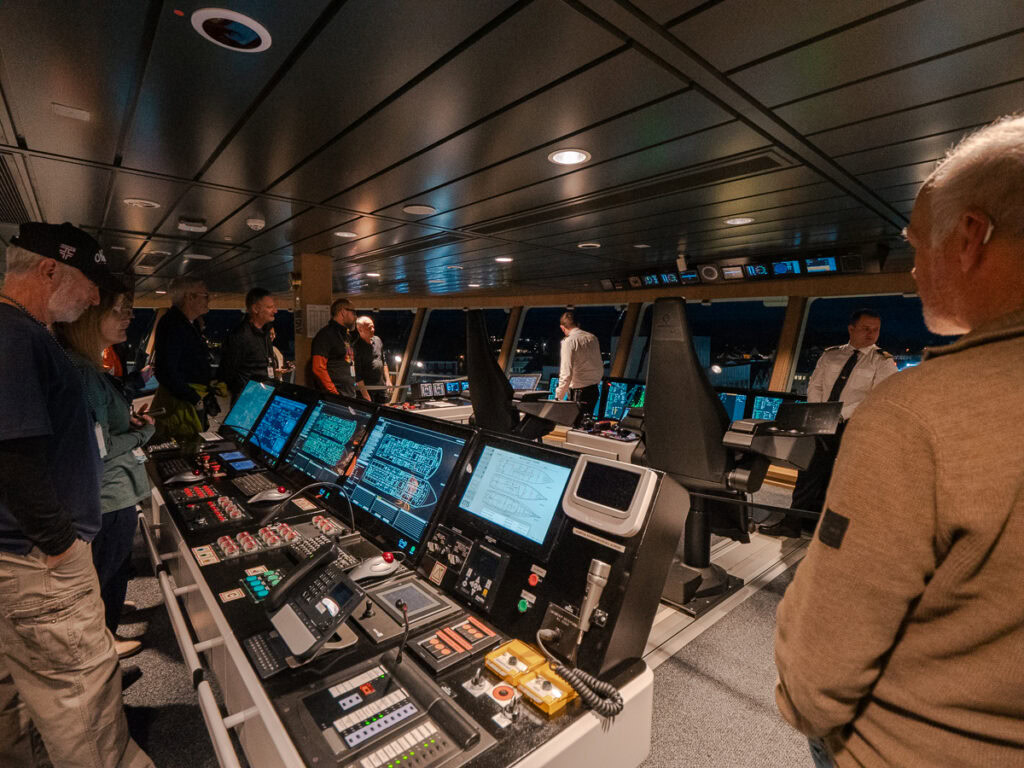
I popped out to a supermarket to stock up on snacks for my travel day the following day, then I swapped snow gear for formalwear because it was time for my booking at Hildring fine dining restaurant.
The land-based six course menu was divine, and it included Norwegian beef tenderloin, Lofoten cod with crayfish stock, Norwegian farm duck, Finnmark reindeer, chocolate terrin with sea buckthorn jelly, and dark chocolate. The service in Hildring was faultless, you definitely need to do at least one night here during your cruise.




Day 11: End of my cruise in Trondheim & onto Oslo
And just like that, my Havila Voyage came to an end!
I finished my trip in Trondheim, with time to have breakfast on the ship before checking out of my room and making my way to the train station, waving goodbye to Havila Castor as she departed for the final stretch back down to Bergen.
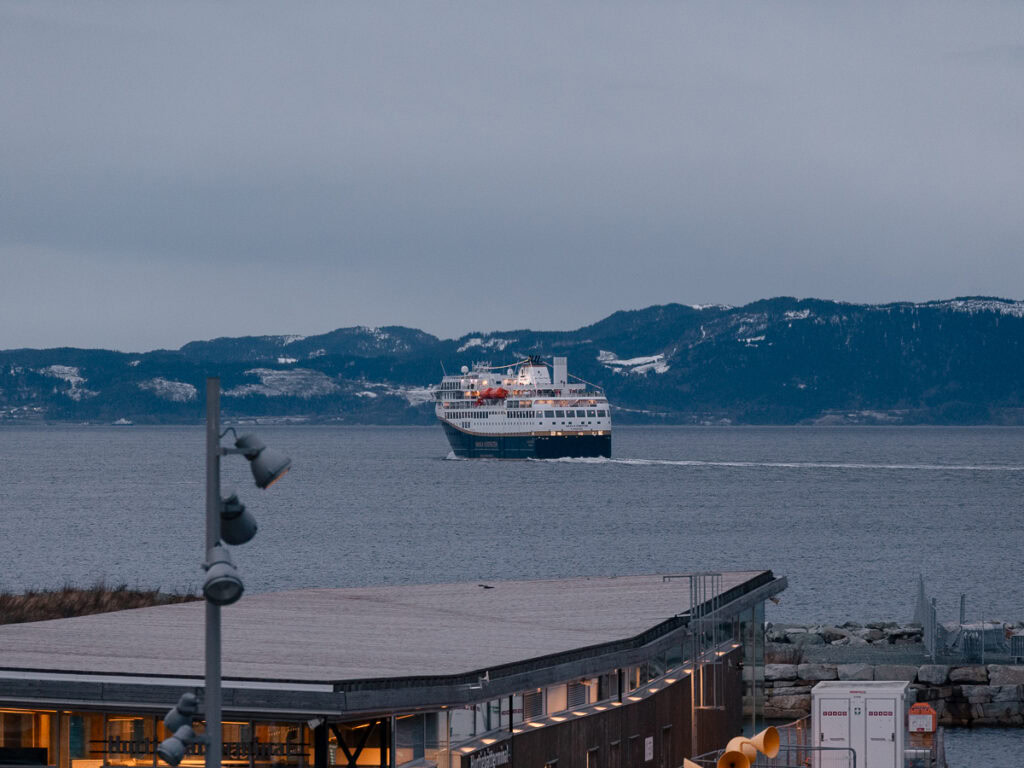
The Trondheim to Oslo train journey is a scenic journey in itself, passing by perfectly still lakes and snow-drowned forests on the seven hour trip. My seat was covered by my 1st class Eurail Pass and my seat reservation was free.
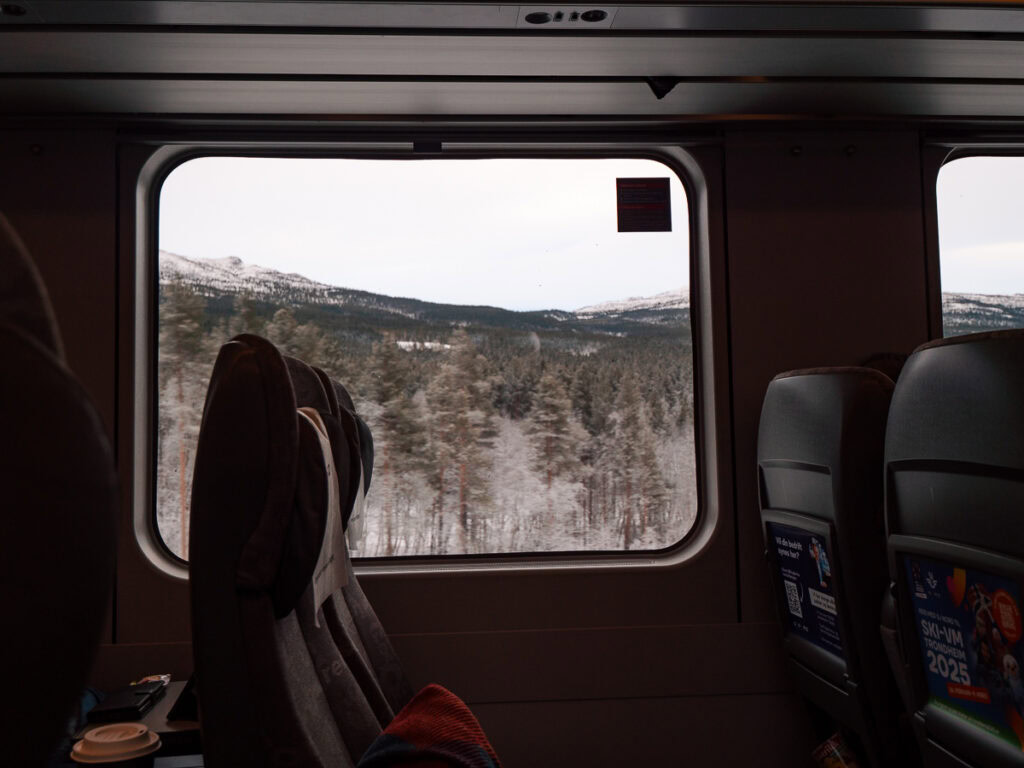
From Oslo train station I walked to my self-contained studio at Att Kvadraturen which was ideal for a short stay in the city, with a full kitchen, modern and comfy interiors, laundry facilities and cosy bathrobes. The location was unbeatable, six minutes’ walk from Karl Johans gate, eight minutes to the train station using the tram or 12 minutes by foot.
A delicious breakfast was included too, with healthy juices and pastries to take away if you’re going exploring.
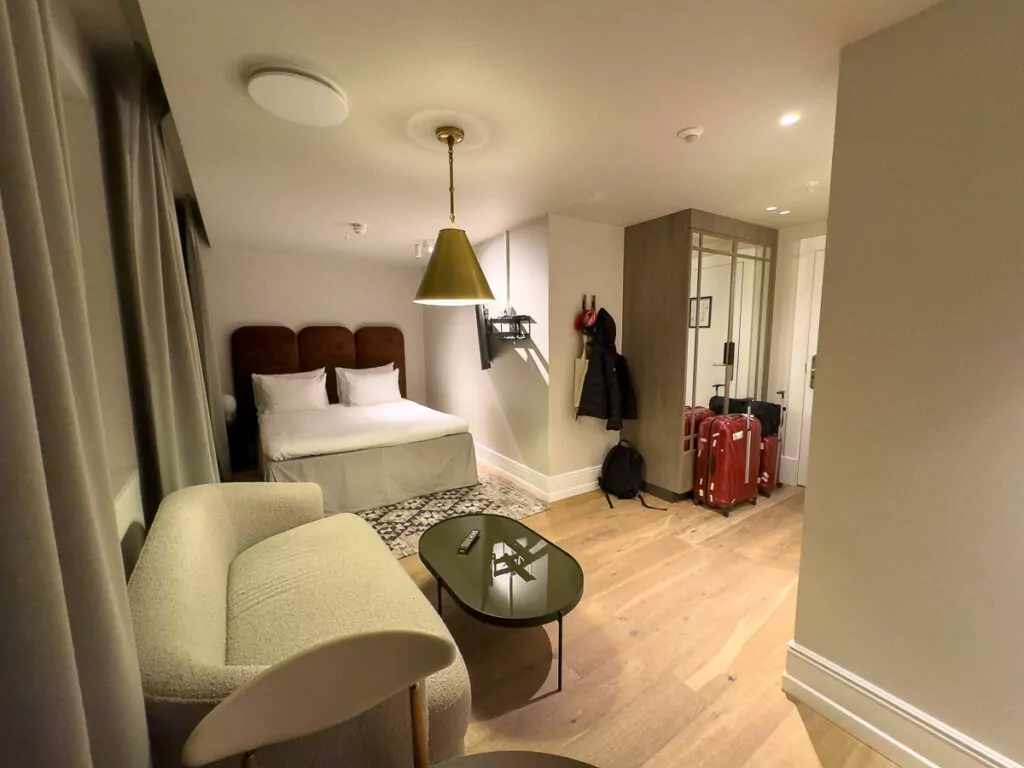
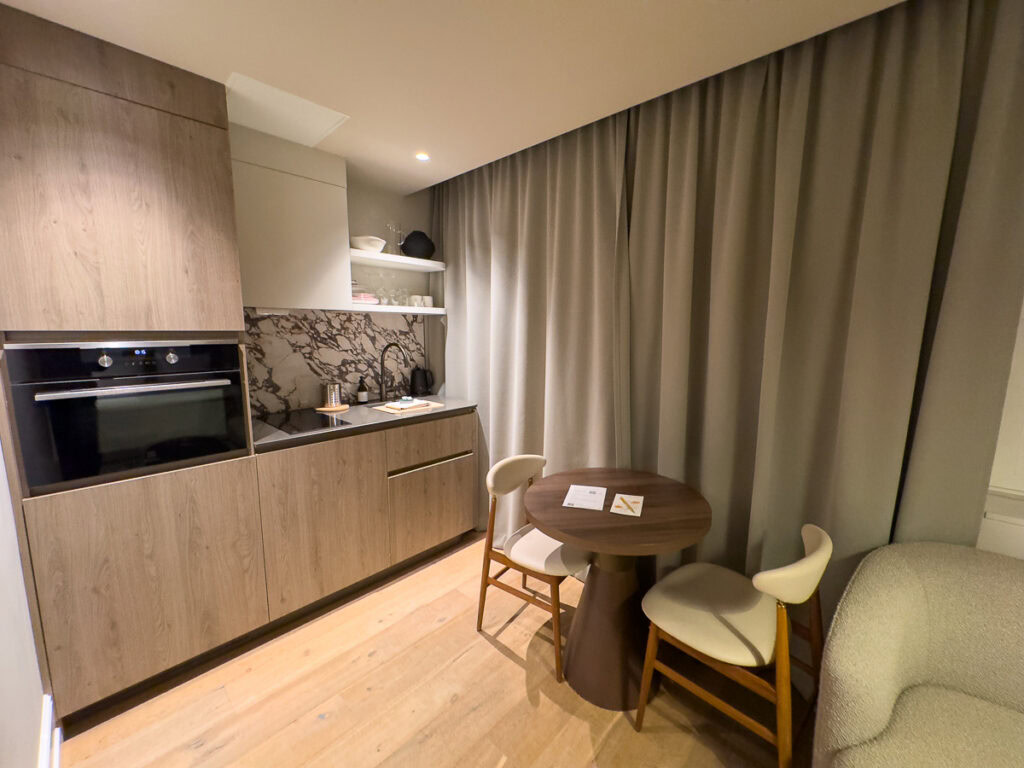
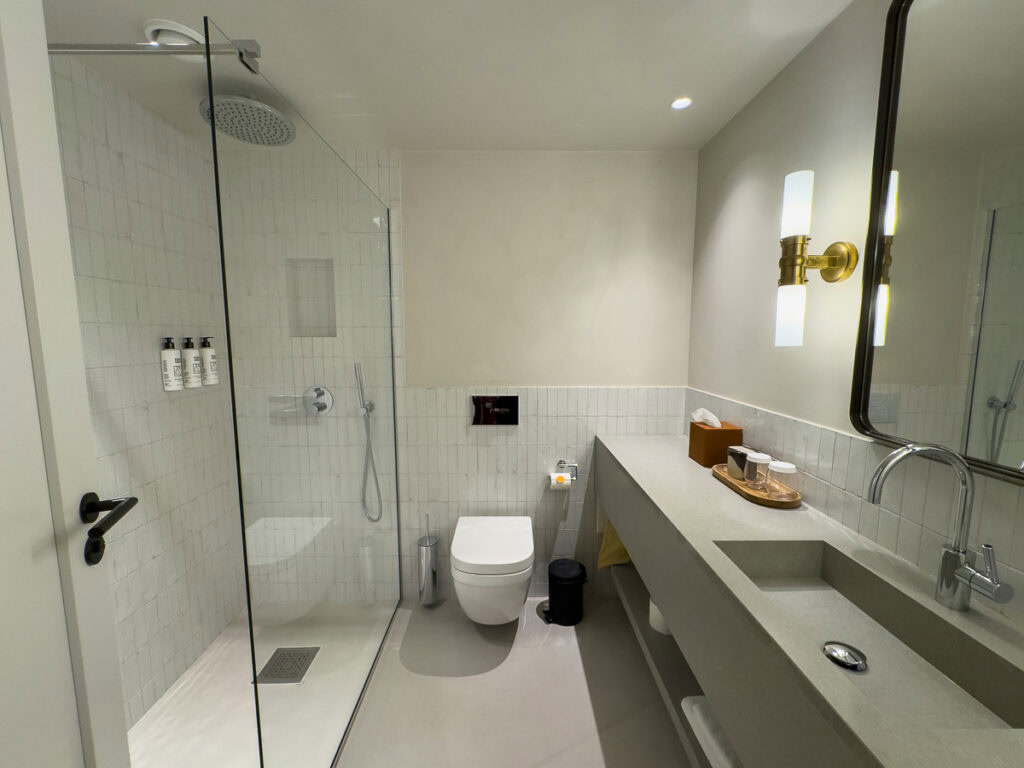
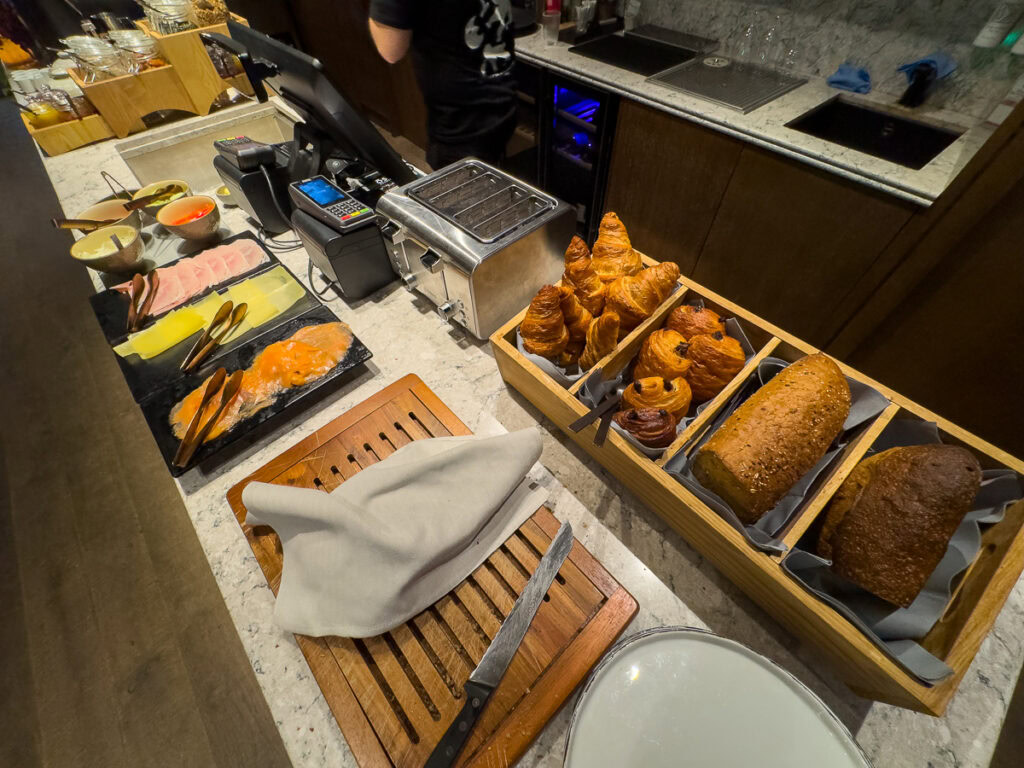
My last full day in Oslo marked the final day of my three months in Europe without flying, woohoo! I had hoped to make my way to London using trains but I had a medical appointment which I couldn’t move and it was going to take four days minimum for the overland route, so I had to bite the bullet and fly from Oslo to get there in time. I was stoked to have completed my self-set challenge though!
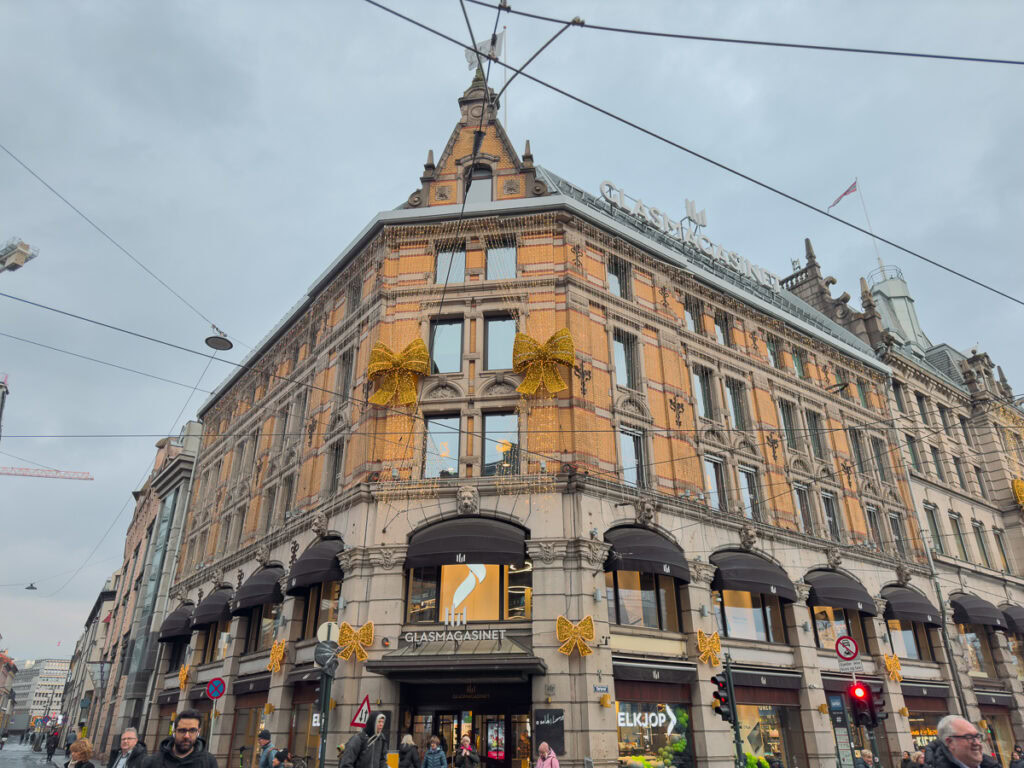
Norwegian Coastal Express & Havila FAQs
Can solo travellers book a Havila cruise?
Solo travellers can absolutely sail with Havila, and they often have solo traveller deals to give you discounted rates vs. paying for a two person booking. You can see any current specials here.
Can kids come on a Havila cruise?
Children are allowed on Havila Voyages, but these ships are not made with children in mind like many traditional cruise ships. There’s a very small play area inside one of the lounges but there’s no other entertainment, if your kids are fine just reading and sightseeing then you’ll be okay, but if they get bored easily then it might not be right for you.
On our cruise there was one super chill toddler (who got a lot of attention!) but I saw no other kids the whole 11 days I was on the ship.
Will I see the Northern Lights on a Havila cruise?
Nothing is ever guaranteed, but if you’re travelling above the Arctic Circle in the darker months then the chances are very high.
Havila even has a Northern Lights Promise, where if you don’t see the aurora on your Round Voyage from October to March, they’ll give you a Voyage North or Voyage South for free!

Will I get seasick on a cruise in Norway?
The Norwegian Coastal Route does have some exposed sections where you’re at the mercy of open sea conditions, so if you are prone to seasickness you should bring medication.
If swells are too intense for the ships to handle comfortably and safely then sailings will be cancelled or delayed until weather clears.
What entertainment is there on the Havila ships?
Not much! This is not your typical giant cruise ship with various performances and activities on board, it’s more of a sightseeing-by-sea experience where the entertainment is the scenery.
Do the Havila ships have WiFi?
There’s WiFi on the ships and it’s included in your booking with no extra costs. The WiFi can be intermittent in the more remote areas and it’s not fast enough for big downloads or heavy streaming, so you should download a bunch of shows prior to departure or get a cheap eSIM.
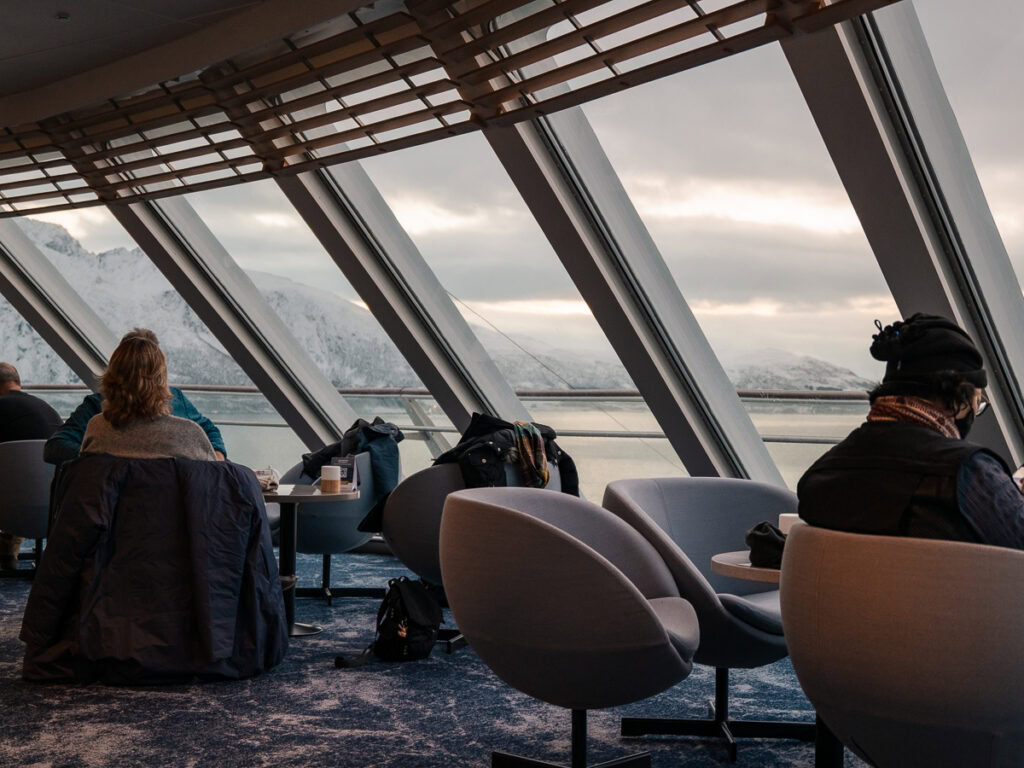
Do I need cash for the ship?
You don’t need cash for a Havila cruise, you can pay by card at the café, souvenir shop or to settle your bill at the end.
What should I pack for a Havila cruise in Norway?
Norwegian weather can be temperamental year-round so you’ll always need warm clothes and thermal layers, wind and waterproof outer-clothes, and sturdy walking shoes. Take swimwear for the jacuzzi, activewear if you’re planning on hiking or using the gym, and comfy loungewear for on the boat.
As with any trip you’ll want to bring medicine, your camera, a portable charger, toiletries (they can be very expensive in remote towns along the way) and entertainment for the long travel days like a book, Kindle or iPad loaded with shows.
How do I book Havila excursions?
You can book excursions at the time of booking your cabin, through the MyVoyage portal before your trip, or on board with the Excursions team.
Apparently excursions are cheaper through MyVoyage prior to the trip vs. when you’re on board but I couldn’t log in to MyVoyage at all (and customer service never got back to me about this) so I couldn’t check this.
Some excursions do get booked up though so I’d recommend booking as soon as you get on board if you haven’t already.
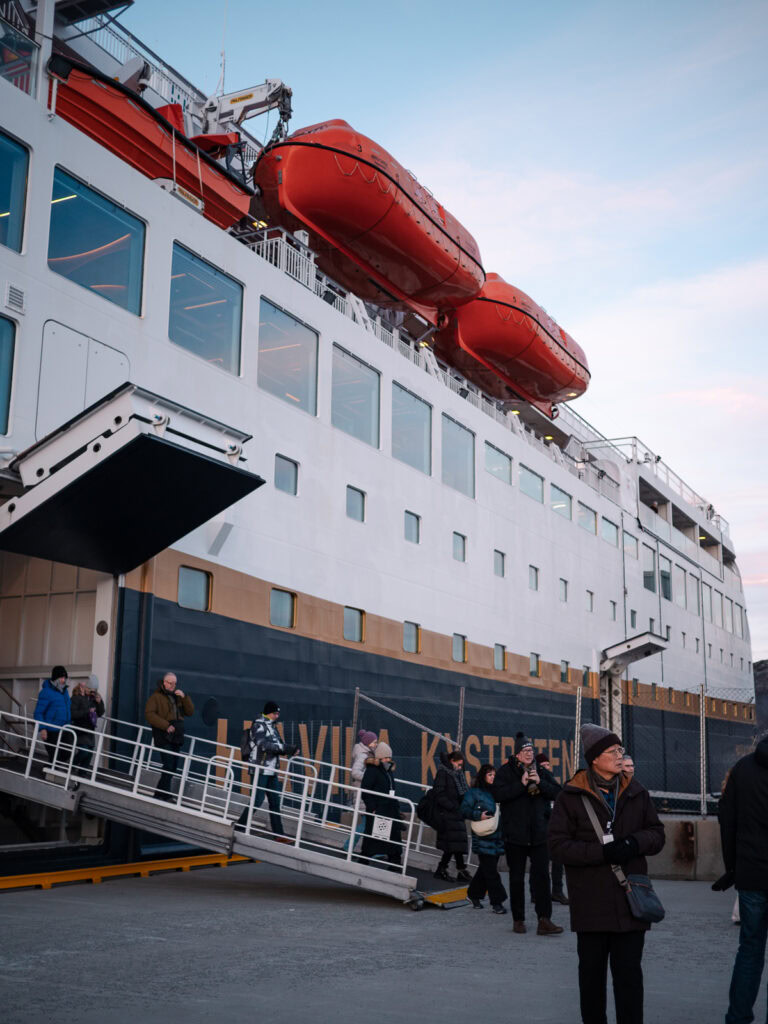
Why is Havila better than traditional cruise lines?
Havila Voyages is one of the most sustainable cruise companies in the world, with genuine commitment to eco-friendly practices compared to the ridiculous level of greenwashing you’ll see from most big cruise companies. They can currently run emissions-free for four hours, and have been future-proofed to be able to use hydrogen for zero-emissions sailing at all times once it’s approved for passenger ships.
Havila’s four identical ships are all modern, from 2021-2023, with pared back, minimalist interiors, comfortable furnishings and spacious relaxation areas for an intimate experience with a maximum of 640 passengers, vs. mega ships of thousands of people.
Do I need travel insurance for a cruise?
Travel insurance is a requirement for Havila Voyages passengers, like most cruises. Read my guides on how to choose the best travel insurance policy and when travel insurance is worth it.
What’s the best eSIM for Norway?
Mobimatter has the cheapest eSIMs I could find for Norway, their Europe eSIMs include Norway and 41 other countries from as little as €0.78-0.87 per GB for 15-60GB options.
To quickly compare, Airalo’s best value Norway eSIM is €1.52 per GB, Saily’s best value option is €1.25 per GB, and Holafly is €3.32 per day for a 12 day unlimited eSIM (unnecessary when the ship has WiFi).
Can I bring my own snacks and drinks on board the Havila ship?
You can bring snacks and non-alcoholic drinks on board (and I’d recommend doing so!), but you can’t bring your own alcohol on board.
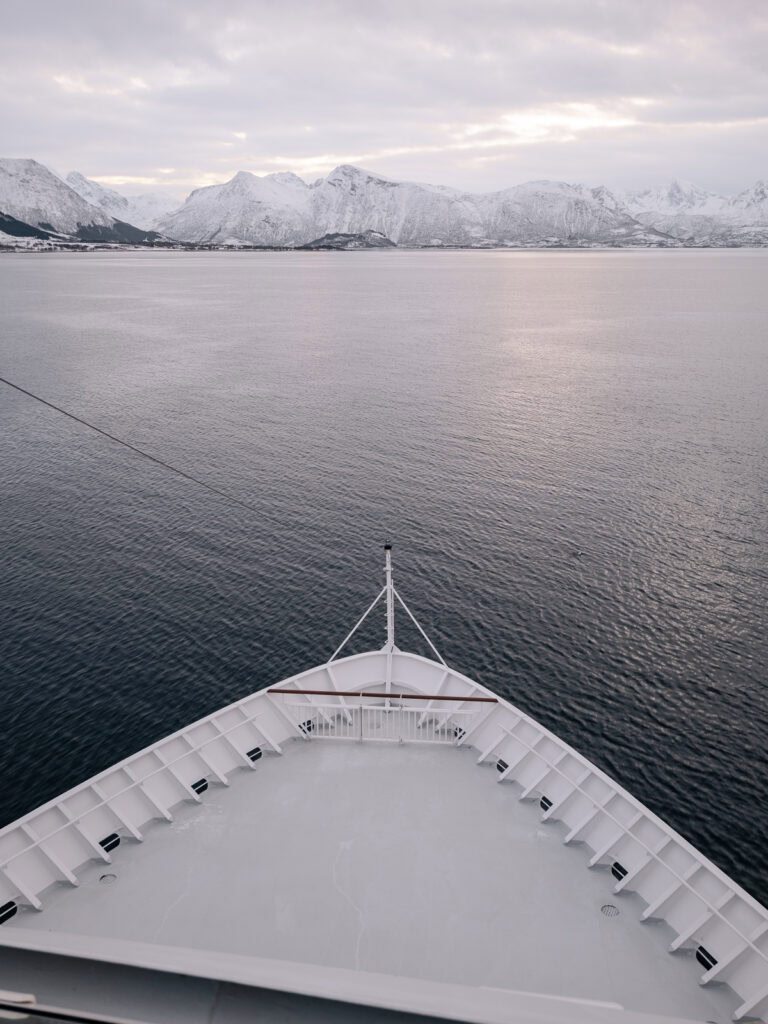
As I watched the Havila Castor sail away from the port in Trondheim after 11 days of spectacular scenery and Arctic adventures, I realised that sustainable cruising isn’t such an oxymoron after all.
While multinational cruise giants greenwash their sustainability stats and make vague promises about net zero by 2050 (too little, too late!), Havila Voyages is already walking the talk, with battery-powered sailing through sensitive areas today and concrete plans for cutting all emissions by 2030. Add in their focus on reducing food waste and supporting local communities, and you’ve got a glimpse of what the future of cruising should look like.
The Norwegian Coastal Express with Havila Voyages isn’t going to suit everyone, if you’re looking for never-ending buffets, mega waterslides or 24/7 entertainment then I can tell you now you’ll be sorely disappointed.
But if your idea of the ultimate travel experience includes seeing untouched natural wonders without the crowds, floating past tiny towns you’ve never heard of, cuddling baby huskies, and watching the Northern Lights dance above you, a cruise with Havila Voyages is right up your alley.
My best advice? If you’re thinking about ticking the Norwegian Coastal Route off your bucket list, do it sooner rather than later. As more travellers prioritise sustainable options, these ships will get busier and more expensive. Be an early adopter of sustainable cruising and experience the magic of Norway’s coast with a local operator who truly cares about the places they sail.
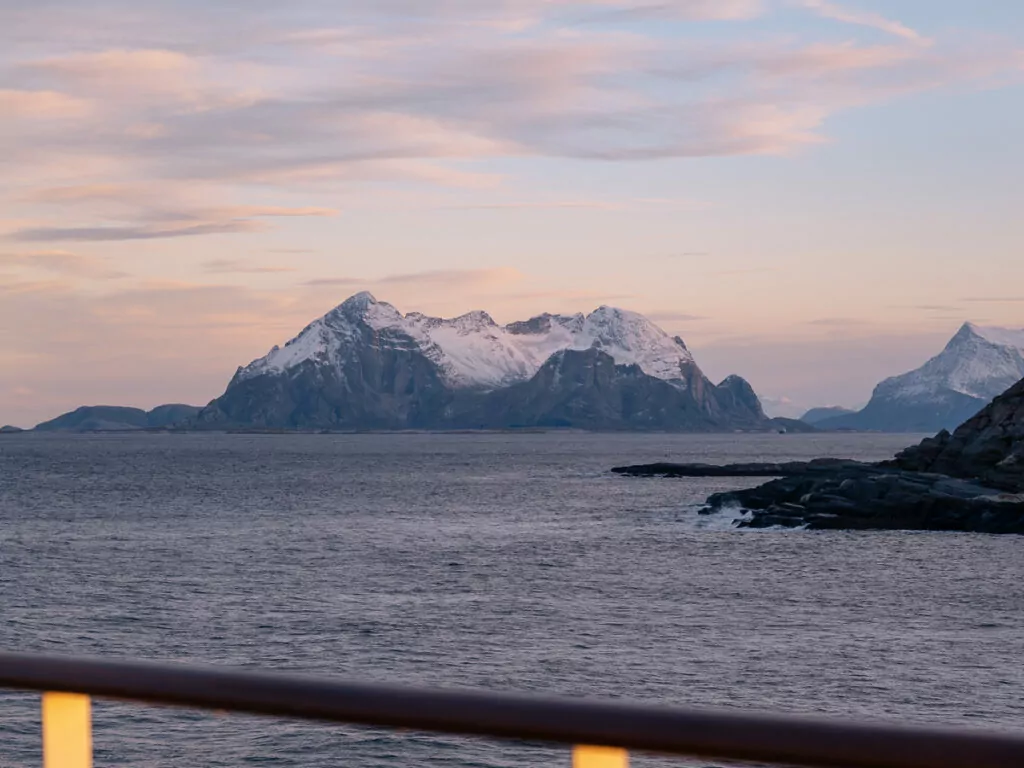
MORE NORWAY TRAVEL GUIDES:
- The ultimate two week Norway itinerary
- The perfect four day itinerary for a quick Norway trip
- How to spend three epic weeks in Scandinavia by train
- The ultimate three month Europe itinerary
MORE BUCKET LIST EXPERIENCES
- Barge cruising in Burgundy, France
- Island hopping in the Ionian Islands, Greece
- Scuba diving on the world’s only dive rig in Malaysian Borneo
- Capella luxury cruise in Halong Bay, Vietnam
- The best glamping spots in New Zealand
- The most beautiful train journeys in Europe
MY GO-TO TRAVEL PLANNING RESOURCES
Flights ✈️ I use Skyscanner to find the best flights for my trip and then I’ll always book direct with the airline to protect myself from having to deal with dodgy third parties if anything goes wrong.
Trains 🚂 If I’m travelling through Europe, I try to travel by train wherever possible! For an extended trip (2+ weeks) I’ll calculate if a Eurail Pass is worth it, or I’ll book point-to-point tickets through RailEurope or the local train operator.
Accommodation 🛎️ I book almost all of my accommodation through booking.com, they have a user-friendly website + app and many of their options are free cancellation, easily cancelled with a simple click of a button.
Activities 🗽I use GetYourGuide, Klook and Viator to look for activities in the places I visit, or I just Google ‘things to do in [city]’! P.S. If you book anything on Klook you can use the promocode FINDINGALEXXKLOOK to get 10% off
Travel cards 💳 I’m a Wise gal through and through, they’ve been my chosen travel card for more than five years now. You can easily top up your card from your bank account or through Apple Pay, convert your money to local currency, and spend money with minimal fees and the best exchange rates around.
Travel insurance 🩺 I use Cover-More NZ travel insurance for my own trips, I have a comprehensive policy and I’ve only had good experiences with them. Cover-More also has an Australian company, but if you’re from elsewhere then two popular insurance options for global travellers are SafetyWing (cheaper policy, lower coverage) and World Nomads (more expensive but significantly better coverage).
Luggage 💼 I travel with Samsonite Cosmolite suitcases, one 75cm check in bag and a 55cm carry on bag, and I absolutely adore them and will never travel with anything else! They are SUPER lightweight (2.8kg and 1.9kg respectively) so I have much more space for my actual stuff.
Camera gear 📸 I use a iPhone 15 Pro Max for phone photos/videos, and my camera kit includes a Lumix S9 (incredible lightweight full-frame camera, a game changer for travel creators!) with a 20-60mm lens, a Lumix G9 with an 8-18mm and 12-60mm lens, a DJI Mini 3 Pro drone and a GoPro Hero 10. I do all my writing and editing on my ASUS Zenbook 14, it’s lightweight but powerful enough for photo editing and intense blogging sessions.

Your posting was very helpful and enjoyable. We will be on a Havila voyage in November. I use a powered mobility chair and can walk short distances with a cane. I have found nothing about handicapped problems. Can the chair be used on excursions or is there too much snow.? Any suggestions would be appreciated.
You would need to check with the Havila team, the whole ship is accessible with wheelchair-friendly cabins available but for the excursions it would depend on each one, some are just city tours but some require bus/boat transport. You can find info here: https://www.havilavoyages.com/faq/accessibility
And for any further questions just email the Havila team!
We found you review very informative and enjoyable. We will be on a havilla cruise in November I use a powered mobility chair and can walk short distances with a cane. I have found nothing helpful advice about the excursions for handicapped people. Is there too much snow for the chair to be used.? Walking in snow may be difficult and dangerous for me.
Any suggestions would be appreciated.
I’m not sure how much snow is too much snow for a mobility chair so I can’t confirm this sorry! We went late November and there was lots of snow on the ground from the Lofoten Islands and above, but at the more southern stops the snow was melting rather than accumulating. Best to check with the Havila team for their advice!
Hola Alexx!
He leído con mucho interés lo que publicaste acerca de Havila. Quiero hacer el crucero en julio de 2026.
Somos dos personas de 72 años. Qué edad tienen tus padres? Recomiendas este crucero para gente mayor viajando en la misma cabina que utilizaste vos?
Relataste relativamente pocos defectos. Realmente no hay mucho para criticar ? Te agradeceré inmensamente la respuesta.
Un saludo afectuoso. Dany
Hi Dany! My parents are in their early 60s but the cruise would be totally fine for travellers in their 70s, if you have any additional accessibility needs there are accessible cabins available too. Truly not much to criticise from my perspective, it exceeded my expectations on almost all aspects! The food wasn’t the best I’ve ever had while travelling but Norwegian cuisine is not my personal preference and I appreciate their limitations due to supply and sustainability (much better than having fast food available with ridiculous wastage like most cruise ships) and the excursions were pricey, but that’s to be expected in this part of the world and no other cruise would be different. Overall I absolutely loved it and so did my parents 🙂